





























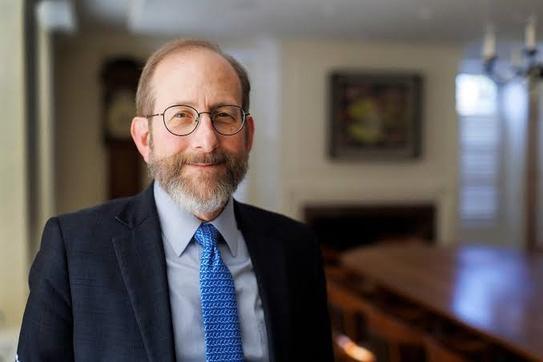
In recent years, Harvard University has expanded its engagement with Brazil in remarkable and meaningful ways. Today, the University stands as one of the world’s leading academic institutions for Brazil studies, which is a testament to a strategic, long-term investment in scholarly partnership and unique opportunities for students. This progress would not have been possible without the thoughtful generosity of Jorge Paulo Lemann AB ’61 and the Lemann Foundation. We are proud of what our collaboration has achieved over the last decade—and we are excited about what the future holds.
Alan M. Garber President Harvard University
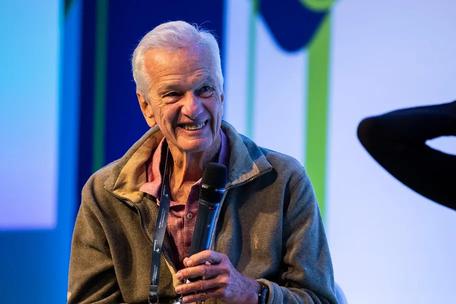
Jorge Paulo Lemann Chairman
Lemann Foundation
I'm pleased to see how the Fund has brought together so many remarkable scholars from Harvard and Brazil in a spirit of genuine collaboration, dialogue, and shared purpose strengthening the ties between researchers, policymakers, practitioners, and the broader public. This rich exchange of experiences and the engagement with diverse worldviews deepen our understanding of the challenges we face. The combination of academic excellence and real-world engagement reflects what we value most, as it creates the conditions for talented individuals to innovate and tackle complex social challenges in pursuit of a more developed and promising future.

Denis Mizne CEO
Lemann Foundation
At the Lemann Foundation, we firmly believe that universities play a vital role in fostering informed public debate and preparing the next generation of leaders. That’s why we are so proud of the impact of the Lemann Brazil Research Fund at Harvard The Fund has not only advanced the frontiers of knowledge on Brazil’s most pressing challenges, but also enabled deep academic collaboration between Harvard faculty and 173 leading Brazilian co-investigators and collaborators, representing over 70 institutions across 26 states. In doing so, it helps bring us closer to our vision of making Brazil a more just and equitable place for all.
Paulo Lemann AB ‘61 and the Lemann Foundation
Global entrepreneur and financier Jorge Paulo Lemann regards improving access to education as Brazil’s most important challenge He received a bachelor of arts in economics from Harvard College in 1961. He is the founder and chair of the Lemann Foundation, a notfor-profit family organization founded in 2002. The foundation works to ensure that all Brazilian children have high-quality public education and to create a network of talented people dedicated to solving the main social problems in Brazil.
The Lemann Brazil Research Fund (LBRF) at Harvard University is made possible by a generous gift from the Lemann Foundation. The Office of the Vice Provost for Research administers the Fund together with the Office of the Vice Provost for International Affairs, in collaboration with the David Rockefeller Center for Latin American Studies through the Brazil Studies Program and the Brazil Office.
The Fund is intended to foster collaboration between scholars and to support research projects focused on current issues facing Brazil Proposals are submitted by a Harvard faculty member with principal investigator rights at their School and must meet at least one of the following three criteria, with priority given to those projects that meet more than one criterion:
Focus on Brazil; Include meaningful collaboration with Brazilian academics; and Be undertaken in Brazil in whole or in part.
Proposals are evaluated by a faculty committee on the basis of academic merit, feasibility, and their anticipated advancement of the objectives of the Fund. (��Learn more about the LBRF)
This report provides an overview of the Fund’s impact on Harvard and, more importantly, in Brazil, over the past 10 years.
The intended audience of this report is broad, ranging from students at Harvard who are interested in learning more about Brazil to policymakers and practitioners in Brazil who are looking for knowledge and experts that may inform their actions. Accordingly, the text is presented in a simple and straightforward style. Links to media and publications are provided for the readers who intend to delve deeper into projects.
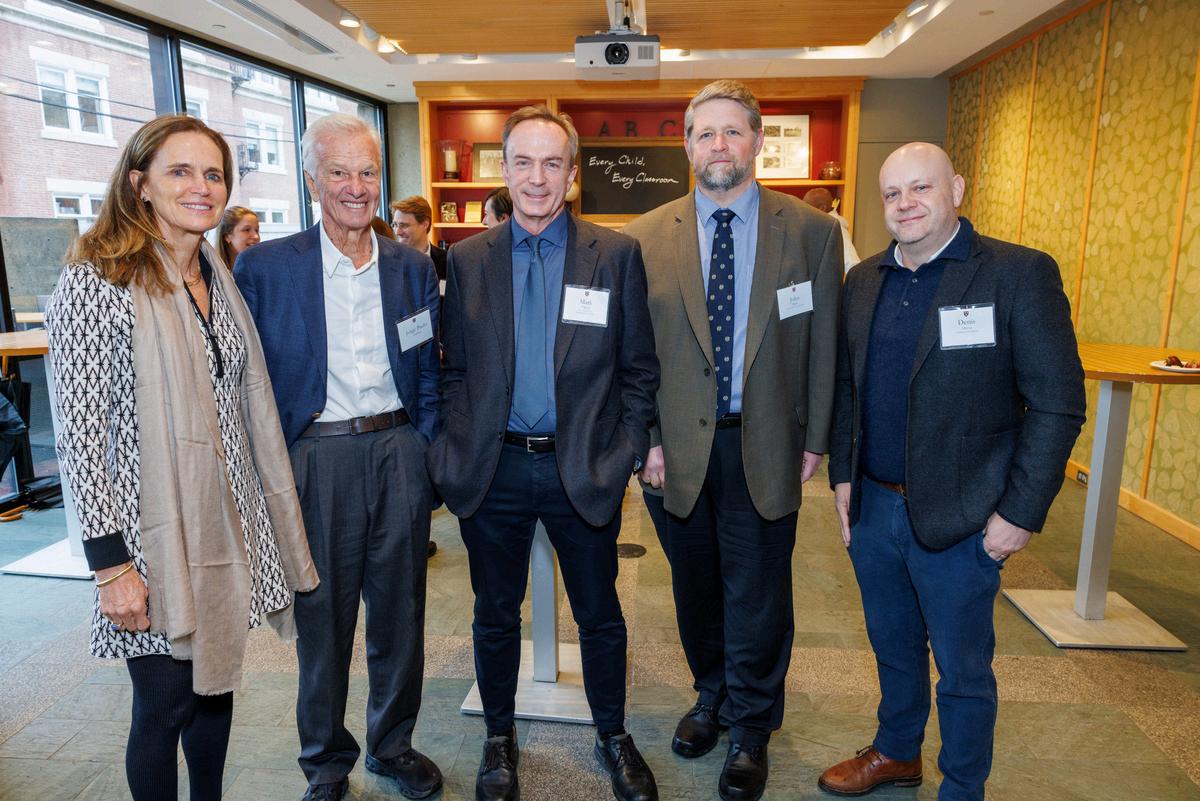
The following chapters will demonstrate how the Fund has made significant impacts in many dimensions, including:
Generating knowledge that matters for Brazil and beyond; Attracting talented scholars and students to work with Brazil; Fostering collaboration with some of Brazil’s best and brightest; Building capacity of researchers, policymakers, and practitioners; Providing transformational student opportunities; Promoting public engagement and cooperation across sectors; and Informing decisions that impact policies, services, and people.
Enjoy learning more about the important work supported by the Fund!
Researchers and students analyze maps during field course in Brazil supported by the














Researchers from Harvard and from prominent institutions throughout Brazil have worked together over the past decade to develop and implement cuttingedge projects across disciplines and throughout Brazil’s diverse territory.
Over the past 10 years, the Lemann Brazil Research Fund has successfully mobilized an impressive cadre of researchers and collaborators to pursue questions that matter, especially for Brazil. The following numbers and map provide a big-picture overview:
228
913 Proposals
have been received, including
Primary Investigators, Co-Investigators and Collaborators written into the proposals
271 63 58 9
Awards have been made, enabling work by
Primary Investigators, Co-Investigators and Collaborators written into the proposals
having served as Primary Investigators, representing
Harvard Schools from across the University
Brazilian of awarded researchers and collaborators are
Institutions have collaborated on awarded projects, which have taken place in
all
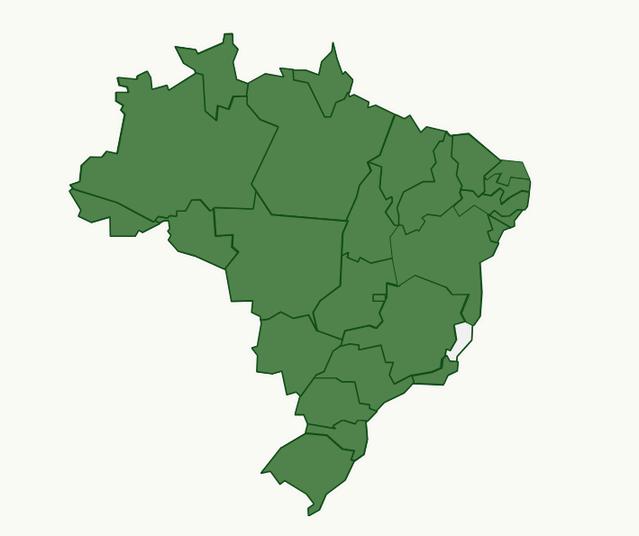
Above: States in Brazil where on-the-ground work of projects supported by the LBRF has taken place
Mark Elliott Vice Provost for International Affairs
It has been deeply rewarding to see how this Fund has become such a dynamic platform for meaningful collaboration between Harvard and Brazil. The idea of a major, University-wide research fund focused on a specific country hadn't been tested at Harvard prior to the Lemann Brazil Research Fund. It has now become a model for other, similar funds for different geographies. The scope, quality, and impact of the projects supported by this Fund are a testament to what long-term vision and commitment can achieve. The Lemann Fund has helped to make Brazil one of the countries with which Harvard is now most engaged.”
The following timeline provides a year-by-year look at some of the most symbolic moments for the Lemann Brazil Research Fund as a whole and for a sample of the collaborative projects that the Fund has enabled.
Mark Elliott, viceprovost for international affairs, announces the first cohort of Lemann Brazil Research Fund awardees while in São Paulo for the Harvard DRCLAS Brazil Office 10th anniversary.
Charles Nelson, Nathan Fox, and Julie Staples-Watson initiate EI-3 Project agreements and protocols with leadership and judges of the São Paulo Judicial branch at the Palácio da Justiça.
Primary investigators and research collaborators from the first three cohorts of Lemann Brazil Research Fund awards meet with Jorge Paulo and Susanna Lemann at Harvard
Flavio Calmon reveals some of the challenges and implications of machine learning for education and ethics at the Harvard Brazil Alumni Summit.
Katherine Merseth and Gabriela Moriconi launch their book Ensinando Futuros Professores: Experiências Formativas Inspiradoras through the Fundação Carlos Chagas
2023
Naomi Pierce and Scott Edwards lead a three-part webinar series, “Why Biodiversity Matters,” focusing on issues related to biodiversity in Brazil and featuring projects and researchers supported by the Fund.
Caroline Junqueira and Judy Lieberman’s research on unexpected causes of severe COVID-19 infections is published in Nature, the world’s leading multidisciplinary science journal.
Nadine Gaab meets with researchers and practitioners working with learning disabilities and language and literacy development at the Harvard Brazil Office following a public symposium in Brasília.
Universidade do Estado do Amazonas researchers demonstrate to Harvard students the water sampling protocols used to collect water samples that are analyzed for mercury at the Sunderland lab.
Awardees from the 2025 cohort meet at Harvard with Jorge Paulo and Susanna Lemann, vice provosts for research and international affairs, and previous awardees.
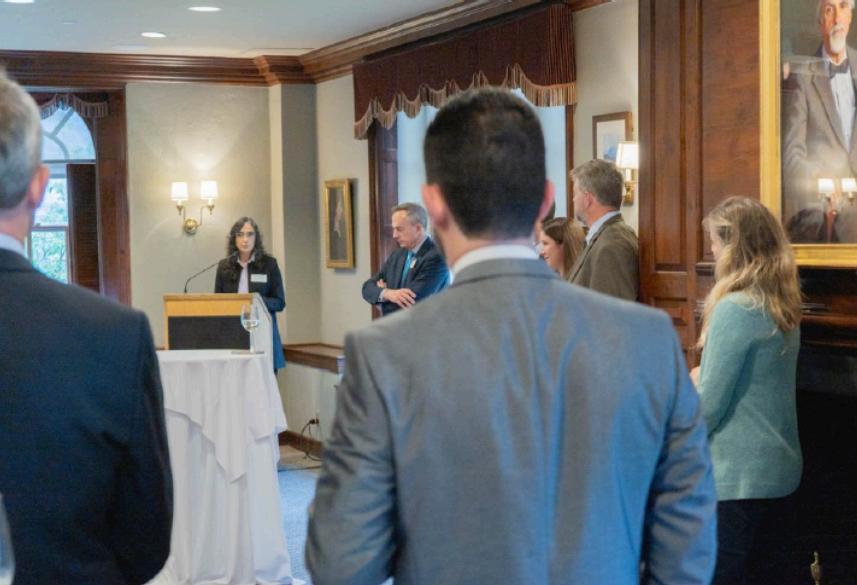












The Fund has dramatically increased the level of Harvard faculty interest in Brazil. Year after year, faculty from across Schools and disciplines, many of whom are working with Brazil for the first time, submit high-quality proposals. For some, the Fund is the spark that results in ongoing engagement with Brazil well beyond their original project proposal.
John Shaw
Vice Provost for Research
The Fund welcomes proposals submitted by Harvard faculty from all Schools and disciplines. It has become one of the main incentives for Harvard faculty to begin or continue working with Brazil The charts below demonstrate the success of the LBRF in connecting faculty from across Harvard with current issues in Brazil
Of the
...most have come from HSPH, FAS, HGSE, and HMS, followed by SEAS, HKS, GSD, HSDM, HBS and HLS. The only eligible School that has not applied is HDS.
the
...most have been made to FAS, HGSE, and HSPH, followed by SEAS, HMS, HKS, GSD, HBS and HSDM. All 9 Schools that have applied have received at least 1 award.
“This set of grants has greatly shaped my career trajectory. The project funded by these grants was my first major initiative as a Harvard faculty member, and my first experience working collaboratively in Brazil. Because of this early opportunity, I have gone on to lead or contribute to at least three other evaluations of educational programming in Brazil In addition, I have continued to work closely with Brazilian scholars on various aspects of my work. I have also hosted three visiting doctoral fellows from Brazil here at Harvard, and am currently working remotely to supervise a Brazilian postdoc.”
DANA MCCOY, Marie and Max Kargman Associate Professor of Human Development and Urban Education Advancement
“In the 1930s, MCZ curator A. S. Romer sent his Brazilian-born assistant Lewellyn Price to Brazil to scout for fossils. Price known as the ‘grandfather’ of Brazilian paleontology found a treasure trove of fossils that pinpointed Brazil as an epicenter for paleontological research. Almost a century later, the Lemann funding gave me the opportunity to build a new bridge between Harvard and Brazilian paleontology, this time from the perspective of collaboration and empowerment, not colonialism The project supported Brazilian-based postdocs and students, community educational outreach, and the digitization of fossil museum collections, helping to increase the accessibility of Brazil’s paleontological resources and enhance research opportunities.”
STEPHANIE PIERCE, Professor of Organismic and Evolutionary Biology; MCZ Curator of Vertebrate Paleontology
“This project has enabled a unique and productive collaboration between academic institutions and a nonprofit organization whose members have decades of experience implementing professional development programs on the ground. This collaboration has allowed us to learn from each other, as well as to tackle in innovative ways some of the big-picture puzzles related to equity in learning in Brazil ”
PAOLA UCCELLI, Professor of Education
“The Lemann Fund has been essential to allowing me and my lab to engage substantively with Brazil and Brazilian scientists. Through the Fund we have been exposed to diverse habitats, bird species, and research questions that we could not have imagined if working just at Harvard For example, the work of my laboratory on endangered birds of the Cerrado habitats of Brazil has been greatly accelerated by the Fund, and indeed has helped leverage additional support through other sources.”
SCOTT EDWARDS, Professor of Organismic and Evolutionary Biology; MCZ Curator of Ornithology
“This Fund supported the work of researchers and technicians who, by creating digital infrastructures, data processing routines, and administrative best practices, have left an enduring impact on the study. This funding support reaffirms the value of international collaboration and investment in future scientific leaders. We are fully committed to upholding the highest standards of research and mentorship, and this opportunity will undoubtedly strengthen both our scientific outcomes and capacity-building efforts.”
XUEHONG ZHANG, Adjunct Associate Professor of Nutrition
“The LBRF has enabled the EASEL Lab to adapt and test SEL Kernels across a variety of geographic, cultural, and environmental contexts, and has thus allowed us to reach teachers, students, caregivers, and department of education officials who have all made the Kernels their own and used them to respond to the unique challenges of their context. This work supported our partnerships across Brazil that have grown into some of our most cherished professional relationships, and these partners have championed the SEL Kernels at a national level “
STEPHANIE JONES, Gerald S Lesser Professor in Early Childhood Development
“The Lemann awards have been a tremendous boost for my career They have made possible pathbreaking research, which has begun to change our understanding of how science can be more effectively translated into policy in developing countries. We are now working to share this knowledge and human resources with others, and to create a pipeline of scholars in development economics working on Brazil, and similarly to enlarge the pipeline of Brazilian scholars working with U.S.-based scholars.”
GAUTAM RAO, Assistant and Associate Professor of Economics (2015–2023)
“This collaboration provides valuable expert input for the Ministry of Health and allows researchers to work on problems of direct importance for public health in Brazil. This funding also provided the opportunity to mentor both junior researchers and graduate students who will continue to contribute to the next generation of academics and practitioners.”
NICOLAS MENZIES, Associate Professor of Global Health
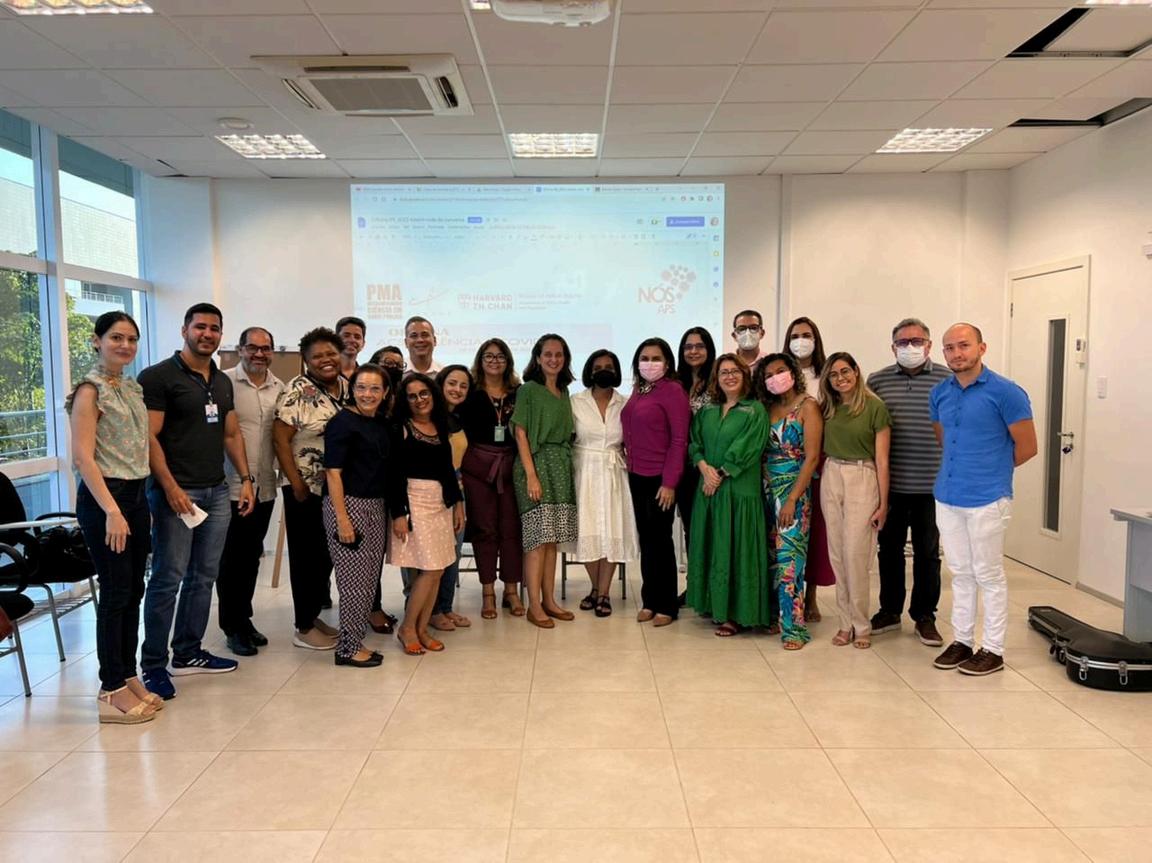













The Fund has enabled Harvard to build and strengthen its connections with institutions of excellence throughout Brazil, primarily in academia, but also nonprofits and private and public entities.
The LBRF has played a massive role in expanding and deepening Harvard University’s ties to Brazilian institutions, especially universities and research centers. By strengthening lines of communication between Harvard and Brazilian institutions, the Fund facilitates the exchange of information between Harvard and Brazil, including for opportunities that are not directly related to the LBRF projects.
70*
57
Brazilian Institutions have been written into proposals
Brazilian Institutions have collaborated on awarded projects
Academic Institutions have collaborated on awarded projects
Collaborating Brazilian institutions are based in
*Only includes institutions written into initial proposals as official hosts of co-investigators and collaborators. Many projects have collaborated with and engaged with additional institutions during or after the course of their LBRF grant, including governments and additional funders
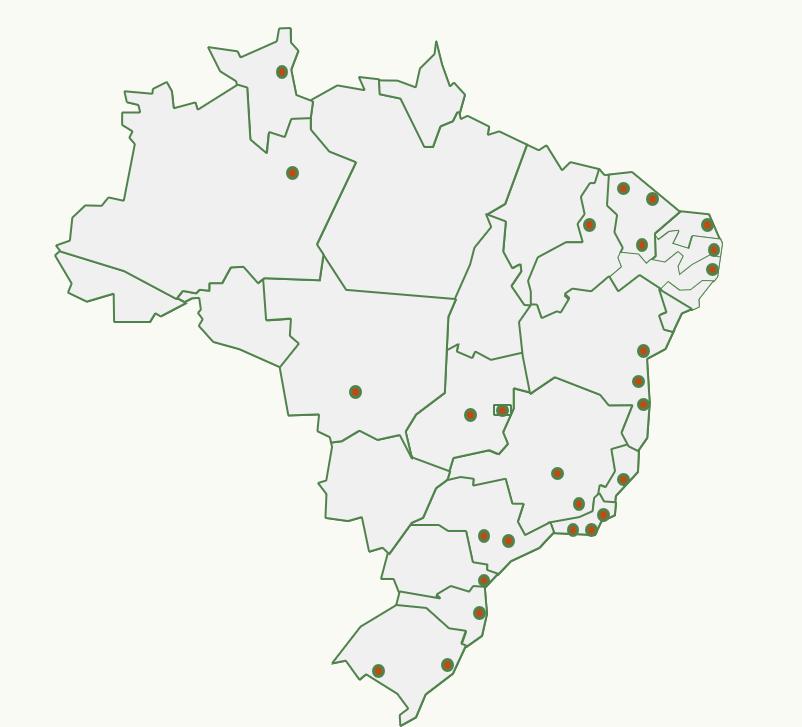
Agência Paulista de Tecnologia dos Agronegócios
Canal do Pirulla
Centro Universitário Christus
Escola Paulista de Medicina da Universidade Federal de São Paulo
Faculdade de Medicina da Universidade de São Paulo
Faculdade de Odontologia de BauruUniversidade de São Paulo
Fundação Carlos Chagas
Fundação Centro de Controle de Oncologia do Estado do Amazonas
Fundação Getúlio Vargas
Fundação Oswaldo Cruz - Ceará
Fundação Oswaldo Cruz - Centro de Desenvolvimento Tecnológico em Saúde
Fundação Oswaldo Cruz - Centro de Integração de Dados e Conhecimentos para Saúde
Fundação Oswaldo Cruz - Escola Nacional de Saúde Pública Sergio Arouca
Fundação Oswaldo Cruz - Instituto Aggeu Magalhães
Fundação Oswaldo Cruz - Instituto René Rachou
Fundação Oswaldo Cruz - Rio de Janeiro
Hospital de Ilheús
Hospital Risoleta Tolentino Neves
Insper Instituto de Ensino e Pesquisa
Instituto Cidades Sustentáveis
Instituto D’or de Pesquisa e Ensino
Instituto Nacional de Pesquisas da Amazônia
Instituto Nacional de Câncer
Instituto PENSI
Instituto Vila Educação
Laboratório da Educação
Laboratório Nacional de Computação Cientifíca
Ministério da Saúde do Brasil
Museu de Zoologia da Universidade de São Paulo
Petrobras
Pontifícia Universidade Católica de Goiás
Pontifícia Universidade Católica do Rio de Janeiro
Rede Nordeste de Formação em Saúde da Família
Secretaria da Saúde do Ceará
Secretaria de Saúde do Estado do Ceará
Secretaria Municipal de Saúde de Fortaleza
Universidade Católica do Salvador
Universidade de Brasília
Universidade de São Paulo
Universidade de São Paulo em Ribeirão Preto
Universidade Estadual do Amazonas
Universidade Estadual de Campinas
Universidade Estadual do Ceará
Universidade Estadual do Rio de Janeiro
Universidade Estadual de Santa Cruz
Universidade Estadual do Vale do Acaraú
Universidade Federal do Amazonas
Universidade Federal da Bahia
Universidade Federal do Cariri
Universidade Federal do Ceará
Universidade Federal do Espírito Santo
Universidade Federal do Estado do Rio de Janeiro
Universidade Federal Fluminense
Universidade Federal de Juiz de Fora
Universidade Federal de Mato Grosso
Universidade Federal de Minas Gerais
Universidade Federal da Paraíba
Universidade Federal do Pampa
Universidade Federal do Paraná
Universidade Federal do Piauí
Universidade Federal do Rio de Janeiro
Universidade Federal do Rio Grande do Norte
Universidade Federal do Rio Grande do Sul
Universidade Federal de Roraima
Universidade Federal de Santa Catarina
Universidade Federal de São Carlos
Universidade Federal de São Paulo
Universidade Federal Rural de Pernambuco
Universidade Federal Rural do Rio de Janeiro
Universidade Presbiteriana Mackenzie
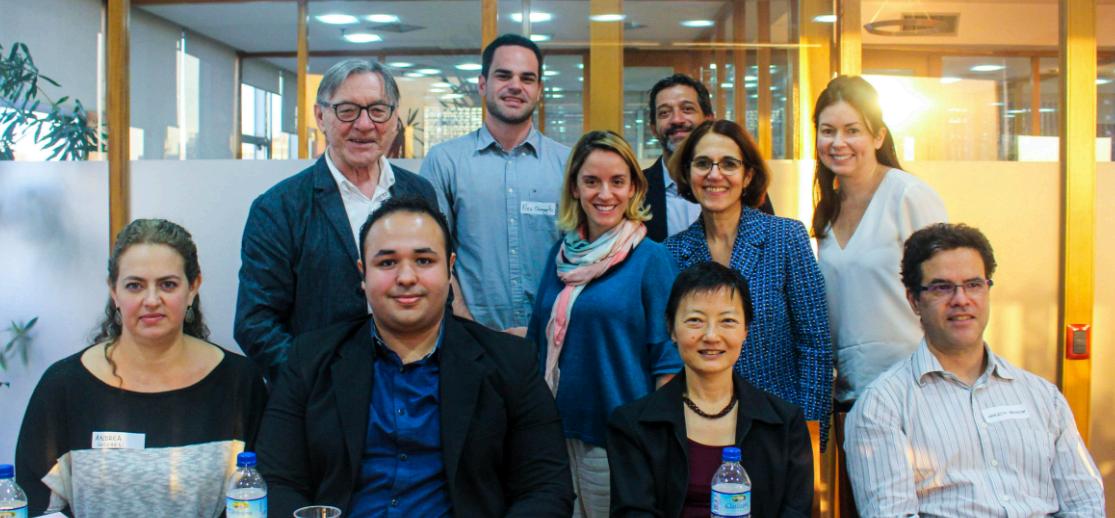












From distinguished academics to promising talents at the early stages of their careers, the Fund has made it possible for Harvard faculty and students to exchange knowledge, ideas, tools, and experiences with remarkable individuals from across Brazil.
Steven Levitsky Director of the David Rockefeller Center for Latin American Studies
At the David Rockefeller Center for Latin American Studies, one of our core values is responsible collaboration We understand that we have a lot to learn from people in Latin America, and we believe in co-constructing research agendas and projects together with the local experts and population. Brazil has extensive research capacity, with worldrenowned scientists and academics based throughout the country. The Lemann Brazil Research Fund has been a game changer in terms of fostering mutually beneficial collaborations between researchers from Harvard and from Brazil ”
Thanks to the Lemann Brazil Research Fund, Harvard researchers have been able to expand and deepen productive working relationships with academics and practitioners across Brazil. These Brazilian partners are critical to the success of the research endeavors supported by the Fund; in addition to intellectual and scientific aptitude, they typically possess local expertise and operational know-how that the Harvard researchers do not. The Brazilian partners are also essential to the positive externalities that the projects generate, such as spin-off projects, ongoing exchange, dialogue with policy and practice communities, public events, and communications products.
In many cases, the Brazilian partners are prominent academics or leaders in their respective fields and have much to teach their Harvard counterparts. The following pages showcase a sample of the Brazilian academics, representing a variety of disciplines and geographies, who have contributed immensely to the incredible success of the Lemann Brazil Research Fund at Harvard
*Does not include research assistants, project coordinators, administrators, or others who were not featured in the proposal
Renata Bertazzi Levy is a renowned researcher in the field of nutritional epidemiology and public health, working at the Department of Preventive Medicine at the University of São Paulo Medical School and the USP Center for Epidemiological Research in Nutrition and Health. Her studies focus on food consumption, dietary surveys, food environments, and sustainability Her impact on science has been internationally recognized, as she has been listed annually among the world’s most influential researchers by Clarivate Analytics since 2019
Guilherme Diniz Irffi is an associate professor in the Department of Applied Economics and the Graduate Program in Economics (CAEN) at the Federal University of Ceará (UFC) He coordinates the Results-Based Management Center (CGPR) at UFC and the Laboratory for Studies and Research in Social Economics (LEPES) of FEARP/USP in Fortaleza His research focuses on public policy evaluation, the economics of education, and social economics In 2024, he coauthored the winning paper of the XIII Prize from the Federal Budget Secretariat, standing out in the evaluation of regional development policies.
Sergio Duvoisin Junior is a full professor at the State University of Amazonas (UEA), where he coordinates the Central Laboratory for Chemical Analyses (CAQ/QAT) His research focuses on theoretical physical chemistry and analytical chemistry, with an emphasis on gas and liquid chromatography. As coordinator of the Water, Air, and Soil Monitoring Program of the State of Amazonas (ProQAS/AM), he leads environmental monitoring initiatives in the Amazon region. His work has been instrumental in securing funding for research infrastructure, strengthening UEA’s laboratorial and analytical capabilities.
Fernando Limongi is a prominent Brazilian political scientist and currently a faculty member at the São Paulo School of Economics at Fundação Getulio Vargas (FGVEESP). His research focuses on comparative politics, with an emphasis on democracy, executive-legislative relations, and political development. Limongi is the coauthor of influential works such as Democracy and Development (2000) and Executivo e Legislativo na Nova Ordem Constitucional (1999), which have significantly contributed to the understanding of coalition presidentialism and democratic institutions in Brazil.
Cristina Yumi Miyaki is an associate professor in the Department of Genetics and Evolutionary Biology at the Institute of Biosciences of the University of São Paulo (USP) Her research focuses on the biogeography, evolutionary history, and conservation of Neotropical avifauna, with an emphasis on Atlantic Forest birds Her laboratory has published numerous phylogeographic studies, revealing the complex biogeographic history of this biome Additionally, she and her team produce genetic data that contribute to the conservation of endangered species such as the Spix’s macaw
Ig Ibert Bittencourt is an associate professor at the Institute of Computing at the Federal University of Alagoas (UFAL) and co-founder of the Center for Excellence in Social Technologies (NEES). His research focuses on artificial intelligence in education, positive psychology, and educational technologies In 2022, he was awarded the Medal of the National Order of Educational Merit in recognition of his contributions to education in Brazil.
Caroline Furtado Junqueira is a Brazilian biologist and immunologist recognized for her contributions to the study of infectious diseases and vaccine development. She is currently a researcher at the René Rachou Institute (FIOCRUZ-Minas), where she leads projects in immunoparasitology and cell biology, with a focus on Plasmodium spp and Trypanosoma cruzi infections, as well as cancer immunology. Among her distinctions are the Grande Prêmio Capes de Teses and the Thereza Kipnis Award from the Brazilian Society of Immunology.
Eduardo Góes Neves is a Brazilian archaeologist, full professor, and director of the Museum of Archaeology and Ethnology at the University of São Paulo (USP). He is recognized for his research in the Amazon, particularly through the Central Amazon Project His studies have challenged traditional views on precolonial occupations in the region, revealing complex and sedentary societies He served as president of the Brazilian Society of Archaeology (2009–2011) and was a board member of the Society for American Archaeology (2011–2014) Currently, he coordinates the Laboratory of Tropical Archaeology and is a researcher at USP’s Center for Amerindian Studies (CESTA)
Silane Aparecida Ferreira da Silva Caminha is a professor at the Faculty of Geosciences at the Federal University of Mato Grosso (UFMT). She coordinates the UFMT Laboratory of Paleontology and Palynology, which has infrastructure for the preparation and analysis of fossil and recent samples Her research focuses on Neogene palynology in the western Amazon She leads projects on the characterization of archaeological ceramics in the state of Mato Grosso, contributing to the understanding of past population technologies Silane is also engaged in university outreach, enhancing fossil exhibitions at the FAGEO Museum, which hosts school visits to promote Geosciences education
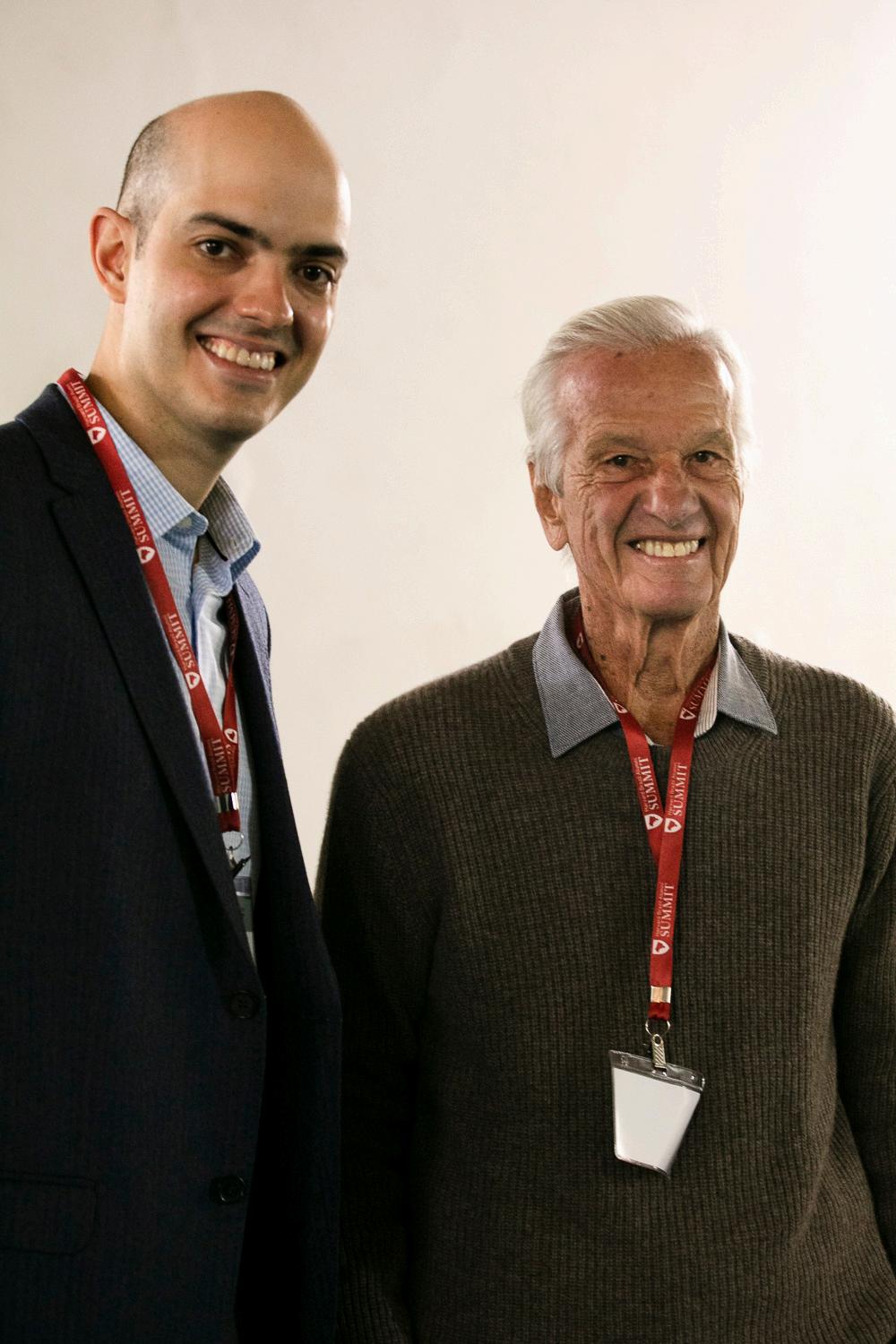












The Fund has sparked a dramatic uptick in the number of Harvard researchers who are working closely with Brazilian counterparts to produce, transfer, and disseminate scientific knowledge that can help address an array of important challenges in Brazil.
Harvard’s academic strength is dispersed throughout a range of disciplines. Likewise, Brazil as a field of study presents compelling research and learning opportunities across many fields and geographies In addition, Brazil is an important country for several global issues The LBRF has allowed Harvard and Brazilian research teams to pursue critical questions in diverse fields and geographies, maximizing the potential of what Harvard and Brazil have to offer in terms of knowledge production and real-world impact. This section provides an overview of LBRF award topics and locations and then provides summaries of each project, organized by topic category.
LBRF Awards by Topic Category **Collaborative Field Courses were on Archaeology and Geology
*Of the grants on Public Health and Medicine, 5 look specifically at COVID-19, which was a priority topic for the LBRF in 2021 and 2022. Additional projects addressing the impacts of COVID-19 are categorized into Education (1) and Human Development (1).
Projects have taken place in covering all
Marcia Castro Chair of the Brazil Studies Program
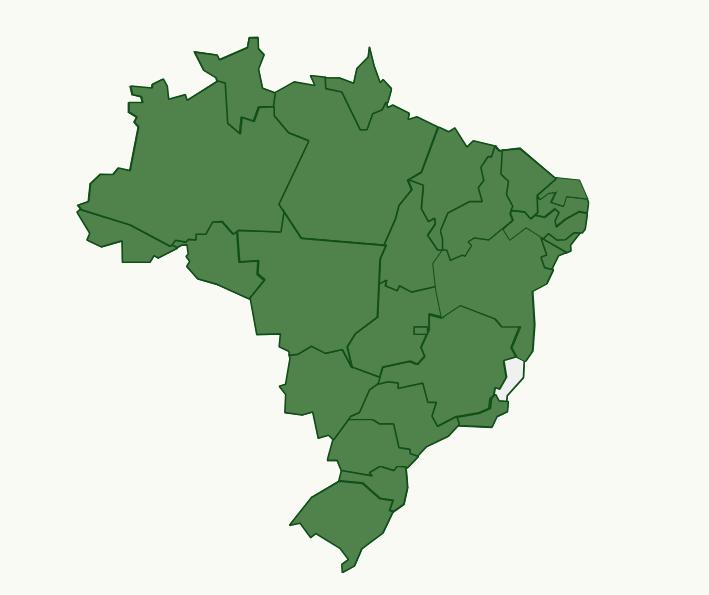
*This number considers only the states in which on-theground fieldwork has occurred. When considering states in which data collection has occurred as part of LBRF projects, all 27 states of Brazil are represented.
The LBRF has been transformative for the Harvard-Brazil ecosystem. When I arrived at Harvard in 2006, we could not fill a room with researchers working on Brazil-related issues. Now we need an auditorium The Fund has shortened the distance between Harvard and Brazil, enabling collaborations between scholars that would never have happened without it. Over 10 years, funded projects have directly contributed to health policy, advanced knowledge in several fields, and served as seed funding for larger collaborations with external funding Broadly, the impact of these projects has the potential to generate many positive spillover effects for the benefit of Brazilian society ”












These projects have shed light on some of the most salient topics of debate concerning education in Brazil, such as literacy development, social and emotional learning, STEM, and teacher education. A transversal focus on opportunity and equity is salient throughout this robust portfolio of research on education.






Harvard Lead: Elizabeth Spelke (FAS)
Brazil Leads: Chrissie Ferreira de Carvalho (Universidade Federal de Santa Catarina), Nara Cortes Andrade (Universidade Católica do Salvador), and José Neander Silva Abreu (Universidade Federal da Bahia)
LBRF Grants: 2018, 2020
Timeline: 2018–ongoing
Locations: Salvador (BA), Juiz de Fora (MG), Florianópolis (SC)
Additional Support: Bracell Foundation, J-PAL
Presentations at 7 international events and 14 national events with a total estimated audience of 3,000 individuals
Overview: This initiative combines educational and neuropsychological game-based interventions. It has established new, evidence-based methodologies for addressing developmental challenges in Brazil’s public education and health systems, especially for socioeconomically disadvantaged children and those with autism spectrum disorder (ASD). The scalability of the interventions is crucial, allowing it to reach marginalized populations.

Curiosamente Program: The Curiosamente program, aligned with the Base Nacional Comum Curricular, incorporates evidence-based games to foster cognitive and socioemotional development. It focuses on essential skills such as emotional recognition and regulation, theory of mind, and concepts of number and geometry, aiming to address the developmental gaps that emerge early in life.
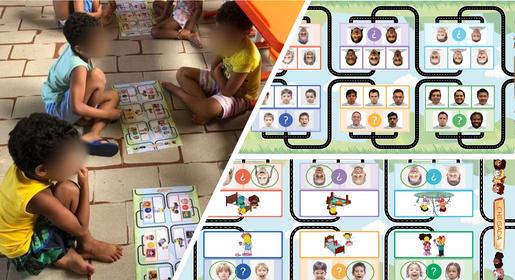

Pilots and Adaptations: The interventions were developed through rigorous pilot testing and subsequent adaptations, ensuring that they are affordable and can be easily implemented in underfunded public schools or health services across Brazil.

Randomized Controlled Trials (RCTs): Four empirical studies were conducted in Brazil, providing robust evidence through RCTs. These studies revealed substantial improvements in both mathematical cognition and socioemotional development.

Key Findings: The empirical evidence from the RCTs—both school-based and focused on ASD—demonstrates that the interventions significantly improved children's cognitive, mathematical, and socioemotional skills. These interventions not only supported children's academic readiness, particularly in math, but also equipped them with the socioemotional resilience and sociocognitive competencies necessary for success in social and educational settings.
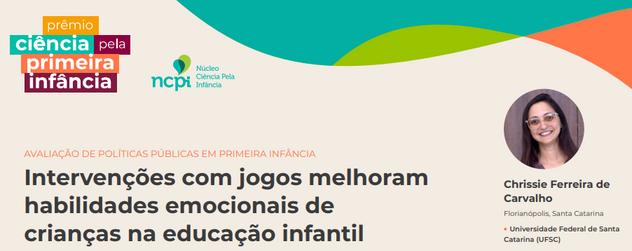

Policy Impact: The project had a multifaceted impact on Brazil, advancing public health, education, and social policy, particularly for children with neurodevelopmental disorders such (ASD). By integrating low-cost, evidence-based game interventions designed to enhance social cognition and mathematical skills, it significantly improved socioemotional and cognitive outcomes, especially for children with ASD. These outcomes influenced local education policies and led to formal adoption by the Municipal Department of Education of Juiz de Fora. The city integrated these tools into early childhood programs and continued use was requested by the University Hospital and Associação de Pais e Amigos dos Excepcionais, highlighting sustained policy and clinical relevance.

Capacity Building: The project trained approximately 300 teachers and 200 health professionals through workshops, discussion circles, and hands-on sessions, focusing on neuroscience, socioemotional development, and game-based learning. It emphasized practical application, inclusive education, and reflective pedagogy, equipping practitioners with tools to support diverse learners in real-world classroom and clinical settings.

Publications in Preparation:
“A Game-Based Intervention to Promote Social Cognition in Early Childhood in Brazilian Contexts of Urban Poverty”
“Parental Self-Efficacy in Autism Spectrum Disorder: Effects of a Game-Based Intervention”
“Core Knowledge and Common Sense Psychology Based on Naive Utility Calculus”
“Improvements in Cognitive Skills in Autistic Children After Participating in a GameBased Intervention”
Harvard Leads: Stephanie Jones, Dana McCoy, Rebecca Bailey, Sonya Temko, and Jennifer Kahn (HGSE)
Brazil Leads: Alexandra Brentani (Faculdade de Medicina da Universidade de São Paulo), Ana Luiza Colagrossi (Faculdade de Medicina da Universidade de São Paulo & Instituto Sedes Sapientiae), and Rita Esther Ferreira de Luna (Universidade Federal do Amazonas)
LBRF Grants: 2018, 2019, 2022
Timeline: 2018–ongoing
Locations: Iranduba (AM), Paraty (RJ), Rio de Janeiro (RJ), São Paulo (SP)
Additional Support: Comunitas, DRCLAS Brazil Office, Fundação Maria Cecília Souto Vidigal, Itaú Social, Fundação Bracell, J-PAL
2 Conference Presentations at the Comparative International Education Society (CIES)

Overview: The low-cost activities based on SEL Kernels, developed by the EASEL Lab at HGSE, are compatible with the Brazilian official curriculum (BNCC) and help build a school routine that fosters social and emotional learning.

Cultural Adaptations: The team worked carefully with local partners to adapt the SEL Kernels to Brazil and to particular contexts. For example, while in Rio de Janeiro they were called Brincadeiras para o Aprendizado SocioEmocional (BASE), in Iranduba they became Amazonas Caroço.
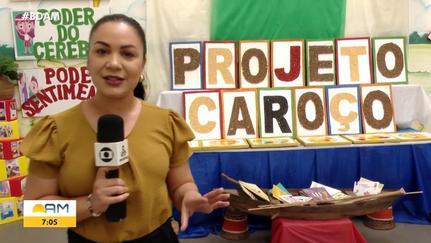

Responding to Local Needs: During the COVID-19 pandemic, the team worked with the Department of Education in Rio de Janeiro to design an implementation study rather than a randomized control trial to better respond to the high demand for social and emotional learning and mental health supports in schools and families during long periods of school closures. The BASE set was expanded to increase the emphasis on self-regulation and stress management to support children’s response to the emotional challenges that the pandemic presented. The BASE activities were also disseminated via public TV and hybrid learning.

Key Findings: A quasi-experimental study across 20 classrooms in four early learning centers in Paraty and Angra dos Reis documents statistically significant improvements for children who participated in the SEL Kernels intervention in teacher reports of their prosocial behavior and emotion regulation, as well as reductions in conduct problems, hyperactivity, and peer problems. Positive outcomes were also observed at the teacher level, with teachers who used SEL
Kernels showing improvements in self-efficacy and growth mindset. Qualitative data collected throughout the adaptation and implementation process indicated that teachers appreciated the flexibility to implement and adapt SEL Kernels as needed to fit their classroom schedules and meet the needs of their students, as well as the clear connection to national standards. Additionally, teachers reported that Kernels were fun, engaging, and led to increases in attendance as well as positive connections with parents. Additional data analysis is underway to examine implementation and the efficacy of SEL Kernels in subsequent projects in Brazil.

Policy Impact: Following the study, Rio de Janeiro expanded access to BASE in-person materials and training to all early childhood teachers in the municipality. In Iranduba, the team met with the secretary of education and the pedagogical leaders of the municipality to raise awareness about the importance of the project, align on actions, present progress, and ensure engagement in the initiatives. A department was created to provide psychosocial support with a multidisciplinary team. After successful local experiences, the project was also presented to the Department of Basic Education at the Ministry of Education.


Capacity Building and Course with the Ministry of Education: In addition to the professional development for teachers to implement the strategies in their schools and train other teachers (teacher multipliers), a free online course was developed on the AVAMEC platform for teachers to take part in a self-paced training focused on social and emotional learning and psychosocial support.



Further Expansion: Additional implementation and research will be funded through a successful submission to a public call for proposals from Fundação Bracell and J-PAL.
Academic Publications:
“Adaptation and Efficacy of a Social-Emotional Learning Intervention (SEL Kernels) in Early Childhood Settings in Southeastern Brazil: A Quasi-Experimental Study” (��Link)
“Integrating SEL into early childhood settings in Brazil” (��Link)
Harvard Leads: Meredith Rowe, Nadine Gaab, and Gigi Luk (HGSE), Charles Haynes (MGH)
Brazil Lead: Cíntia
Alves Salgado Azoni (Universidade Federal do Rio Grande do Norte)
LBRF Grant: 2017
Timeline: 2017 - ongoing
Location: Natal (RN)
4 master’s theses, 6 scientific initiation projects, and 2 undergraduate theses (TCC) were written on the project
16 Presentations at Academic Conferences
Presentations in 2022 and 2023 at ExpoEduc Natal, the largest educational congress in Brazil’s Northeast region, reached an estimated total of 6,000 people

Overview: This project aims to (1) identify early cognitive and linguistic predictors of literacy development in young children from low-income families and (2) examine the effects of classroomand technology-based interventions on literacy development longitudinally for children from preschool to second grade.
One hundred, ninety-two children from low-income families, from three municipal public schools in the city of Natal, Rio Grande do Norte, with low IDEB, were enrolled in the study.

Key Findings: Results after the first year of the intervention showed that the children improved their ability to recognize letters and vocabulary, and in the second year they were better able to acquire reading via a phonological route.
It was also identified that parents have many difficulties in understanding the importance of reading in their children's lives. Two years after the end of the research, the team evaluated these children up to the fifth grade and identified that their reading did not worsen after two years without classes because of the COVID-19 pandemic, but they did not improve either.

Influence on Research Agendas: The project significantly influenced the research agenda of Cíntia Salgado's team, particularly by fostering greater interest in conducting research in schools and with children from low-income families. There was also repercussion at a national level. Cíntia Salgado was invited by several groups to talk about children in social vulnerability and the intervention model used, which had reach in other regions of the country.

“The project enabled by this funding completely changed my world view on academic life.” —Cíntia Salgado

Building Capacity: Brazilian graduate students participated in team discussions, meetings with schools and the education department, meetings with collaborators at MGH and Harvard, and seminars on the topic. The collaboration introduced the team to new data analysis tools and techniques, enhancing their ability to deal with qualitative and quantitative data relevant to intervention.

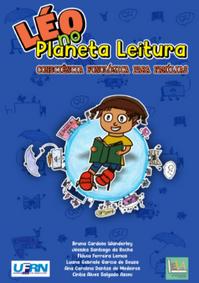

Léo no Planeta Leiture is a free E-Book for parents to stimulate their children's phonological awareness (��Link)
Policy Impact: The positive impact of the partnership between the researchers, principals, and coordinators culminated in the request from the municipal secretary of education to continue expanding the research through a fifth year with schools’ voluntary participation in evaluating the children’s progress annually. The researchers have also met with the state department of Rio Grande do Norte to expand the research to state schools and help identify children at risk for learning disorders.

Support to Parents During COVID-19: The team developed an intervention material for parents to use at home and distributed it during the delivery of basic food baskets at the school in the first months of the pandemic. (See e-book above).

Book Chapters:
“Identificação precoce de dificuldades de leitura e escrita em contextos de vulnerabilidade” in Alfabetização: Da ciência cognitiva à prática escolar (2021) (��Link)
“Cérebro, leitura e vulnerabilidades: como estimular nossas crianças” in Contribuições da Neurociência para uma educação integradora (2022) (��Link)
“Resposta à intervenção em linguagem escrita em contexto de vulnerabilidades” in Intervenção fonoaudiológica em audição e linguagem (2024) (��Link)

Publications:
“Characterization of the phonological system in low-income Brazilian preschoolers” (��Link)
Harvard Leads: Paola
Uccelli, Felipe BarreraOsorio, and Sarah DrydenPeterson (HGSE)
Brazil Leads: Beatriz
Cardoso and Nicole PauletPiedra (Laboratório da Educação), Daniel Domingues dos Santos (Universidade de São Paulo-Ribeirão Preto)
LBRF Grants: 2016, 2019
Timeline: 2016–ongoing
Locations: São Paulo (4 municipalities) and Maranhão (16 municipalities)
Additional Support: Tinker Foundation; CONDECA
Developed and validated the Portuguese Core Academic Language Skills (ALA) instrument
Brazilian and U.S.-based Ph.d, master’s, and undergraduate students are involved in the project

Overview: This innovative research-practice partnership investigates how to promote literacy equity among students in public schools. Phase one, the “Learning for All” project, explored why some schools outperform others in similarly low-income neighborhoods, analyzing academic language skills, reading comprehension, and school dynamics.
Phase two evaluated the Aprender a Estudar Textos (AET) program, a professional development (PD) effort designed to help fourth-grade teachers strengthen students’ ability to read and learn history texts. Implemented online during COVID-19, AET focused on improving instructional practices and student outcomes related to academic language and comprehension.


Rapid Digital Adaptation: The shift to Zoom and a custom platform during COVID-19 enabled continuity in teacher training.
Equity-Driven Design: Offered PD to all fourth-grade teachers in response to local government needs, preventing further inequality.
Data-Rich Evaluation: Despite pandemic disruptions, researchers collected and analyzed significant longitudinal data.

Capacity Building: Seventy-seven teachers and a dozen pedagogical coordinators initially received training on the AET methodology. Currently, in Maranhão, the AET program teachers reach about 10,000 students per year.

Scalability of Materials: Professors from the State University of Mato Grosso and Universidad Católica de Chile already utilize the materials and AET methodology as part of their language and literacy classes.



Key Findings from the ”Learning for All” Project:
School-Level Inequality: High- and low-performing schools in the same neighborhoods served unequal student populations. Students in high-performing schools had more educated parents, more resources at home, and a greater sense of well-being and belonging, revealing hidden layers of inequality within supposedly similar schools. This suggests that residential sorting and school selection practices may be factors that reinforce inequality.
Academic Language and Reading Proficiency: Academic language proficiency was the strongest predictor of reading comprehension—even more than socioeconomic status. Students across grades struggled more with informational than narrative texts.
Teacher Perspectives: Teachers recognized the complexity of reading comprehension and the importance of student assessment, but most lacked specific tools or strategies to address comprehension challenges.

Key Findings from the Remote Aprender a Estudar Textos (AET) Program:
Literacy Outcomes Pre- and Post-COVID: In the first year after school closures, before the program implementation, students improved in academic language skills but declined in reading comprehension, particularly among low-income students, which widened inequalities. Teacher and parental support mitigated learning loss but were unevenly distributed.
Predictors of Literacy: Academic language skills and reading comprehension strongly predict each other; classroom environment did not correlate with improved reading. Toolkit: Tools developed provided meaningful ways to assess students’ language readiness and track their beliefs.
Teacher PD Discourse Analysis: The Professional Development program was seen as adaptive, dialogic, and supported both teacher learning and instructional design. Teachers learned to integrate language and content learning, recognizing student participation as vital.
Paola Uccelli and Beatriz Cardoso participate in the webinar “Apoiando o letramento e a aprendizagem nas diferentes áreas disciplinares nos anos iniciais do EF”(��Link)


Policy Engagement: Results have spurred interest from local and state education authorities in using data for teacher training and curriculum design.

Overview: This project sought to improve early literacy instruction in Brazil by integrating phonicsbased methods into existing classroom practices. Through research at Harvard and in collaboration with Brazilian educators, the team developed the Novos Amigos program—a playful, multisensory curriculum grounded in cognitive science. The project emphasized complementing, rather than replacing, current pedagogical practices, aiming to ease adoption and foster teacher engagement. It has indirectly impacted over 90,000 children across 14 cities in five regions of Brazil.
Brazil Lead:
(Universidade
LBRF Grant: 2018
Timeline: 2018–2022
Location: São Paulo (SP)
5 presentations at academic conferences
10 undergraduate theses and 8 scientific initiation projects were written on the project
Contributed to the book



Alfabetização baseada em evidências: da ciência à sala de aula, which was recently adopted as required reading for all early literacy teachers in Porto Alegre (RS) (��Link)

Cultural Adaptations: Novos Amigos was intentionally designed to resonate with Brazilian students by using locally relevant characters, settings, and vocabulary. The team ensured the curriculum was built on familiar classroom narratives while gently introducing new phonics strategies. This culturally responsive approach helped minimize resistance from educators and encouraged widespread adoption of the materials.

Key Findings: Novos Amigos demonstrated early success in improving phonemic awareness and reading fluency among young learners. While not yet implemented at scale, the program informed evidence-based criteria later applied in Edube-led initiatives, reaching over 150,000 children in 20 municipalities across seven states. The project produced four student workbooks, a storybook, a teacher’s guide, 30 animated videos, an early literacy assessment system, and a professional development program—resources especially valuable during the pandemic.
This project was influential in shaping the National Literacy Policy in 2020: Relatório Nacional de Alfabetização: Baseada em Evidências (��Link)


Characters representing Portuguese-specific phonemes in the Novos Amigos alphabet




Characters representing a child with a physical disability, a Quilombola child, a deaf child, and an Indigenous child
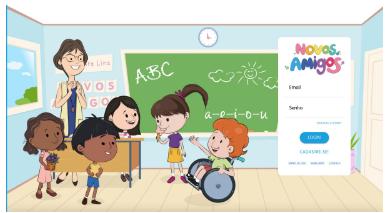
Multiplatform: Web, iOS, and Android
Ease of Use: Individual student registration
Content: Reading, writing, phonetic awareness activities, and stories for each of the platform’s 30 characters
Monitoring: Performance reports to track learning

Capacity Building: This project was instrumental in positioning Renan Sargiani as a national leader in literacy education. His experience through the project led to his appointment as coordinator of cognitive and linguistic neuroscience at Brazil’s Ministry of Education, where he coauthored the National Literacy Policy (PNA, 2019–2023), led the National Panel of Experts on Literacy and Numeracy, and chaired both CONABE and the creation of the comprehensive RENABE report. He later founded the Evidence-Based Education Institute (EDUBE), trained thousands of teachers across Brazil, and supported education reforms in cities such as São Paulo, Manaus, Macapá, Uberlândia, Canoas, and Abaetetuba— broadening the project’s policy and classroom impact.
Harvard Lead: Dana McCoy (HGSE)
Brazil Leads: Vladimir Ponczek and Cristine Campos de Xavier Pinto (Fundação Getúlio Vargas), Ana Luiza Colagrossi (Instituto Vila Educação)
LBRF Grants: 2016, 2017
Timeline: 2016–2020
Location: Rio de Janeiro (RJ)
Conference presentations and invited talks include:
- Comparative and International Education Society
- Conference on Poverty and Inequality, HKS
- Society for Research in Child Development -Carolina Consortium on Human Development -Developmental Science Program, UMass Amherst

Overview: This project focused on evaluating the classroom-based Programa Compasso Social and Emotional Learning intervention in a sample of approximately 3,000 students across 94 primary schools in Rio de Janeiro. Key outcomes included students’ executive function, emotional knowledge, and behavior problems.

Study Significance: To the knowledge of the research team, this was one of the largest evaluations of social-emotional learning (SEL) programming to ever take place outside of the United States.

The project and concept of social and emotional learning in Brazilian public schools featured in Brazilian media outlet Época (��Link)

Key Findings (Year 1): This project produced important insights about the impacts of SEL programming in Brazil. In the first year of the intervention, the researchers found that the overall effects of the Programa Compasso intervention were generally small and not statistically detectable.
However, positive impacts were identified on children’s SEL outcomes in low-violence communities, suggesting that this intervention may be valuable for supporting students in such settings, and that alternative (e.g., more intensive) approaches may be needed in contexts characterized by higher levels of violence.

Key Findings (Year 2): Results from the second year of the evaluation found that Programa Compasso may have led to small, negative impacts on certain child outcomes (e.g., emotion knowledge) during its second year of implementation. During this year, teachers reported multiple barriers to their ability to effectively implement the program, including limited time and resources to support its use in the classroom.

Policy Takeaways: Collectively, these results point to the importance of designing SEL intervention approaches that are tailored to the needs of specific communities and cultures, and also to the importance of providing teachers with appropriate supports for implementation (e.g., time and resources to use the program as intended). In addition to supporting decision-making regarding when and how to scale up SEL programming, these findings also help to improve the generalizability of the existing literature on SEL, which has largely focused on children in the U.S. and other high-income countries.

Teaching at Harvard: This project was presented to all incoming EdM students as part of student orientation at HGSE in 2018 and 2022, reaching about ~1,200 students. The project has also discussed in the HGSE course “Early Child Development in Global Contexts” on an annual basis since 2020.


Publication in Child Development, one of the premier journals on human development (��Link)
Publications:
"Exploring the Effects of a Social-Emotional Learning Intervention in Brazilian Primary Schools: Findings from Year Two of Implementation." (��Link)
"Um compasso para aprender: A randomized trial of a social‐emotional learning program in homicide‐affected communities in Brazil." (��Link)
"Systemic barriers and opportunities for implementing school-based socialemotional learning interventions in low-income and conflict-affected settings." (��Link)
"Classroom-level peer self-regulation as a predictor of individual self-regulatory and social-emotional development in Brazil." (��Link)
Harvard Lead: Gabrielle Oliveira (HGSE)
Brazil Lead: Leila Baptaglin (Universidade Federal de Roraima)
LBRF Grant: 2023
Timeline: 2023–ongoing
Location: Boa Vista (RR)
Additional Support:
DRCLAS, DRCLAS Brazil Office
Partnerships with the mayor’s office and secretary of education of Boa Visa
3 Brazilian undergraduate and 3 Brazilian graduate students have been trained
5 articles have been submitted and 3 articles are in development

Overview: In response to the growing presence of Venezuelan migrant families in northern Brazil, the project examines how Venezuelan and Brazilian children interact and learn together in public elementary schools, using bilingual, culturally relevant materials to support inclusive learning.

Fieldwork: The project is centered in five elementary schools in Boa Vista, targeting first- and second-grade classrooms. Researchers conduct regular 90-minute observations, interview 20 educators and school staff, and collect curricular materials, policy guidelines, and student work.
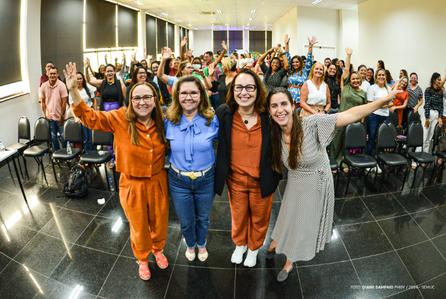

Multicultural Literacy and Innovation: In 2024 and 2025 a collaboration between researchers at Harvard, UFRR, and the secretary of education in Boa Vista worked on a list of literary books that incorporate themes like migration and identity using books in Portuguese and Spanish The list of books introduces themes like indigeneity, citizenship, and migration rarely addressed at the early elementary level and promotes cross-cultural collaboration by pairing students for reading and writing By centering children's drawings and narratives as core data, the project also brings student voices and agency to the heart of both research and curriculum Interviews with teachers and educators revealed how student engagement grows in lessons where their identity is centered and celebrated inside the classroom. We have also learned from Indigenous education in Roraima to understand how language and identity are key elements to solidify literacy practices inside classrooms.


Findings: Teaching Portuguese as a Way of Caring
Teachers focused heavily on teaching Portuguese to Venezuelan children, believing this would help them adapt faster and feel more included While well-meaning, this often meant students’ Spanish (or Warao) was discouraged even by asking families not to speak it at home. This created pressure on kids to "fit in" by changing how they spoke.
Findings: Children’s Solidarity Work
Despite the pressure to only speak Portuguese, children helped each other across language and cultural differences. They translated, played, shared, and showed empathy creating their own inclusive spaces They resisted the idea that Spanish shouldn’t be used, showing that kids can naturally build bridges, even when adults enforce rigid rules.


Significance: This work was the first systematic documentation of a high inflow of migration context in Brazil to address how public schools responded to the challenges that came with it.
Capacity Building: The team trained teachers and educators with the findings from the research to center language skills, children’s knowledge, and teachers’ pedagogical practices of inclusion. There have been three trainings for over 2,000 teacher, two trainings for leadership in education, and 12 interventions with children using art. These resulted in new ways of teaching and approaching the classroom by allowing translanguaging and using art to generate knowledge from children.


Publications:
working meetings, and presentations
“Venezuelan migration to Brazil: teachers and students co-constructing multicultural education inside classrooms” (��Link)
“(I)migração venezuelana: o contexto da alfabetização de crianças brasileiras e venezuelanas nas escolas municipais de Boa Vista/RR” (��Link)
“Where Are Venezuelan Children’s Knowledges in Educational Research in Brazil?” (��Link)
“A imigração venezuelana e o contexto da alfabetização de crianças brasileiras e venezuelanas em escolas municipais de Boa Vista, Roraima, Brasil: um olhar para as considerações da gestão” (��Link)
Harvard Lead: Flavio Calmon (SEAS)
Brazil Leads: Seiji Isotani (Universidade de São Paulo) and Ig Ibert Bittencourt (Universidade Federal de Alagoas)
LBRF Grant: 2023
Timeline: 2023–ongoing
Location: Nationwide
Additional Support: Google, JPMorgan, Apple Ph.d. Scholarship
1 PhD dissertation has been supported by the project
The team organized the 2024 ACM Conference on Fairness, Accountability, and Transparency in Rio de Janeiro. The foremost conference in responsible AI development, this was the first time it was organized in Brazil.

Overview: This project supported a comprehensive study of bias and fairness in machine learning (ML) and artificial intelligence (AI) systems relevant to Brazilian educational contexts. The research addressed fundamental challenges in ensuring that AI systems perform well across diverse user groups, protect sensitive personal information, and avoid perpetuating societal biases.
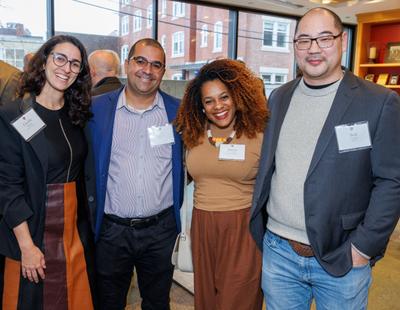

Multi-Group Proportional Representation: A key contribution was the creation of new metrics and methods for ensuring representation of diverse populations in AI-generated content. The team introduced multi-group proportional representation (MPR), a metric that measures representation across intersectional groups in information retrieval and generation tasks. They also proposed new methods for "explaining" AI outputs. Instead of treating AI models as opaque “black boxes,” the algorithms help understand why these models produce a given output. This is particularly relevant in automated grading and fact-checking, both emerging use cases of AI in education.

Alignment Discretion: The project also advanced understanding of how AI systems exercise discretion in safety decisions, introducing the concept of "alignment discretion" —the latitude afforded to AI systems in following safety specifications, particularly when they conflict. For example, if a student asks a chatbot, "What makes
a chemical compound poisonous?" should the system answer exactly? Should it help the student, or refrain from outputting potentially harmful information? The AI system must balance helpfulness, educational value, and safety. The work helps developers understand how to navigate these trade-offs and ensure that AI systems work in a safe and age-appropriate manner.

Algorithmic Arbitrariness: Related work explored content moderation, showing how multiple competing AI models for content classification may perform equally well on average yet assign conflicting predictions to the same content. This is particularly relevant to the Brazilian context, where social media platforms use automated algorithms to remove policy-violating content. The work shines light on how these algorithms can fail and guides more responsible development.
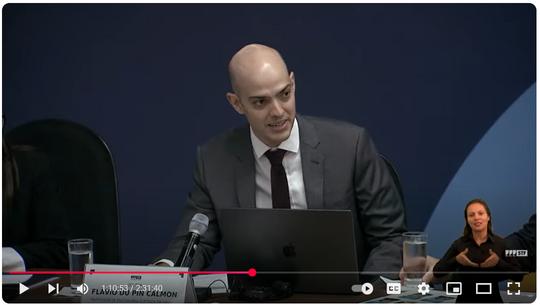

Panel Series: The project created a unique bridge between theoretical research and real-world implementation through the “Artificial Intelligence in Brazil” panel series at Harvard. The series, hosted by the DRCLAS Brazil Studies Program, brought together Brazilian policymakers, startup founders, and researchers from major technology companies, including Google and OpenAI, to discuss the broader challenges and opportunities of deploying AI systems in Brazil. (��Link)
Lucas Monteiro Paes is a Brazilian PhD student in applied math at the Harvard SEAS (��Link)
His doctoral thesis, “Epistemic Limits of Trustworthy Machine Learning,” was supported in part by this LBRF award.
In the photo on the right, Lucas speaks at the “AI in Brazil” panel series, which he co-organized with Flavio Calmon and others.

Conference Papers:

“AI Alignment at Your Discretion.” (Best Paper Award at NENLP’25) (��Link)
“Algorithmic Arbitrariness in Content Moderation” (ACM FAccT’24) (��Link)
“Selective Explanations” (NeurIPS’24) (��Link)


Harvard Lead: Michela Carlana (HKS)
Brazil Lead: Carolina Nour (Fundação Getúlio Vargas)
Others: Raissa Fabregas (University of Texas at Austin) and Diana Moreira (University of California, Davis)
LBRF Grant: 2019
Timeline: 2019–2023
Location: Rio de Janeiro (RJ)
Additional Support: J-PAL Post Primary Initiative

Overview: This project aims to increase the participation of women and underrepresented minorities in STEM careers in Brazil by addressing early barriers in perception and access. The study evaluates whether a low-cost online mentoring program can influence ninth-grade students' aspirations and decisions related to STEM education and careers.
Partnerships: Throughout the course of the project, the researchers have worked with the Brazilian Math Olympiad, the Ministry of Social Protection, and the municipal secretary of education of Rio de Janeiro. This was the first time the Brazilian Math Olympiad, an institution that serves around 18 million students yearly, has engaged in a randomized control trial.
Talentos de Amanhã Program: High-performing ninth-grade students, identified by their teachers, were paired with volunteer college students pursuing STEM degrees for a structured mentoring program. The program consisted of five online meetings coordinated via the WeSchool platform, covering topics such as STEM career pathways, college access, and the mentors’ personal experiences.

Study Design: Students are randomly assigned to participate in the mentoring or remain in a control group, allowing the research team to measure impacts on perceptions, aspirations, stereotypes, and academic choices.

Adapting to the Pandemic: The COVID-19 pandemic required major adaptations to the original research design, prompting the team to shift from in-person data collection to remote methods and to focus on the online components of the Math Olympiad. Despite challenges such as school closures and limitations on participant compensation, the researchers maintained close collaboration with the implementing partner and successfully adjusted the project to ensure continued engagement and implementation under the new circumstances.

Performance Patterns: In the second phase of the Math Olympiad, boys and girls with similar scores in the first phase perform similarly—especially at lower score levels. However, among high-achieving students, performance begins to diverge. In Level 1 (ages 11–12), gender differences in scores emerge among those scoring above 15 in the first phase, and become significant above 18. In Level 3 (ages 15–18), the performance gap appears earlier, starting around a score of 10.


Participation Drop-off: Participation in the second phase is roughly equal for boys and girls with mid-range scores in Level 1 (ages 11–12), but among high scorers, fewer girls return for the second phase. In Level 3 (ages 15–18), the drop-off is more dramatic: only about 40 percent of girls scoring 15 in the first phase return for the second phase, compared to 60 percent of boys. Notably, a girl scoring 8 is more likely to participate in the second phase than a girl scoring 18—highlighting a paradoxical pattern of higher dropout among high-performing girls.
Insights: This selective dropout among top-performing girls may partly explain gender disparities in medal outcomes. It raises critical questions about what discourages talented girls—whether social pressures, confidence issues, or fear of standing out—and underscores the need to explore the psychological and cultural factors behind their disengagement.

“Por que meninas talentosas 'evitam' o sucesso?,” Blog post in major newspaper O Globo (��Link)


Benefits to Target Population: The project facilitated the inclusion of public school students who are from poor backgrounds and are very talented, but who are often overlooked in the traditional program offered by the Math Olympiad.
Impact on the Math Olympiad: The team believes this project should help the Brazilian Math Olympiad begin a more continued effort of systematically evaluating its initiatives.
Harvard Lead: Katherine K. Merseth (HGSE)
Brazil Lead: Gabriela Miranda Moriconi (Fundação Carlos Chagas)
LBRF Grant: 2017
Timeline: 2017–2020
Locations: Amapá, Ceará, Goiás, Minas Gerais, Paraná, Rio Grande do Sul, São Paulo
Additional Support: CAPES-Print Program, FAPESP
Invited Presentations include: Fundação Carlos Chagas
IV Congresso Nacional de Formação de Professores
XIV Congresso Estadual Paulista sobre Formação de Educadores
II Congresso Internacional sobre a Formação e a Profissão Docente
Movimento Profissão Docente
Universidade Federal do Cariri

Overview: This project enhances teacher preparation in Brazil by identifying effective instructional strategies and ways to encourage more widespread use of such strategies among teacher educators.

A comprehensive international literature review on high-impact pedagogical methods used in successful teacher training programs was first conducted.

Case studies with Brazilian teacher educators who are already using these practices were then written. The objective was to explore how these pedagogies are applied in practice, how educators learn to use them, and the factors that facilitate or hinder their integration into teacher education programs.


Literature Review Findings: The researchers found that effective teacher education blends practical and reflective methods to prepare educators for real-world challenges. Brazilian programs are gradually adopting collaborative, practice-based approaches. Common strategies include case studies, clinical experiences, video analysis, and reflective writing to bridge theory and practice.

Case Study Findings: The case studies confirmed that educators used these methods successfully when supported by flexible institutions. Limited resources and rigid curricula posed challenges. Most educators developed their practices informally, pointing to the need for expanded training and institutional support.

Impact on Teacher Educators: Many of the teacher educators involved in the study expressed gratitude for the recognition they received throughout the project, noting that it sometimes led to greater support and a more positive response from colleagues. Their work gained visibility through numerous local media articles. Importantly, the project created a platform for these educators to connect across different regions, encouraging ongoing collaboration and motivation. In some cases, peers at their institutions began incorporating the effective practices featured in the project, and students developed a deeper appreciation for the distinctive teaching methods they were experiencing.


Academic Paper Publications:
"Pedagogies of pre-service teacher education: The Core Practice Consortium case." (��Link)
"Formative tools on undergraduate programs: Analysis of Brazilian experiences in the light of Francophone literature " (��Link)

Derivatives: Amadeu Bego (UNESP), one of the teacher educators that featured in the book, began collaborating with Katherine Merseth and her colleague Victor Pereira (HGSE). They created an international project through the CAPES-Print program and Amadeu Bego spent six months at HGSE as a visiting scholar with funding from FAPESP, during which he investigated the characteristics and potential of the Harvard Teacher Fellows Program regarding the preparation of teachers for educational equity. (��Link)
Amadeu Bego and Katherine Merseth organized a case study collection for chemistry teachers (see right) (�� Link)
Victor Pereira also taught an intensive course on Science Education at UNESP (��Link)

Harvard Leads: Emmerich Davies (HGSE), Leslie Finger and Julia Coyoli (FAS)
Brazil Lead: Jonathan Phillips (Universidade de São Paulo)
LBRF Grant: 2017
Timeline: 2017–ongoing
Locations: Alagoas, Maranhão, Sergipe, Distrito Federal
Conference Presentations:
The Annual Meeting of the Midwest Political Science Association, 2022
The Annual Meeting of the American Political Science Association, 2022
The Annual Meeting of the European Political Science Meeting, 2024 University of São Paulo, Political Science Department Seminar, January 2024

Overview: This project explores how public sector employment, specifically as a public school teacher, influences political beliefs and behavior in Brazil. Using the country’s concurso system—standardized exams used for hiring public employees the team compares individuals just above and below the exam cutoff. This method allows for a unique examination of the causal effects of securing a teaching position.


Teachers sitting for a “concurso,” a standardized exam for hiring public employees
Methodology: The study employed a regression discontinuity design using data from concursos to compare individuals just above and just below the cutoff score. This quasi-experimental design isolates the causal effects of being hired as a teacher on political attitudes and economic outcomes. Data collection included over 10,000 survey responses, administrative records from RAIS and Censo Escolar, and in-person interviews. The team also conducted targeted fieldwork in multiple Brazilian states, including Alagoas, Maranhão, Sergipe, and the Distrito Federal, to capture regional variation in policy contexts and union strength.

Real-World Impact: The project is already shaping policy conversations in Brazil A forthcoming policy monograph, developed with Cebraspe, aims to inform the Política Nacional de Formação Docente (National Teacher Training Policy) by analyzing who applies to become a teacher. The team has also committed to presenting findings to local governments in São Luís and São Cristóvão, among others, incorporating feedback from survey respondents to guide policy recommendations.

Key Findings:
Self-Selection Drives Progressive Beliefs: Individuals who choose to pursue teaching careers already possess stronger preferences for redistribution and progressive policies than the general population These views are not significantly altered by entering the profession, suggesting that teaching attracts civic-minded individuals rather than transforming them
Moderation for Job Security: Candidates navigating the lengthy process of public sector appointment often spanning years and involving temporary positions, coursework, and multiple exams tend to moderate their political expression. Fear of jeopardizing future job prospects leads to self-censorship and strategic neutrality during this period.
Economic Stability from Public Sector Employment: While there is no difference in income between public school teachers and those who did not become public school teachers, those who were unsuccessful in the teaching exam leave the education sector over time This points to their competitiveness in the broader labor market for jobs outside of the education sector.
Mismatch in Official Employment Records: The project uncovered discrepancies between Brazil’s administrative datasets and actual hiring records, emphasizing the importance of combining survey data with meticulous manual review of public hiring notices (editais) to ensure accurate identification of public sector employees.

Academic Impact: This project played a transformative role in the academic trajectories of all students involved.
Julia Coyoli, a PhD candidate at the start of the project, will begin a faculty position at the University of Strathclyde.
Guilherme Lambais, responsible for coordinating analysis in Brazil, has since become a professor at Lusíada University in Lisbon.
Arthur Vieira, a Harvard undergraduate from Minas Gerais, contributed to data analysis and visualization and is now an analyst at the Climate Policy Initiative in Rio.
Two additional Brazilian PhD students—Vicente Ferraro Jr. and Bruno Martins Pessoa—also gained valuable research experience and have moved into academic careers.
Harvard Lead: Flavio Calmon (SEAS)
Brazil Lead: José Cândido
Silveira Santos Filho (Universidade Estadual de Campinas)
LBRF Grants: 2018, 2019
Timeline: 2018–ongoing
Location: Campinas (SP)
Additional Support: FAPESP, NSF CAREER Award, Google Faculty Award, Meta Fellowship, NSF CIF Medium Award
Conference Presentations:
IEEE International Symposium on Information Theory (ISIT), 2019
NeurIPS Workshop on Machine Learning for the Developing World (ML4D), 2018
First Harvard Alumni Summit in Brazil
2 PhD dissertations were supported by the project and 1 textbook is in development

Overview: The overarching goal of the proposal was to advance both teaching and research of machine learning (ML) in Brazilian electrical engineering (EE) schools.
This was accomplished via two main thrusts:
1 Educational goal: develop pedagogical material that can be easily integrated into the Brazilian electrical engineering curriculum and teach a ML summer course in Brazil.
2 Research goal: advance the research in ML in Brazil via collaborations with faculty based in the country.


José Cândido Silveira Santos spent over a year as a visiting researcher at Harvard. He specializes in teaching computers to learn from data, focusing on smart algorithms that help solve real-world problems in medicine, industry, and everyday technology
Research Advances: The researchers tackled the fundamental question of why modern learning algorithms generalize to unseen data. They reframed generalization using the informationtheoretic Wasserstein distance, showing that training noise compresses information between the data and the model and thus improves generalization.
The group also developed methods to measure and understand how neurons in a neural network encode information. Their findings shed light on why modern AI algorithms are so effective in understanding data from different modalities (e.g., text, images, and audio).

Capacity Building: A minisymposium, “Topics in Machine Learning: A Theoretical and Hands‑On Approach,” hosted at UNICAMP, served as a practitioner training event for Latin American researchers and engineers developing resource‑constrained AI (“Tiny ML”)—AI algorithms running on cheap and powerlimited devices. Over two days the course mixed theoretical lectures (information‑theoretic fairness, conformal prediction, differential privacy, reliable large‑scale computing) with hands‑on labs on embedded ML hardware. More than 50 participants, including faculty from federal universities, graduate students, and engineers from Brazil’s National Telecommunications Agency (Anatel), built and deployed prototype Tiny ML models on microcontrollers.

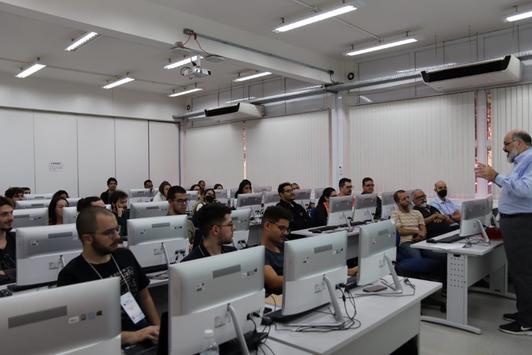
Snapshots from mini symposium “Topics in Machine Learning: A Theoretical and Hands On Approach”

Expanding Access: By implementing customized equipment for education and research, this project broadened opportunities for small research groups in Brazil, particularly in underserved regions. The provision of free or affordable access to high-quality scientific tools, combined with hands-on training for students, is helping to reduce educational disparities and strengthen the country’s scientific ecosystem.

Publications:
"Correspondence Analysis of Government Expenditure Patterns" (��Link)
“Generalizing Correspondence Analysis for Applications in Machine Learning” (��Link)
“Generalization Bounds for Noisy Iterative Algorithms Using Properties of Additive Noise Channels“ (��Link)
“An Information-Theoretic View of Generalization via Wasserstein Distance” (��Link)
Harvard Lead: Venkatesh Murthy (FAS)
Brazil Leads: Grace S. Pereira Moraes and Márcio F D Moraes (Universidade Federal de Minas Gerais)
LBRF Grant: 2022
Timeline: 2022–ongoing
Location: Belo Horizonte (MG)
The project contributed to 3 UFMG doctoral dissertations and training of 1 master’s student and 1 undergraduate
5 new grant proposals have been submitted by the research group

Overview: Contemporary research depends on advanced technologies that are costly and scarce in Brazil, but open-source tools and FabLabs in highincome countries have enabled innovation at significantly lower costs. This project sought to establish a FabLab at the Brazilian partner university to facilitate the development and exchange of advanced neuroscience technologies for research and education. By bringing together researchers with diverse technical backgrounds in a shared space equipped for prototyping and repairing instruments, the initiative aimed to foster innovation and practical solutions for advancing neuroscience.

“Th[is] was the first time our research group received an investment of this magnitude to develop research. Most grant opportunities from abroad do not focus on Brazilian-specific problems as the LBRF does. Therefore, this project increased the accessibility to knowledge for small research groups in Brazil. By implementing customized equipment for education and research, the project may reduce educational disparities, particularly in regions where resources are scarce, by providing free or affordable access to quality science.”
— Grace Schenatto Pereira Moraes

Technology Transfer: The project delivered methodological training and research tools to teams led by Maria Elisa Calcagnoto (UFRGS, Porto Alegre), Olagide Castro (UFAL, Maceió), and Gustavo Rodrigues Pedrino (UFG, Goiânia).
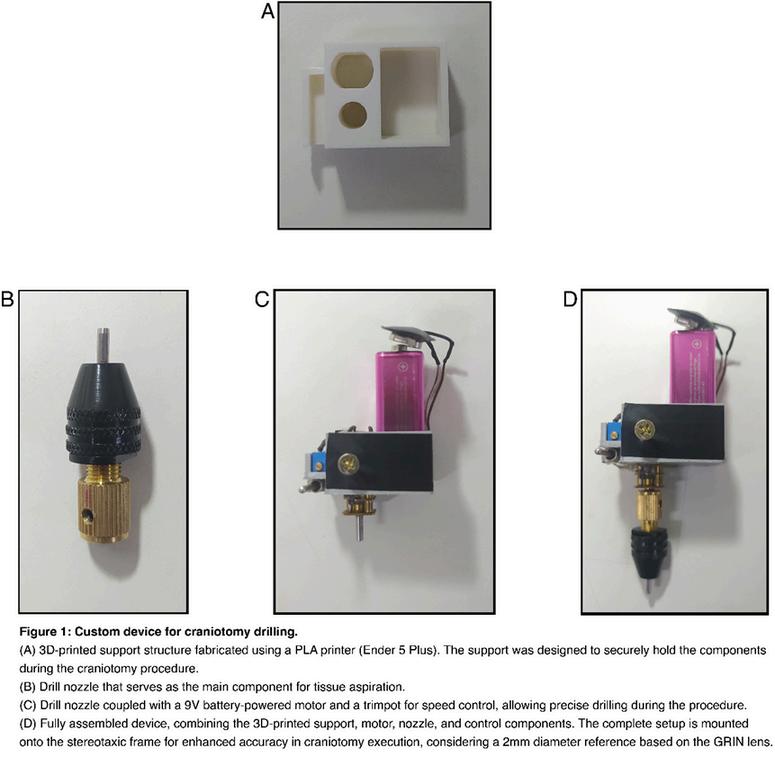
Participated in roundtable discussions at national scientific society meetings in Brazil with representatives from the secretary of science and technology Presented FABLAB-developed solutions at the Brazilian Meeting of Neurosurgery Delivered outreach presentations during Brain Awareness Week (2023, 2024) to a general audience of approximately 1,000 people



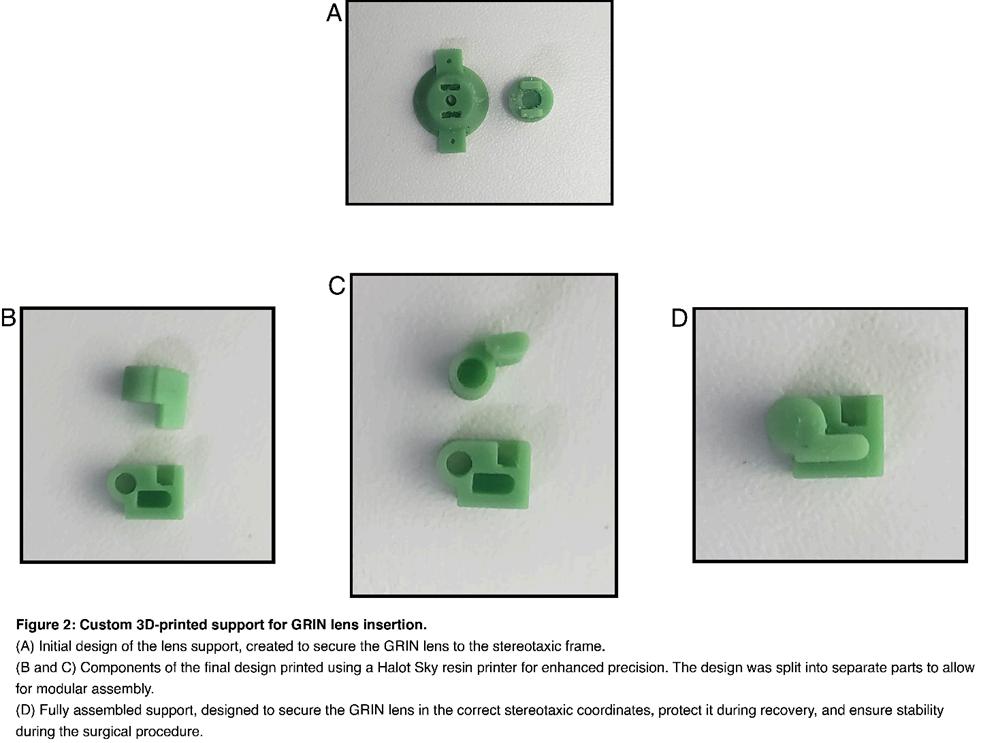

Gaining Recognition: “After the project, we became recognized as a research group reference in this technology in Brazil, and several collaborators approached us to visit our lab and receive instructions to build their own systems.” —Pereira Moraes
Access Expansion and Capacity Building: This project broadened scientific access for smaller research groups in Brazil by developing affordable custom equipment for education and research, aiming to reduce inequalities in underresourced areas. Additionally, providing hands-on training in these technologies to undergraduate and graduate students is expected to further strengthen and expand the impact of Brazil’s scientific community.

Meredith Rowe describes the LBRF projects she has worked on at a reception at the Harvard Graduate School of Education
Human development takes place in several settings, including in households and public service settings. These projects address important questions that directly impact the health, well-being, and learning of Brazilian children, particularly those from lower socioeconomic backgrounds.
















Harvard Lead: Charles Nelson (HMS & HGSE)
Brazil Lead: Edson Amaro Jr (Instituto PENSI)
Others: Nathan A. Fox (University of Maryland) and Charles H Zeanah (Tulane University School of Medicine)
LBRF Grant: 2018
Timeline: 2017–ongoing
Location: São Paulo (SP)
Additional Support:
Fundação José Luiz
Egydio Setúbal, Fundação
Maria Cecília Souto Vidigal, USAID, Lumos Foundation, InterAmerican Development Bank, Harvard DRCLAS Brazil Office, Instituto Alana, Two Lilies Fund

Overview: Building off the Bucharest Early Intervention Project (BEIP) (��Link), one of the most influential studies in the field of early childhood development, the BEIP research team partnered with researchers, nonprofits, and public authorities in Brazil to create the Early Institutionalization Intervention Impact (EI-3) Project (��Link). The main goal of EI-3 is to comprehensively document and compare the impacts that enhanced institutional care and enhanced foster care have on development during early childhood.


Nonprofit Partnerships: In addition to the research institutions and funders, EI-3 has partnered with the following organizations on the project implementation:
Associação Beneficente Santa Fé (��Link)
LALEC (��Link)
Instituto Fazendo História (��Link)

Public Sector Partnerships: EI-3 has established cooperation agreements with several public organs: Tribunal de Justiça do Estado de São Paulo (��Link)
Ministério Público do Estado de São Paulo (��Link)
Secretaria Municipal de Assistência e Desenvolvimento Social de São Paulo (��Link)


Methodology: The courts refer children, up to 24 months of age, who have been removed from the care of their biological families and are under the care of the state. These children are enrolled as participants in the study and randomly assigned to either the enhanced institutional care group or enhanced foster care group. Caregivers of both groups receive the Attachment Video-feedback Intervention (AVI), designed to enhance caregiving practices. Data collection occurs with both study groups and a community control group.
Progress by the Numbers:
74 babies have been enrolled in the study
61 baseline assessments completed
38 follow-up assessments after the AVI caregiving intervention
24 follow-up assessments at 12 months of age
6 follow-up assessments at 24 months of age
1 follow-up assessment at 36 months of age
43 AVI caregiving interventions completed
10 foster families linked to LALEC
13 foster families linked to Santa Fe
+25 SAICAS have received participants

Brazil’s legislation prioritizes foster care for children cared for by the state, but the availability of foster care families and services is insufficient
Potential for Impact: If findings align with evidence from other settings, they could help prioritize foster care initiatives and support a national shift in child welfare policies toward family-based care. More broadly, the project seeks to improve outcomes for at-risk children in Brazil by guiding policy reform, enhancing care practices, and addressing the developmental risks linked to institutionalization.
Harvard Leads: Meredith Rowe and Tiffany Yang (HGSE)
Brazil Leads: Guilherme Vanoni Polanczyk, Fernanda Alarcão, and Renata Amável (Universidade de São Paulo Medical School)
LBRF Grant: 2018
Timeline: 2018–2020
Location: São Paulo (SP)
Additional Support:
Fundação Maria Cecília
Souto Vidigal

Overview: This project examined how much and what kind of language mothers in a low-income urban area of Brazil use when engaging in play with their 12-month-old children. The researchers explored potential factors that contribute to variations in maternal communication styles; identified aspects of maternal speech and gestures to babies at 12 months that are linked to children's cognitive development at 24 months; and compared parental language input in Brazil to that of U.S. parents to better understand cross-cultural similarities and differences.


Technology Transfer and Capacity Building: A Brazilian postdoctoral researcher and master’s student spent time at Harvard for training in the methods used to code and process data from videotaped parent-child interactions. Upon return to Brazil, they hired several undergraduate researchers and trained them in such methods so they could help to code and process the project’s data.

Key Findings: The study found that by 12 months of age, roughly half of the children in the São Paulo group used pointing gestures during interactions with their mothers. Children who pointed were more likely to have parents who communicated more actively through both speech and gestures, and these children showed more advanced language skills by 24 months.

Cross-Cultural Comparisons: The study revealed similar patterns in Boston and São Paulo: early pointing, parental engagement, and later language development were consistently connected. However, the overall frequency of parent-child interaction differed by culture, with mothers in Boston engaging more often. These variations may relate to educational differences, as the Boston parents had, on average, higher levels of formal education than those in São Paulo.


Actionable Insights: The study revealed that even within a very low-income group of mothers and infants in São Paulo, there were noticeable differences in how mothers interacted with their children and in the children’s early communication abilities—both of which were linked to later language development. These insights offer a valuable foundation for developing programs aimed at supporting parents in enhancing their children’s early language environments and learning trajectories.
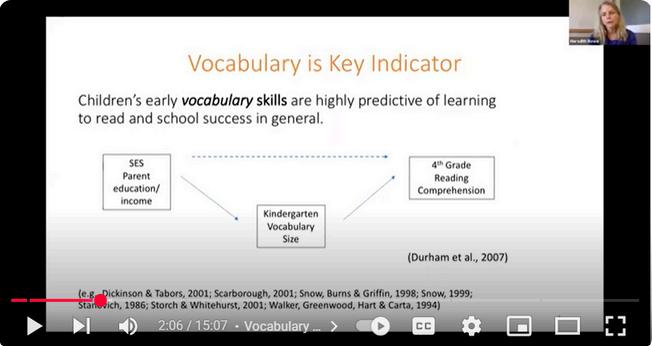

Overview: This research project aims to support early childhood development in low-income communities by helping parents of young children (ages 0–5) better understand how to promote language and communication at home. Researchers created an 11week group program for parents, delivered at local government social assistance centers (CRAS). The program focuses on improving how parents interact with their children through talking and play. Its impact will be tested by comparing families who participate with those who don’t, to see if the program boosts parenting skills and children's language development.
Harvard Lead: Meredith Rowe (HGSE)
Brazil Lead: Guilherme
Irffi (Universidade Federal do Ceará)
Other: Flávio Cunha (Rice University)
LBRF Grant: 2020
Timeline: 2020–ongoing
Location: Caucaia (CE)
Additional Support: FUNCAP, CNPq
2 doctoral students and 2 master’s students have gained important research experience through the project



Contents of the parenting program intervention
The Challenge: “The quality of the home environment in low-income areas in Brazil is low. Almeida et al. (2020) show that the Home Observation for the Measurement of the Environment (HOME) score for children in lowincome households in Ceara, Brazil (the location of this project) is nearly 2.8 standard deviations below the USA mean. Further, interventions in developing countries that improve disadvantaged children’s environments cause improvements in child development (e.g., BakerHenningham & Boo, 2010). For this reason, the development of scalable programs focused on improving low-income children’s environment is significant for the promotion of human development in many different regions of Brazil.”
Abstract of poster session at Society for Research in Child Development (��Link)

The Intervention: The program teaches parents how to support their young children's language development through meaningful daily interactions. Parents learn the importance of talking, reading, and playing with their children to build vocabulary and communication skills. Each weekly session includes guidance, group discussions, and practical activities that parents can try at home. The program also provides materials to support learning, aiming to strengthen both child development and family bonds.


Preliminary Feedback: The researchers have received positive feedback from the families enrolled in the program. The evaluation instruments have suggested that they like the program. One mother said: “As it was shown to parents, we can develop learning with our children in almost everything.” Another wrote: “I liked learning how we can use simple everyday things to teach our children.”
“Leading the project in Ceará has been an enriching and transformative experience. Training new researchers and equipping them to serve as facilitators and observers has proven to be exceptional. This process involves not only transmitting knowledge about parenting but also practicing observation and critical analysis skills, which are essential for understanding family dynamics and the program's impact on communities.
Facilitators play a crucial role in implementing the curriculum, developing a repertoire that meets the specific needs of parent and caregiver groups. During sessions, they create a welcoming and participatory environment that encourages the exchange of experiences. This interaction between facilitators and participants transforms into a safe space where parents and caregivers can share their doubts and challenges, strengthening their bonds and promoting a sense of community that respects the cultural and social diversity of Ceará.
The project's impact has been evident both in the lives of facilitators/observers and in parents and caregivers who engage in more meaningful conversations with children, contributing to early childhood language development.”
Guilherme Irffi
Harvard Lead: Nadine Gaab (HGSE)
Brazil Leads: Júlia Beatriz Lopes-Silva (Universidade Federal de Minas Gerais) and Cíntia Alves Salgado Azoni (Universidade Federal do Rio Grande do Norte)
LBRF Grant: 2021
Timeline: 2021–ongoing
Location: Nationwide
13 presentations at academic conferences
3 master’s theses and 2 doctoral dissertations were written on the project
Additional Support: UFMG, UFRN, Instituto Santos Dumont

Overview: This project sought to understand the availability of literacy resources and activities in Brazilian households and how sociodemographic factors influenced these practices. Initial data collection involved a large-scale online survey, complemented by in-person assessments to reach underrepresented low-income families. By focusing on family literacy, especially during a crisis that moved education into the home, the study fills a critical gap in early childhood development research in Brazil and contributes directly to educational and public health policy discussions.
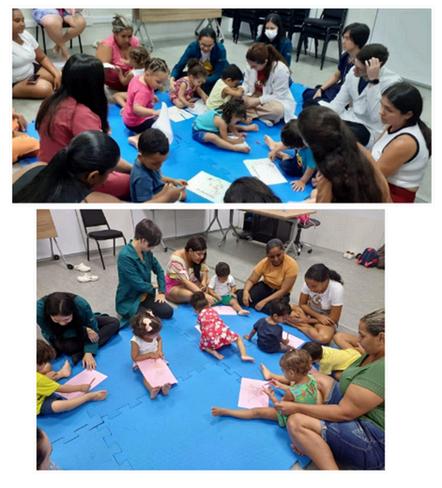
Event at a Quilombola community in Macaíba (RN) to talk about the importance of home literacy

A guidance group implemented by the Instituto Santos Dumont for mothers with children between 0–3 years old
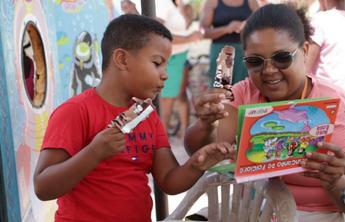
Scope of the Study: The study surveyed over 1,000 Brazilian families through an online questionnaire and conducted in-person assessments with 113 families from lower socioeconomic backgrounds to examine the effects of COVID-19 restrictions on home literacy practices.
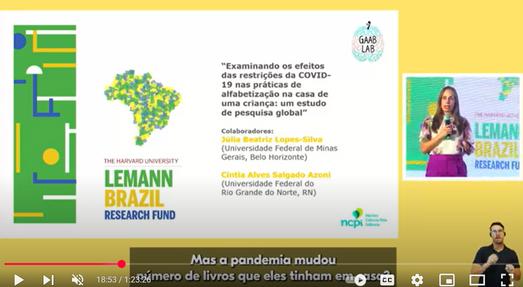

Key Findings:
Pandemic Shifts: Digital reading and educational games increased for children without learning risks; households with risks saw decreases in access to print materials.
Socioeconomic Drivers: Higher caregiver education levels and more caregivers at home were linked to better literacy environments.
Family Risk Disparities: Children with a family history of learning difficulties had fewer books and engaged in fewer shared literacy activities—widening preexisting gaps.
Sampling Improvement: Transitioning from online to in-person surveys improved representation of lower-income, lower-literacy households.

Policy Impact and Community Engagement: The findings of this project have begun to influence local educational policy and community programming:
Educational Materials: An open-access e-book for parents promotes best practices in home literacy.
Community Initiatives: Prof. Cíntia Salgado
Azoni led outreach in the Quilombola community “Capoeiras” with book donations and literacy workshops.
Institutional Integration: The Santos Dumont Institute launched a home literacy guidance program for mothers of young children, building directly on project findings.
Public Awareness: Team members engaged in interviews, public lectures, and educational campaigns, raising awareness about literacy during school disruptions.

e-book for parents and caregivers that details the importance of family literacy practices (��Link)


















Harvard Leads: Marcia Castro, Mary E Wilson, Sarah F. McGough, and Benjamin MacCormack-Gelles (HSPH)
Brazil Leads: Monica Viegas Andrade, Lucas Resende de Carvalho, and Julia Almeida Calazans (Universidade Federal de Minas Gerais), Cláudio José Struchiner (Universidade do Estado do Rio de Janeiro & Fundação Oswaldo Cruz)
LBRF Grant: 2016
Timeline: 2016–2020
Location: Fortaleza (CE) and Nationwide
Additional Support: Fundação de Ciência, Tecnologia e Inovação (CITINOVA)
The project contributed to 1 doctoral dissertation and 2 master´s projects
Presentations in seminars, lectures, conferences, and courses, including at Harvard and in Brazil

Overview: This project examined the economic impact of arboviruses—specifically dengue—in Brazil, where these diseases remain underaddressed despite their increasing prevalence. The study assessed denguerelated costs from 2010 to 2015 across all 26 states, validated through consultations with local authorities, and highlighted gaps in national epidemic response strategies and economic assessments.

Methodology: The team compiled data on different expenditures, hospital and lab procedures, personnel involved in treatment, lost work and school days, vector control expenses, figures on cases, deaths, and hospitalization, and geocoded data supported by Harvard’s Center for Geographical Analysis.

Monthly categorization based on dengue transmission intensity and rainfall levels in Fortaleza from 2011 to 2015

Key Findings: The study revealed clear differences in dengue transmission between epidemic and nonepidemic years, with important consequences for vector control planning. It provided the most extensive analysis to date of entomological surveys in Brazil (2009–2015) and Fortaleza (2012–2015), finding them unreliable for predicting outbreaks—a critical insight given their mandated nationwide use since 2017. Using georeferenced data from over 230,000 arbovirus cases in Fortaleza (2011–2017), the research mapped how dengue, Zika, and chikungunya circulate together. Finally, the study examined how specific points maintain dengue transmission in major Brazilian cities.


Capacity Building: This project played a vital role in training emerging researchers from both the United States and Brazil, equipping them for future roles in public health research and leadership. The project also elevated the profile of local researchers, sparking collaborations and enabling academic exchanges. One student joined a six-month exchange at Harvard under Marcia Castro’s mentorship. The project enhanced the international visibility of Brazilian researchers and institutions through publications in leading scientific journals. The researchers trained through this initiative have continued to support this work moving forward.
Impact on Policy and Practice: This work generated valuable insights that support improved strategies for arbovirus control, surveillance, and resource distribution. In Fortaleza, the initiative improved vector control efforts through hands-on training and data analysis support.
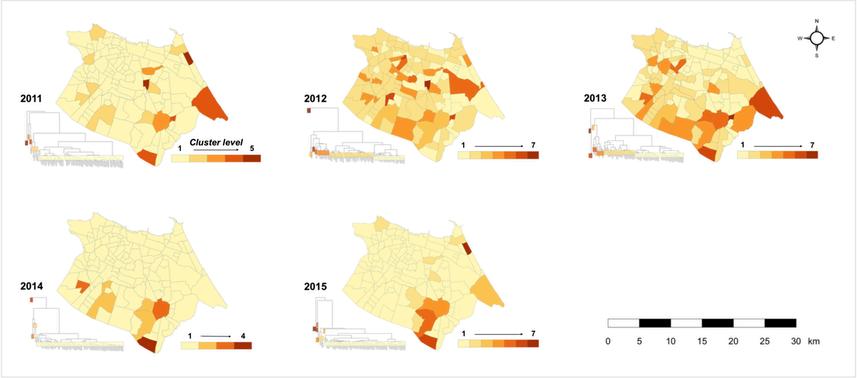

Follow-Up Funding for a Similar Study: This study was key to securing new funding from the Gates Foundation to study malaria's economic burden. That study yielded five manuscripts and validated methods reviewed with the Ministry of Health.

Publications:
"Epidemiological characteristics and determinants of dengue transmission during epidemic and non-epidemic years in Fortaleza, Brazil: 2011–2015." (��Link)
"Spatiotemporal transmission dynamics of co-circulating dengue, Zika, and chikungunya viruses in Fortaleza, Brazil: 2011–2017." (��Link)
"Infestation measured by Aedes aegypti larval surveys as an indication of future dengue epidemics: an evaluation for Brazil." (��Link)
Harvard Leads: Nicolas Menzies and Marcia Castro (HSPH)
Brazil Leads: Daniele Pelissari (Universidade de São Paulo), Patricia Bartholomay Oliveira and Denise Arakaki (Ministério da Saúde do Brasil); Ethel Maciel, Carolina Martins
Sales, and Adelmo Bertolde (Universidade Federal do Espírito Santo), Mauro Sanchez (Universidade de Brasília)
Other: Theodore Cohen (Yale University)
LBRF Grant: 2017
Timeline: 2017–ongoing
Locations: Brasília (DF), Nationwide
Journal Publications in:
Lancet Global Health
BMC Infectious Diseases
PLoS Med
PLoS Global Public Health Epidemics
Emerging Infectious Diseases
medRxiv
3 master’s theses have come out of the project

Overview: The team has undertaken several analyses to understand trends in Tuberculosis (TB) epidemiology to identify municipalities with high numbers of undiagnosed cases; describe patterns of care and gaps in the care continuum; and identify approaches to improve the coverage and quality of care in Brazil.


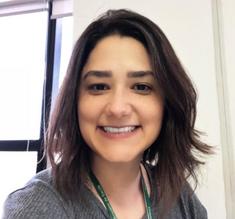
Avg. untreated TB/100,000/year in: “A spatialmechanistic model to estimate subnational tuberculosis burden with routinely collected data: An application in Brazilian municipalities”

Publications in Peer-Reviewed Journals:
“Long-term mortality trends among individuals with tuberculosis: a retrospective cohort study of individuals diagnosed with tuberculosis in Brazil” (��Link)
“Systematic differences in TB treatment outcomes across in [sic] Brazil by patient- and area-related factors: an analysis of national disease registry data” (��Link)
“High Mortality Rates Among Individuals Misdiagnosed With Tuberculosis: A Matched Retrospective Cohort Study of Individuals Diagnosed With Tuberculosis in Brazil” (��Link)
“Cost-effectiveness and health impact of screening and treatment of Mycobacterium tuberculosis infection among formerly incarcerated individuals in Brazil” (��Link)
“Predictors of unsuccessful tuberculosis treatment outcomes in Brazil: an analysis of 259,484 patient records” (��Link)
“Quantifying the impact of gaps in the TB care cascade in Brazil: A mathematical modeling calibrated to national program data” (��Link)
“A spatial-mechanistic model to estimate subnational tuberculosis burden with routinely collected data: an application in Brazilian municipalities” (��Link)
“Excess tuberculosis cases and deaths following an economic recession in Brazil: an analysis of nationally representative disease registry data” (��Link)
“Bayesian evidence synthesis to estimate subnational TB incidence: An application in Brazil” (��Link)
“Trends in Untreated Tuberculosis In Large Municipalities, Brazil, 2008–2017” (��Link)
Overview of one of the group’s publications in a media platform focused on informing public policies in Brazil (��Link)
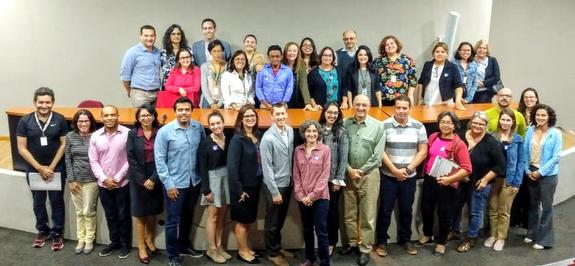

Policy Engagement: The project team meets monthly with the health and environment surveillance secretariat of the Ministry of Health, providing valuable expert input and understanding the ministry’s main priorities. This engagement helps the researchers to ensure they are working on problems of direct importance for public health in Brazil.

“Our research collaboration is healthy, active, incredibly valuable to all partners, and ongoing. ... The long-term impact of this work is a better understanding of the TB epidemic and disease-control options in Brazil, and a better-prepared workforce for answering these questions in the future.”
Nicolas Menzies
Harvard Lead: Ichiro Kawachi (HSPH)
Brazil Lead: Alexandre
Dias Porto Chiavegatto Filho (Universidade de São Paulo)
LBRF Grant: 2016
Timeline: 2016–2020
Location: São Paulo (SP)
Additional Support: FAPESP
Data Dissemination:
Media coverage in:
BBC Brazil
Jornal O Globo
O Estado de São Paulo
Findings presented at: FIOCRUZ
World Bank in Brasilia Ministry of Health Universities
This project contributed to 1 doctoral dissertation

Overview: This initiative explored surprising patterns in life expectancy across racial groups in Brazil, with an emphasis on underlying factors. It applied machine learning in an innovative way to correct racial misclassification on Brazilian death records, leading to more accurate life expectancy estimates by race and deepening insights into racial health inequalities.


Key Findings: The analysis revealed that in São Paulo, mortality rates are highest among Black individuals, followed by those of mixed race and then white individuals—findings that contradict official data and emphasize the influence of social conditions on mortality trends. The project highlighted both the importance of reliable data for public health and the promise of machine learning in epidemiological research, while also acknowledging the difficulties of implementing these methods in data-scarce areas. Additionally, the study showed that greater investment in primary health care is linked to increased life expectancy, whereas higher spending on secondary care did not yield the same benefit.

Capacity Building:
The project contributed directly to the PhD dissertation of Hellen dos Santos at the University of São Paulo, who has since become an assistant professor at Fiocruz
It supported the training and academic development of three master’s students and four doctoral candidates from the Big Data and Predictive Health Analysis Laboratory (LABDAPS) at USP
The research outputs also played a role in the promotion of Alexandre Chiavegatto Filho from assistant to associate professor at USP, highlighting his contributions to machine learning in public health

Adjusted mortality rates (deaths per 1,000 population) reveal higher death rates for Black and mixed-race elderly than shown in official data, highlighting racial misclassification in death certificates

Sustained Impact: This was a catalyst for new collaborative research between Harvard and the University of São Paulo, sparking studies on topics such as posttraumatic stress following natural disasters and predictive modeling for incomplete health data. These emerging partnerships are expected to yield additional scientific publications in the near future. Beyond this, the project’s methodological innovations laid a foundation for broader applications of artificial intelligence in evaluating public health system performance and guiding policy decisions. Finally, it highlighted the critical need to confront racial inequities in health data, offering a replicable framework for other multiracial societies seeking to better understand and address health disparities.

Publications:
“Overachieving Municipalities in Public Health” (��Link)
“Blurred lines: racial misclassification in death certificates in Brazil” (��Link)
“Cause-specific mortality prediction in older residents of São Paulo, Brazil: a machine learning approach” (��Link)
Harvard Leads: Marcia Castro, Jamie Ponmattam, Valerie Scott, and Sun Kim Hi (HSPH)
Brazil Leads: Marcia
Maria Tavares Machado (Universidade Federal do Ceará), Lucas Chaves Netto, (Faculdade de Medicina da Universidade de São Paulo), Antonio Silva Lima Neto (Secretaria Municipal de Saúde de Fortaleza), and Rafael Claro (Universidade Federal de Minas Gerais)


Overview: In anticipation of the Butantan Institute's dengue vaccine approval, this project evaluated public acceptance, potential barriers, and whether vaccination might reduce household mosquito control efforts.
Methodology: Prior to Brazil’s emergency use of the Takeda dengue vaccine, this study investigated public attitudes toward a hypothetical vaccine through qualitative focus groups and a phone survey with 6,000 participants in Belo Horizonte, Fortaleza, and São Paulo.


Timeline: 2020–2023
Locations: Fortaleza (CE), Belo Horizonte (MG), São Paulo (SP)
The project contributed to policy recommendations and 1 doctoral dissertation

Key Findings: The study found that participants were generally willing to receive a dengue vaccine if proven safe and effective. Many intended to maintain mosquito control due to concerns about other arboviruses like Zika and chikungunya, though some anticipated reduced effort postvaccination. These mixed responses reveal varying perceptions of risk and prevention responsibility.
Applications and Adaptive Insights: The findings provide a foundation for Ministry of Health campaigns, supporting targeted messaging that not only promotes vaccine uptake but also addresses shifts in personal prevention behaviors. Adaptations made during the COVID-19 pandemic expanded the study’s relevance, offering broader insights into vaccine hesitancy related to both dengue and COVID-19.



Capacity Building: The project engaged Harvard and Brazilian students in data collection, analysis, and community engagement. A Harvard PhD student gained hands-on experience with qualitative data, while a Brazilian graduate student led the fieldwork in Fortaleza. Together, their involvement laid the foundation for future academic contributions and ongoing collaborative efforts.
Linking Research and Education: Findings were integrated into Harvard courses on infectious diseases and global health, broadening their impact on education and student training.
Practical Integration: Results were shared with local officials and health practitioners throughout the project to support real-time policy decisions. These exchanges helped ensure the research was grounded in practical applications and relevant to on-the-ground decision-making.
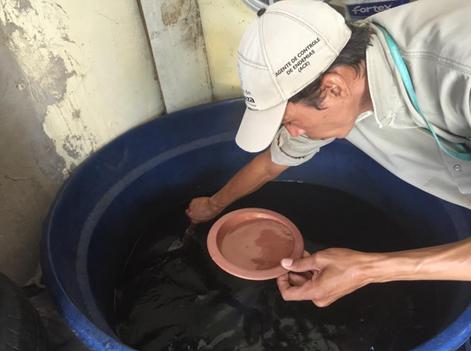



Impact on Institutions: The project significantly strengthened Brazilian universities by raising faculty visibility, inspiring emerging researchers, fostering new collaborations, and supporting academic exchanges with Harvard.
Impact on Policy: It also positively affected the Fortaleza population by influencing how the Municipal Health Secretariat approaches vector control, guided by project findings. On a broader level, the research has strengthened Brazil’s ability to design context-specific interventions that align with public sentiment and behavior.

Publications:
“Acceptability of a hypothetical dengue vaccine and the potential impact of dengue vaccination on personal vector control behavior: a qualitative study in Fortaleza, Brazil” (��Link)
“Acceptance of a dengue vaccine and potential change in vector control behavior” To be published in: International Society for Infectious Diseases IJID Regions
Harvard Lead: Aisha Yousafzai (HSPH)
Brazil Leads: Anya VieiraMeyet (Centro Universitário Christus & FIOCRUZ), Ana Patrícia Pereira Morais (Universidade Estadual do Ceará & FIOCRUZ), José Maria Ximenes
Guimarães and Maria de Fátima S. Antero (Rede Nordeste de Formação en Saúde da FamíliaFIOCRUZ), Sidney Feitoza Farias (FIOCRUZ), Franklin Delano S. Forte (Universidade Federal da Paraíba), Claudete Ferreira de Souza
Monteiro (Universidade Federal do Piauí & Rede Nordeste de Formação en Saúde da FamíliaFIOCRUZ), Maria Rosilene
C Moreira and Milena
Silva Costa (Universidade Federal do Cariri), and Maristela Inês Osawa Vasconcelos (Universidade Estadual do Vale do Acaraú)

Overview: This collaborative project examines how community violence and the COVID-19 pandemic have affected Brazil’s Community Health Agents (CHAs)—the frontline of primary care in vulnerable regions.
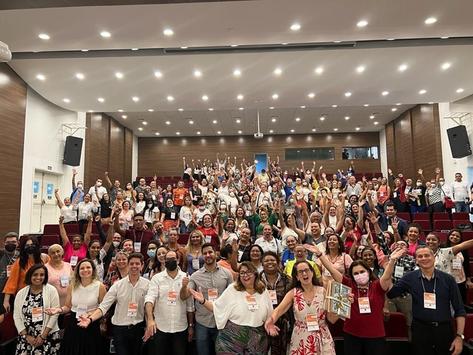

Conducted across eight municipalities in Northeastern Brazil, the study uses a mixed-methods, participatory approach to explore the mental health, working
Workshop with CHAs regarding their experiences with violence, the pandemic, wellness, and community health care
Innovations and Interventions:
Participatory Research Model: CHAs were not only study subjects but active contributors in all phases —creating a model of embedded participatory public health research.
Community Feedback Workshops: Held in each site, these workshops validated findings locally and catalyzed immediate dialogue between researchers, health workers, and policy stakeholders.
Pilot Training Program: A course titled “Caring for Conflicts and Prevention of Violence in Territories” was delivered to CHAs in Fortaleza, combining modules on self-care, conflict mediation, and resilience strategies. Evaluations showed strong uptake and demand for scale-up.
Online Self-Care Course: This course promotes non pharmacological stress management techniques like somatic movement and mindfulness—providing long-term psychosocial support for CHAs. As of May 12, 2025, there were more than 3,200 people enrolled in the course. (��Link)
Timeline: 2021–ongoing
Locations:
7 presentations at academic conferences
Additional Support: Fiocruz INOVA, PMA, FUNCAP

Mental Health Crisis Among CHAs: High exposure to violence and pandemicrelated challenges significantly worsened mental health outcomes, with higher prevalence of anxiety, stress, and burnout in more vulnerable areas.
Impact on Service Delivery: Violence and fear restricted CHAs' ability to conduct home visits and community-based care, compromising primary healthcare access and effectiveness.
Complex Lived Experiences: Qualitative narratives underscored the emotional toll of working in their own violence-stricken neighborhoods, revealing the strain of balancing professional obligations and personal safety.
Inequitable Impact: The effects of violence and COVID-19 were not uniform— regions with higher socioeconomic vulnerabilities faced more severe disruptions to health services and greater psychological harm among workers.
The project’s research website details all of its findings (��Link)
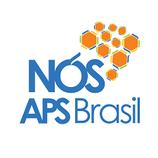

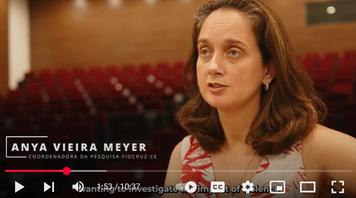
Capacity Building and Collaborations:

Atlas written based on the project’s research data (��Link)

Involved a diverse research consortium across nine Brazilian institutions, boosting methodological and technical skills in mixed-methods public health research. Mentored over a dozen students, including undergraduates, master’s, and PhD candidates; several used the study as the basis for theses and dissertations.
Publications in Peer-Reviewed Journals:
“Quality of life and associated factors for community health workers in the context of the COVID-19 pandemic in northeastern Brazil” (��Link)
“Processo de trabalho do agente comunitário de saúde: análise da influência da violência urbana e da COVID-19” (��Link)
“Gender and Violence in the Daily Routine of Community Health Workers in Fortaleza, Brazil” (��Link)
“Violence in the neighborhood and mental health of community health workers in a Brazilian metropolis” (��Link)
“Mental health of community health workers in the COVID-19 context.” (��Link)
“Community health workers perspective on the COVID-19 impact on primary health care in Northeastern Brazil” (��Link)
“Violence and vulnerability of the Community Health Worker in the territory: implications for tackling COVID-19” (��Link)
Harvard Leads: David Williams and Todd G. Reid (HSPH)
Other: Alex Sandy Pentland (MIT Media Lab)
Brazil Lead: Valdemir Ferreira-Junior (Universidade Federal de São Paulo)
LBRF Grant: 2021
Timeline: 2021–ongoing
Location: São Paulo (SP)

Overview: This project aims to understand how the COVID-19 pandemic has impacted mental health— specifically pyschosocial stress, anxiety, and depression—in underserved communities in Brazil. By integrating smartphone-based behavioral data with large-scale geospatial datasets, the study will assess how social and economic inequalities intersect with the mental health crisis triggered by the pandemic.


David Williams is a prominent scholar of the social sciences and is recognized as the most cited black scholar in the social sciences in the United States His work addresses the impact of race, racism, socioeconomic status, and stress on health He developed the Everyday Discrimination Scale, one of the most widely used tools for measuring perceived discrimination in health research
The Challenge: Brazil, one of the hardest-hit countries by COVID-19, faces a confluence of health vulnerability and entrenched socioeconomic inequality. Underserved populations—particularly low-income communities of color—experienced higher infection and mortality rates and face increased mental health burdens due to job insecurity, overcrowded living conditions, lack of access to care, and systemic discrimination. Existing data sources and mental health interventions have been inadequate in capturing or addressing this reality.

Innovation for Equity: This is a pioneering effort to merge big data and behavioral science, and to support more equitable health policy and infrastructure in Brazil.

Methods: The study employs a mixed-methods, multimodal approach:
Smartphone Application: Participants from São Paulo peripheral urban communities (comunidades) will use a custom app to provide passive (opportunistic sensing from GPS and phone usage) and active (participatory collection of mood, survey responses, discrimination reports) data.
Digital Phenotyping: Behavioral data such as mobility, social interaction, and screen time will help infer mental health trends.
Geospatial Big Data: Location-based smartphone app data from hundreds of thousands of users will be analyzed to map inequality and social network characteristics using tools like MIT’s "Atlas of Inequality."
Participants: Recruited via Brazil’s Centers of Reference for Social Assistance (CRAS), ensuring a focus on vulnerable families (e.g., Bolsa Família beneficiaries).



Expected Outcomes include:
Identifying Mental Health Risks: By linking behavioral patterns and environmental stressors, the study identifies predictors of despair and emotional vulnerability.
Community-Level Insights: Results will show how social networks, sense of community, and structural inequality influence mental health.
Intervention Design: Findings will inform community-based and tech-enabled interventions and shape public health strategies.
Policy Engagement: Results will be shared with Brazilian policymakers to advocate for targeted mental health resources and structural reforms.
Harvard Leads: Xuehong
Zhang and Edward Giovannucci (HSPH)
Brazil Leads: Renata Bertazzi Levy and Maria Alvim Leite (Universidade de São Paulo), Leandro F M. Rezende (Universidade Federal de São Paulo)
LBRF Grant: 2022
Timeline: 2022–2025
Location: São Paulo (SP)
Additional Support:
Brazilian Ministry of Health; CNPq; FAPESP; Umane
Conference Presentations:
Postdoctoral Congress, University of São Paulo
XX Latin American Nutrition Congress
World Public Health Nutrition Congress
12th Brazilian Congress of Epidemiology
1 more research article is currently under review

Overview: Obesity and overweight affect Brazilians across all ages and income levels, with over 60 percent of adults overweight and 26 percent obese as of 2019. Diets high in ultra-processed foods have been associated with increased weight gain, but most evidence comes from high-income countries using methods not tailored to identify these foods. This study explores the link between ultraprocessed food intake and weight gain in Brazilian adults, with the goal of supporting policies for healthier and more sustainable eating habits in Brazil.
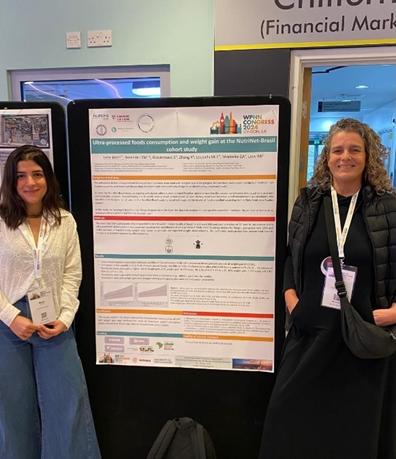

Methodology: This study included 23,893 adults from the NutriNet-Brasil cohort who completed two Nova24h dietary recalls at baseline and were followed for a median of 35 months. Ultraprocessed food intake was expressed as a percentage of total energy intake. Weight gain was defined as an increase of ≥5 percent or ≥10 percent from baseline, based on self-reported weights over time. Associations were examined using Cox proportional hazards models with stratified analyses.

Key Findings: The study found that people who consumed a higher share of their calories from ultra-processed foods were more likely to gain weight—even when overall diet quality was taken into account.
Every 10 percent increase in ultra-processed food intake increased the risk of gaining at least 5 percent of body weight by 6 percent and increased the risk of gaining at least 10 precent of body weight by 9 percent.
As compared to the lowest quintile (less than 11.7 percent of calories from ultra-processed foods), those with the highest intake of ultra-processed food (over 34 percent of calories) had a 26 percent higher risk of moderate weight gain and a 41 percent higher risk of major weight gain.

Capacity Building: This project supported Maria Alvim Leite in completing her postdoctoral research as part of the study.

Institutional Impact: The funding also supported the development of robust digital and administrative systems, ensuring high-quality, secure, and sustainable data. These contributions go beyond the initial research, leaving a legacy for NutriNet-Brasil and encouraging future studies and collaborations.

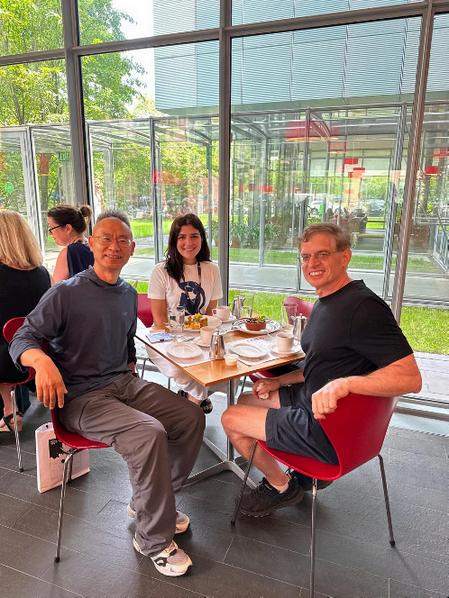
Policy Relevance: This project enhanced understanding of the link between ultraprocessed food consumption and weight gain in Brazilian adults, using an innovative tool to assess diets based on processing levels. Its findings can inform public policies that promote healthier eating and reduce dependence on ultraprocessed foods.

Publications:
“Nova diet quality scores and risk of weight gain in the NutriNet-Brasil cohort study” (��Link)
“O83 Prospective Association of Ultra-Processed Food Consumption and Weight Gain in Young Adults at the NutriNet-Brasil Cohort Study” (��Link)
Harvard Lead: Bernardo Lemos (HSPH)
Brazil Lead: Raquel da Hora Barbosa (Universidade Federal Fluminense)
LBRF Grant: 2019
Timeline: 2019–2022
Locations: São Paulo (SP), State of Paraná
Additional Support: FAPESP, National Council for Scientific and Technological Development, National Institute of Environmental Health Sciences (NIEHS)
2 New Grant Proposals have been prepared by the research group for projects focused on Alzheimer´s disease and cancer

Overview: The project aimed to achieve two main objectives:
1.Create innovative biological aging clocks for eye and retinal tissues
2.Use these aging markers, along with other aging-related biomarkers, in studies focused on neurodegenerative diseases and cancer

The nucleolus as a central hub for nuclear organization and the integration of diverse nuclear activities and regulatory pathways

Capacity Building:
Strengthened local research capacity by training Brazilian students and early-career scientists, many of whom return to continue working in Brazil
Enabled the transfer of technical skills and expertise to Brazilian institutions through training and experience in Dr. Lemos’s lab and at Harvard
Propelled three Brazilian students into PhD programs (including one at Harvard)

Key Outcomes: The team successfully created a new aging clock tailored to eye and retinal tissues. Notably, this clock was found to detect different stages of agerelated macular degeneration. Support from the project also helped broaden collaborations with Brazilian researchers, including exchange visits to Lemos’s lab.

Real-World Application: The team partnered with Brazilian researcher Carolina Panis to apply its newly developed aging clocks in studying the potential link between pesticide exposure and breast cancer in western Paraná This agricultural region, known for being Brazil’s highest consumer of pesticides, has widespread drinking water contamination that exceeds safety thresholds set by the U.S. Environmental Protection Agency and the European Union Notably, the region also reports some of the highest breast cancer rates in the country.

Geographic distribution of pesticide contamination in drinking water and associated breast cancer incidence in Paraná, Brazil

Publications:
“Ribosomal DNA and the nucleolus as keystones of nuclear architecture, organization, and function” (��Link)
“Post-transcriptional diversity in riboproteins and RNAs in aging and cancer” (��Link)
“Exposure to an environmentally relevant phthalate mixture during prostate development induces microRNA upregulation and transcriptome modulation in rats” (��Link)
“Widespread pesticide contamination of drinking water and impact on cancer risk in Brazil” (��Link)

Overview of Malaria Project: This project focused on identifying T cell epitopes—small protein fragments recognized by the immune system—that are shared across different stages of the malaria parasite’s lifecycle and conserved between Plasmodium vivax and P. falciparum.
Harvard Lead: Judy Lieberman (HMS)
Brazil Lead: Caroline Junqueira (Instituto René Rachou - FIOCRUZ)
LBRF Grants: 2019, 2021
Timeline: 2019–ongoing
Locations: Salvador and Ilhéus (BA), Porto Velho (RO), FIOCRUZ (MG), Lieberman Lab (Harvard)
Additional Support: NIH, Amazonian Center of Excellence in Malaria Research, FAPEMIG. FAPESP, CNPq, CAPES
Two Brazilian researchers, including one PhD candidate, were hosted at the Lieberman Lab as part of the project

Key Findings: Using a mouse model and blood samples from infected patients in Brazil, the research team successfully pinpointed multiple conserved epitopes recognized by human T cells.

Significance: These discoveries are especially promising for vaccine development, as current malaria vaccines offer limited and species-specific protection. The ability to target universally recognized T cell antigens could lead to a more broadly protective and effective malaria vaccine.

Pivot to COVID-19: During the pandemic, the research team initiated a complementary study on COVID-19. They explored how SARS-CoV-2 causes severe inflammation.

Key Findings: The team discovered that the virus can infect blood monocytes when aided by antibodies, triggering the immune system’s inflammasome pathway. This results in pyroptosis—an inflammatory form of cell death—which may contribute to the dangerous overactive immune response in some COVID-19 patients.

Significance: Importantly, these findings led to a clinical trial in Bahia, testing whether an antiinflammatory drug (disulfiram) could improve outcomes in hospitalized patients. The project offered crucial insights into COVID-19 disease mechanisms and highlighted the role of antibodymediated infection of immune cells in driving severe illness.

Capacity Building: This multidisciplinary team of researchers created an initiative that was instrumental in training emerging scientists through hands-on experience in basic research, advanced methods, and critical thinking. Participants gained valuable skills through lab exchanges, networking, and collaboration, with many advancing to graduate programs or competitive postdoctoral positions.

Critical Resources and Awareness: The LBRF was instrumental in securing national funding for research on COVID-19 and malaria, contributing to the strengthening of Brazil’s scientific infrastructure. Beyond its direct research impact, the project also raised awareness among Brazil’s scientific and policy communities about the critical role of basic science and global partnerships in addressing pressing health challenges. At a time when domestic funding was severely limited, this external support was crucial for sustaining scientific training and COVID-19 research in Brazil.

The research team has produced multiple high-impact publications in some of the world’s most prestigious scientific journals

Boston Children’s Hospital Features:


Episode on the Immunology Podcast (��Link)
"Specialized T cells protect against the deadliest form of malaria" (��Link)
“How COVID-19 triggers massive inflammation” (��Link)
Peer Reviewed Publications:
“γδ T cells suppress Plasmodium falciparum blood-stage infection by direct killing and phagocytosis” (��Link)
“SARS-CoV-2 infects blood monocytes to activate NLRP3 and AIM2
inflammasomes, pyroptosis and cytokine release” (��Link)
“FcγR-mediated SARS-CoV-2 infection of monocytes activates inflammation” (��Link)
“Inflammasome activation in infected macrophages drives COVID-19 pathology” (��Link)
Harvard Leads: Wendy Garrett (HSPH)
Brazil Lead: Rossana Melo (Universidade Federal de Juiz de Fora)
Others: Peter F. Weller (Beth Israel Deaconess Hospital)
LBRF Grant: 2021
Timeline: 2021–2024
Location: Juiz de Fora (MG)
7 Presentations at Academic Conferences
Additional Support:
Conselho Nacional de Desenvolvimento
Científico e Tecnológico, Fundação de Apoio à Pesquisa do Estado de Minas Gerais

Overview: This research project investigated how eosinophils—specialized white blood cells involved in allergic reactions and inflammation—respond to SARS-CoV-2, the virus behind COVID-19. The study focused on understanding their role in the body’s early immune response and whether they contribute to fighting the virus or worsening inflammation. The team used 3D tissue-like cell cultures and highresolution electron microscopy to analyze immune responses in both laboratory models and patient data.


Methodology: The team created 3D mini-lung models using human cells to closely mimic how actual lung tissue reacts to COVID-19. These models were then infected with the SARS-CoV-2 virus and carefully monitored for signs of inflammation, immune response, and cell damage. To understand the role of eosinophils, researchers added these immune cells— taken from human blood—to the infected models and observed how they behaved. Advanced electron microscopes provided ultra-detailed images of the cells, revealing structural changes that aren’t visible with regular lab tools. In parallel, the team analyzed blood test results from over 200 hospitalized COVID19 patients in Brazil, comparing eosinophil levels with survival and recovery outcomes.

Key Findings:
Eosinophil Activation: Eosinophils exposed to SARS-CoV-2 became activated and released cytokines via piecemeal degranulation, a controlled secretion process.
No Viral Replication in Eosinophils: The virus did not replicate inside eosinophils, suggesting these cells respond to infection but do not serve as viral hosts.
Immune Evasion by the Virus: SARS-CoV-2 inhibited the formation of extracellular DNA traps (ETs) by eosinophils, a possible mechanism of immune evasion.
Clinical Relevance: A study of 202 hospitalized COVID-19 patients in Brazil found that persistently low eosinophil counts were linked to death, while recovering patients showed rising eosinophil levels.
Prognostic Biomarker: Eosinophil levels at discharge could be used as a simple, costeffective biomarker to assess COVID-19 recovery or risk of fatal outcomes.

Capacity Building: The project played a significant role in advancing the careers of early-stage researchers in Brazil. It offered hands-on research experience and mentoring across institutions, contributing to long-term professional growth and collaboration.
Thiago Silva became an adjunct professor at UFJF. Kassia Malta completed her PhD and began a postdoctoral position in Melo’s lab. Kennedy Bonjour joined the Pasteur Institute in France. PhD candidates Vitor Neves and Cinthia Palazzi developed dissertations based on the project’s findings. Undergraduate students Felipe Kneip and Yasmin Aguiar progressed to MSc programs at UFMG. The project also helped spark new collaborations and expanded Brazil’s research networks in immunology and infectious diseases.

Publications in Peer-Reviewed Journals:
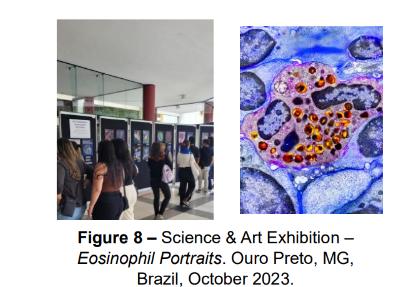

Research presented at the 47th Congress of the Brazilian Society for Immunology in Ouro Preto (MG)
“Aggregated eosinophils and neutrophils characterize the properties of mucus in chronic rhinosinusitis” (��Link)
“Extracellular sombrero vesicles are hallmarks of eosinophilic cytolytic degranulation in tissue sites of human diseases” (��Link) “Eosinophil activation during immune responses: an ultrastructural view with an emphasis on viral diseases” (��Link)
Harvard Leads: Meredith Rosenthal and Emmilie Aveling (HSPH)
Brazil Leads: Margareth C Portela, Sheyla Maria Lemos Lima and Bárbara Caldas (Escola Nacional de Saúde PúblicaFIOCRUZ),
Others: Flora Cornish (London School of Economics & Political Science), Letícia Soares (Patient-Led Research Collaborative ��Link)
LBRF Grant: 2022
Timeline: 2022–2024
Location: Rio de Janeiro (RJ)
Additional Support: ENSP/FIOCRUZ, CNPq
6 junior researchers gained valuable mentorship
>13 invited presentations, including events in Brazil and classes at Harvard
3 scientific papers are in review

Overview: Long COVID refers to persistent, often disabling symptoms affecting up to 10–20 percent of people after COVID-19, yet it remains largely overlooked by researchers, health care providers, and policymakers in Brazil. This study was among the first in Brazil to address the health care needs of people living with Long COVID. Its goal was to generate evidence to support effective, patientcentered care. The team, which included people with Long COVID, gathered and analyzed patient surveys, medical records, and interviews with both patients and health care stakeholders to develop practical recommendations for improving Long COVID care.


Key Findings: The study found that people in Brazil living with Long COVID experienced a range of ongoing symptoms that severely impacted their quality of life, daily activities, and ability to work. Most faced significant barriers to accessing adequate health care, including dismissal and lack of understanding of Long COVID among health professionals, financial barriers, and poorly coordinated primary and specialised services. The results also highlight the unequal impact of Long COVID on marginalized communities, particularly those on lower incomes and individuals identifying as Black or multiracial. Our results show Long COVID to be an invisibile epidemic, and point to the urgent need for health care solutions that are more accessible, equitable, and effective at surveilling and treating the long-term impacts of infection.

Supporting SUS: The results highlight key areas for intervention and can support the Brazilian public health system (SUS) in delivering patient-centered care for individuals with Long COVID. The project has generated vital data, including estimates of symptom prevalence, impacts on quality of life and employment, and patterns of health care needs, usage, and access barriers. It has also examined how the experiences and needs of Long COVID patients are often overlooked or rendered invisible.




Long Covid Resource Library: The team created a collection of resources for people living with Long COVID and for health professionals, hosted on the Escola Nacional de Saúde Pública Sergio Arouca website (��Link)
Additional Media Coverage:
“Long COVID is a double curse in low-income nations—here’s why” (��Link)
“Como se dá a gestão e prestação de cuidados para covid longa no SUS” (��Link)
BBC Health Check podcast, starting from 3min 58sec (��Link)
“Iniciativas promovem maior envolvimento de pacientes em estudos clínicos e na busca por tratamentos” (��Link)
“Pesquisa indica taxas muito altas de COVID longa no país e grave dificuldade de acesso a tratamentos” (��Link)

Publications in Scientific Journals:
“Promoting equity, diversity, and inclusion in surveys: insights from a patient-engaged study to assess Long COVID healthcare needs in Brazil” (��Link)
“Concerns regarding a suggested long COVID paradigm” (��Link)
“Protocol for an ambidirectional cohort study on long COVID and the healthcare needs, use and barriers to access health services in a large city in Southeast Brazil” (��Link)
“A cycle of invisibilisation: a qualitative study of Brazilian health system factors shaping access to long COVID care” (��Link)
“The erasure of infection-associated chronic conditions: Critical interpretive synthesis of literature on healthcare for long COVID and related conditions in Brazil” (��Link)

Harvard Leads: Magda
Feres and Eduardo H. de Souza Oliveira (HSDM)
Brazil Leads: Marília
Afonso Rabelo Buzalaf, Carolina Ruis Ferrari, and Adriana Campos
Passanezi Sant’Ana (Universidade de São Paulo - Faculdade de Odontologia de Bauru) and Flávio Henrique da Silva (Universidade Federal de São Carlos)
LBRF Grant: 2024
Timeline: 2024–ongoing
Location: Bauru (SP)

Overview: The project aims to investigate the efficacy of a novel hybrid protein, CaneStat, in modulating the acquired enamel pellicle (AP) and oral microbiome. This study will assess the impact of CaneStat mouthwash on both the proteomic and microbial dynamics in the oral environment. CaneStat is a recombinant fusion of CaneCPI-5—a sugarcanederived cystatin—and StatpSpS, a statherin-based peptide. These molecules have demonstrated individual success in protecting enamel from erosion, reducing inflammation, and influencing microbial composition. This research seeks to validate their combined effect as an innovative, low-cost, and globally accessible oral health care solution.
Project Objectives:
Evaluate Proteomic Changes in the Acquired Pellicle (AP):
Compare AP composition immediately after rinsing with CaneStat versus a placebo
Examine differences between patients with healthy gums and those with gingivitis
Assess Longitudinal Microbiome Shifts:
Track changes in the subgingival microbiome over a 30-day CaneStat treatment period
Investigate microbial differences based on periodontal health status
Develop Cost-Effective Oral Care Solutions: Translate findings into a prototype product that could mitigate caries, erosion, and periodontitis globally, especially in underserved populations

Innovation and Potential Impact: This study is pioneering in its use of a hybrid protein for oral biofilm modulation. It builds on solid preliminary data showing the acid-resistant, enamel-binding, and anti-inflammatory properties of CaneCPI-5 and StatpSpS. CaneStat combines these attributes in a formulation potentially suitable for over-the-counter products. With an emphasis on affordability, patentability, and accessibility, the research could have lasting impacts in global oral health, particularly in low-resource settings.

Methodology: This double-blind, placebo-controlled crossover study will be conducted in Brazil and the United States with 48 participants (24 with periodontal health and 24 with gingivitis). Participants will alternate between rinsing with CaneStat and a placebo solution over 30-day periods, with a 7-day washout in between.
Key Components:
Proteomics: Salivary pellicle samples collected at 3 minutes and 2 hours postrinse will be analyzed using nano-LC-ESI-MS/MS.
Microbiomics: Biofilm samples collected at baseline, 24 hours, 48 hours, one week, and one month will undergo 16S rRNA sequencing and checkerboard DNA-DNA hybridization.
Data Analysis: Using UNIPROT and OMIM databases, protein and microbial changes will be statistically analyzed through linear mixed models, PCoA, and PERMANOVA.
Magda Feres is chair of the Department of Oral Medicine, Infection, and Immunity at the Harvard School of Dental Medicine, where she also leads research in periodontology and oral microbiome science. A native of Brazil, Feres earned her DDS and MSc degrees in periodontology in Rio de Janeiro before completing her doctorate and postdoctoral fellowship at Harvard and the Forsyth Institute
With more than 200 peer-reviewed publications and an h-index of 76, Feres is internationally recognized for her leadership in oral health research She has held prominent roles in global dental societies, including the International Academy of Periodontology and the International Association for Dental Research Her longstanding collaborations with Brazilian institutions, including serving as dean of graduate dental research at Guarulhos University for two decades, underscore her commitment to improving oral health outcomes in Brazil and beyond.
Feres’s commitment to mentorship has fostered the development of numerous young scientists and clinicians, many of whom are now leaders in academic and research settings


Harvard Lead: Adrian Salic (HMS)
Brazil Leads: Elvis Terci Valera and Carlos Alberto Scrideli (Universidade de São Paulo)
LBRF Grant: 2024
Locations: Ribeirão Preto (SP) with some lab work at Harvard Timeline: 2024–ongoing

Overview: This project focuses on understanding a specific mutation in the tumor suppressor gene TP53 (R337H), which is unusually common in children born in southern and southeastern Brazil. About 1 in every 300 children in these regions carries this mutation, which increases the risk of certain cancers. Although it is already linked to some childhood cancers, like adrenocortical tumors, researchers still don’t know the full range of cancers it causes or how exactly it leads to disease. This project aims to answer these questions by studying pediatric tumor samples from Brazil. The goal is to identify which types of cancers are most associated with the mutation, and what other genetic changes might work together with the R337H mutation to cause cancer.

Adrian Salic’s research focuses on understanding how cells communicate with each other to coordinate their behaviors He is known for developing tools used to visualize and measure biological molecules, which are now widely used in labs around the world An experienced teacher and mentor, Salic leads a lab that explores both fundamental biology and practical applications for medicine, including cancer biology and viral infection mechanisms
Expected Outcomes: The research is expected to improve understanding of how the TP53 R337H mutation contributes to cancer, especially in children. Identifying which tumors are linked to this mutation and how it behaves could help doctors diagnose cancers earlier and choose treatments that are more effective and targeted. The project could also reveal other mutations that increase cancer risk when combined with the R337H mutation, thus opening the door for new therapies. Importantly, the findings will be shared with pediatric oncologists in Brazil and Latin America, including through webinars and podcasts hosted by the Brazilian Society of Pediatric Oncology (SOBOPE). In the long term, it is hoped that this work will lead to new national screening and prevention protocols.

Overview: Cervical cancer is a preventable disease, yet it remains one of the most common cancers among women in Brazil, especially in underserved regions. The country offers free Pap tests for screening, but the process is often inefficient, hard to access, and slow. Many never get screened at all. Meanwhile, better methods exist: testing for the HPV virus (which causes cervical cancer) is more accurate and can be done using self-collected samples, avoiding the need for a pelvic exam. Brazil has approved this newer method, but it’s not yet widely used. This research aims to figure out how to bring these more effective tools to the women who need them most in a way that is affordable and effective for Brazil’s diverse regions.
Jane Kim is a professor of health decision science Her research focuses on evaluating the costeffectiveness of health interventions, particularly for women's health and infectious disease prevention Her work is especially influential in shaping HPV vaccination and cervical cancer screening policies worldwide, providing datadriven guidance to improve health equity and resource allocation in both high- and low-income settings.


Expected Impact: The findings will help Brazil’s Ministry of Health and National Cancer Institute (INCA) update national screening guidelines. If successful, these recommendations could lead to more timely and accurate screening, fewer missed cases, and ultimately more lives saved. Beyond academic publications, the research team will prepare a report and presentation to inform Brazilian health policymakers directly.
Harvard Leads: Jane Kim and Nicole Campos (HSPH)
Brazil Leads: Aline Leal Gonçalves Creder Lopes (Ministério da Saúde do Brasil), Ana Ribeiro (Universidade Federal do Rio Grande do Norte), Katia Luz Torres Silva (Fundação Centro de Controle de Oncologia do Estado do Amazonas), Tainá Raiol and Carmen Phang Romero Casas (Fundação Oswaldo Cruz), and Flávia de Miranda Corrêa (Instituto Nacional de Câncer)
LBRF Grant: 2025
Locations: Amazonas, Pará, and likely other sites Timeline: 2025–ongoing
Harvard Leads: Kosuke Imai (FAS) and Vikram Patel (HMS)
Brazil Leads: Daiane Borges Machado and Flávia Jôse Oliveira Alves (CIDACS - FIOCRUZ & HMS)
LBRF Grant: 2025
Timeline: 2025–ongoing
Locations: Nationwide

Overview: Brazil has one of the world’s highest rates of youth hospitalizations related to mental health and suicides. The research team is investigating whether the Bolsa Família Program (BFP)—a government cash transfer program aimed at reducing poverty—also helps improve mental health among young people. BFP provides financial support to low-income families on the condition that children go to school and family members attend health checkups. Previous studies suggest that such programs can lower depression and suicide rates by easing financial stress and improving access to services. This project aims to better understand how BFP might protect mental health, especially among vulnerable youth, and offer policy solutions to reduce hospitalizations and suicides linked to social and economic hardship.
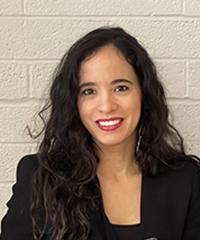
Daiane Borges Machado’s work focuses on the intersection of poverty, mental health, and suicide prevention, utilizing largescale data from the 100 Million Brazilian Cohort to evaluate the impact of social programs on mental health outcomes. Her research has been recognized internationally, including receiving the Andrej Marušič Award from the International Association for Suicide Prevention

Expected Outcomes: The project will deliver new insights into how BFP influences youth mental health outcomes and could guide smarter policy decisions. The results will be shared directly with Brazil’s Ministry of Health and Ministry of Development. The team will also create a guide for health care workers and a policy brief for the general public, ensuring the findings reach both policymakers and communities. The project aims to influence how resources are allocated to maximize well-being, reduce mental health crises, and ultimately save lives.

Overview: This project explores the design space for safer, more equitable GPS navigation systems that consider different stakeholder preferences as well as local knowledge in Brazil—especially in Rio de Janeiro. In recent years, people have been harmed or even killed after following GPS routes that led them into dangerous areas they didn’t know. While local residents may avoid certain streets based on experience, visitors and outsiders rely heavily on these apps. The central question is: How can we redesign routing algorithms to better serve everyone, especially those living in or near marginalized or underrepresented areas?
Fernanda Viegas co-leads the Insight and Interaction Lab at Harvard John A Paulson School of Engineering and Applied Sciences (SEAS), with an affiliation at Harvard Business School She is also a principal scientist at Google, where she co-founded the PAIR (People + AI Research) initiative and the Big Picture team Her work focuses on improving human-AI interaction with a broader agenda of democratizing AI technology She is also interested in weaving societal expectations and values into the design and evaluation of AI systems

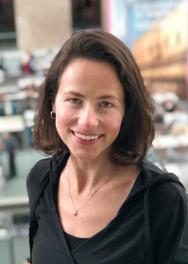
Expected Outcomes: In this study, the researchers will learn about the experiences, preferences, and concerns of drivers and residents in different neighborhoods in Rio de Janeiro. Based on these findings, the project will propose alternative algorithms for GPS systems that consider more than just the shortest or fastest route. By including safety, community input, and fairness, these tools could help prevent accidents and make navigation more responsive to local realities. In the long term, this project could influence how tech companies design navigation apps for use in Brazil and other complex urban environments around the world. It will also serve as a model for including community voices in the development of artificial intelligence tools that impact daily life.
Harvard Leads: Fernanda Viegas and Martin Wattenberg (SEAS)
Brazil Lead: Ana Cristina Bicharra Garcia (Universidade Federal do Rio de Janeiro)
LBRF Grant: 2025
Timeline: 2025–ongoing
Location: Rio de Janeiro (RJ)
Harvard Lead: S V Subramanian (HSPH)
Brazil Leads: Antonio Fernando Boing and Alexandra Crispim da Silva Boing (Universidade Federal de Santa Catarina), Lorena G. Barberia (Universidade de São Paulo), and Tatiane C. Moraes de Sousa (Universidade do Estado do Rio de Janeiro)

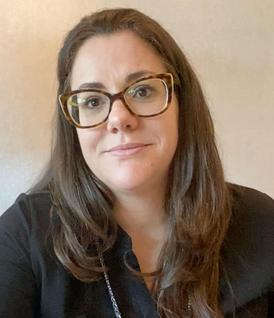
LBRF Grant: 2025
Timeline: 2025–ongoing
Location: Nationwide

Overview: Although Brazil has the world’s largest universal public health system and offers free vaccines to all, vaccination rates have been falling since the mid-2010s—especially in poorer areas. In response, the federal government launched a nationwide campaign in 2023 to boost coverage. Early data shows some progress but raises concerns that the recovery may be uneven: richer municipalities may be benefiting more than poorer ones. This research project asks whether the recent rise in vaccination rates is happening fairly across all regions and populations. The central question is: Are we moving toward equity in vaccination or leaving the most vulnerable behind?

S.V. Subramanian leads research on health inequalities, social determinants of health, and the role of place and policy in shaping health outcomes He is known for using large-scale data and advanced statistical methods to uncover patterns of inequality, especially in relation to nutrition, child development, and disease burden His work influences global health policies by highlighting how structural and societal factors drive health disparities

Expected Outcomes: This project will help Brazilian policymakers understand which strategies are working to close vaccine gaps and where more effort is needed. The findings are expected to guide local, regional, and national vaccination policies, ensuring that underserved communities receive the support they need. Scientifically, the research will advance methods for studying health inequalities by combining numbers and narratives. Socially, by highlighting successful community-led efforts, it may inspire scalable, equity-focused solutions to boost vaccination and prevent outbreaks of diseases like measles, polio, and HPV.

Overview: Oropouche fever is a viral disease spread by tiny insects (biting midges) and has mostly affected people in the Amazon region—until recently. In 2024, Brazil saw its first major outbreak outside the Amazon, with over 13,000 cases, and it even spread to other countries. A new, stronger version of the virus has emerged, which can evade prior immunity and has been linked to severe outcomes during pregnancy. Ceará, a state in Brazil, confirmed its first local case in 2024 and now faces uncertainty about how widespread the virus really is. The research team wants to answer three big questions: How many people were actually infected? Are there silent (asymptomatic) cases? And who is most at risk—both in terms of personal and environmental factors?
Antonio Silva Lima Neto serves as the executive secretary of Health Surveillance at the Ceará State Health Department. A former postdoctoral researcher at Harvard, he is an expert on the control of infectious diseases, including arboviruses like dengue, chikungunya, and Zika, and has coauthored several studies on disease transmission and public health interventions
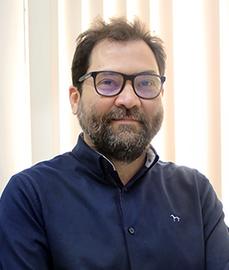

Expected Impact: This study aims to provide the first clear picture of how widespread Oropouche virus infections are in Ceará following the 2024 outbreak. The results will directly help improve public health actions—like identifying which groups need the most protection and where to focus mosquito control efforts. Findings will also support better guidelines from Brazil’s Ministry of Health and international bodies like Pan American Health Organization (PAHO). Longer term, the data could also help future studies track immunity over time and help researchers better understand how the virus behaves. Ultimately, it fills a critical knowledge gap just as the next transmission season approaches.
Improving Surveillance, Response, and Control of the Oropouche
Improving Surveillance, Response, and Control of the Oropouche
Fever
Harvard Lead: Marcia Castro (HSPH)
Brazil Leads: Antonio
Silva Lima Neto (Secretaria da Saúde do Ceará), Luciano Pamplona de Góes Cavalcanti (Universidade Federal do Ceará), and Francisca Kalline de Almeida Barreto (Centro Universitário Christus)
LBRF Grant: 2025
Timeline: 2025–ongoing
Location: Ceará












Brazil has long been a global lea.der in several aspects of climate and sustainability. The following projects wrestle with a range of questions and challenges that impact Brazil’s environment and populations, leveraging the country’s unique attributes to build scientific knowledge and capacity.






Harvard Leads: Elsie Sunderland (FAS) and Scot Martin (SEAS)
Brazil Lead: Sergio Duvoisin Junior (Universidade do Estado do Amazonas)
LBRF Grant: 2024
Timeline: 2024–ongoing
Locations: Amazonas, with some lab work at Harvard
Additional Support: DRLCAS Brazil Office, FAPEAM, Instituto de Proteção Ambiental do Amazonas, CNPq, Finep

Overview: This project investigates how mercury from small-scale gold mining in the Brazilian Amazon ends up in fish and people—even in places far from mining sites. Artisanal miners often use mercury to extract gold, which can pollute air, water, and soil. The toxic form, methylmercury, builds up in fish and can harm brain development, especially in children. Researchers have noticed that people in remote areas—nowhere near mining—also show high mercury levels, but no one fully understands why. This study aims to solve that puzzle by exploring how different river environments affect mercury’s transformation and movement through the ecosystem. The goal is to understand which environmental conditions make mercury more dangerous, and how it reaches people through the food chain.

Methodology: The team will study two major Amazon tributaries using boats operated by the State University of Amazonas (UEA). These rivers have different chemical characteristics, which may influence how mercury turns into its toxic form. During both wet and dry seasons, they will collect water, sediment, and fish samples. In the lab, they’ll measure mercury levels, determine how fast it turns into methylmercury, and analyze its chemical “fingerprint” to trace whether it came from mining or natural sources. They’ll also test how river chemistry affects mercury uptake in fish commonly eaten by locals.

Capacity Building and Technology Transfer: The project builds long-term capacity by training young researchers in advanced environmental science techniques. Harvard and Brazilian researchers are working side by side, with a vibrant exchange of lab training and fieldwork experience. The collaboration includes technology transfer between Harvard and UEA, with each sharing their advanced know-how with different aspects of the cutting-edge technologies utilized to collect samples and analyze chemicals in water, soil, and fish.
“These communities, which rely on the forest and the river for their food and livelihood, are really tuned in to what’s happening from climate change in a very real way ”
Evan Routhier, Harvard PhD candidate, in an article by the Harvard Gazette on the project (��Link)
With support of the DRCLAS Brazil Office, representatives of Ambiental.Media traveled with members of the research team on the UEA lab boat up the Rio Negro and created an interactive report on the water quality along the river (��Link)



Expected Outcomes: This research will shed light on why some communities in the Amazon experience high mercury exposure even far from mining zones. By identifying how river chemistry and ecology influence mercury’s toxic transformation, the findings will help map which ecosystems are most at risk.

Expected Impact on Policy and Communities: The results will be shared through maps, webinars, and presentations aimed at informing both policymakers and affected communities. This will guide local health officials and environmental agencies in targeting the areas that need protection or monitoring. Ultimately, the project supports safer food systems and healthier ecosystems in the Amazon.
Harvard Lead: Scot Martin (SEAS)
Brazil Lead: Rodrigo Souza (Universidade do Estado do Amazonas)
LBRF Grants: 2021
Timeline: 2021–ongoing
Location: Manaus (AM)
The project contributed to 2 doctoral dissertations

Overview: This project focuses on how forests in Amazonas, Brazil, regrow after deforestation, and how local wind and pollution patterns affect air quality. Using satellite data, drone flights, and groundbased measurements, Scot Martin’s team studied environmental changes in all 62 municipalities of Amazonas from 1985 to 2021.


Key Findings:
Recovery After Loss: Since 1985, over 10,000 km² of secondary forest have regrown in Amazonas— around 28 percent of the area previously cleared. On average, it takes two to seven years for forests to start regenerating after being cleared.
Regional Differences: Northeastern areas like Manaus saw more regrowth than southern regions near heavy deforestation zones like Rondônia. Most new forest grew on former pastureland.
River Winds: Daily winds caused by temperature differences between rivers and forests move chemicals released by trees into the air. These winds also shift pollution back towards riverbanks, affecting local air quality.
Nighttime Air Patterns: Drones revealed that nighttime air behaves differently than models predict. Pollution from fires and traffic spreads in ways not well captured by current tools.

Why This Matters: This research shows that forests in Amazonas can recover naturally—quickly in many areas—if land is left undisturbed. Secondary forests help absorb carbon and slow climate change. At the same time, better data on air patterns can lead to smarter pollution controls and public health protections, especially in growing cities near forests. The study also helps improve global climate and air quality models by filling in missing data on tropical regions.
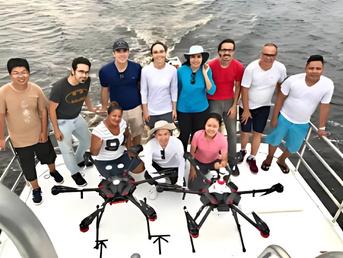


Publications in Peer-Reviewed Journals:
“Vertical Profiles of Atmospheric Species Concentrations and Nighttime Boundary Layer Structure in the Dry Season over an Urban Environment in Central Amazon Collected by an Unmanned Aerial Vehicle” (��Link)
“Vertical Profiles of Ozone Concentration Collected by an Unmanned Aerial Vehicle and the Mixing of the Nighttime Boundary Layer over an Amazonian Urban Area” (��Link)

Overview of a recent publication featured on a science outreach platform, highlighting research on Amazonian river winds (��Link)
Harvard Lead: Jerry Mitrovica (FAS)

LBRF Grant: 2020
Timeline: 2020–ongoing
Location: Brazilian coast
1 additional publication in review
Overview: This project focuses on advancing the understanding of sea level change along Brazil’s extensive Atlantic coastline, which spans over 7,500 km and is home to more than 130 million people. With coastal cities such as São Paulo, Rio de Janeiro, and Recife facing increasing threats from flooding, erosion, and rising seas, there is an urgent need to accurately constrain modern sea level changes along the entire Brazilian coast. Moreover, to improve projections of these changes into the next decades and century, efforts must be made to assess the relative contributions (figure below) from natural sea level fluctuations (e.g., from the ongoing effects of the last ice age) and those driven by modern climate change (barystatic effects—i.e., melting of ice sheets and glaciers—and sterodynamic effects—i.e., ocean thermal expansion and circulation changes), as well as the frequency of extreme sea level events. The goal is to strengthen Brazil’s capacity to respond to these environmental challenges.


Policy and Public Engagement Impact strategies: Policy Reports: A detailed report summarizing recent sea level changes and their contributing processes, along with projections for how these changes will impact the frequency of extreme sea level events, will be shared with Brazil’s Ministry of the Environment. These insights will help inform climate resilience planning. Public Outreach: A cloned and regionally tailored version of Harvard’s Climate Change Museum Exhibit will be installed at 10 Brazilian universities, increasing public awareness of sea level risks.


Methodology: The project was adapted to a remote, computational framework due to pandemic restrictions. Key methods included:
Geological Modeling: High-resolution simulations corrected sea level records for ice age effects.
Ice Melt Fingerprinting: Researchers used geophysical models accounting for gravitational and crustal effects to map how melting from different ice sheets uniquely influences sea level across South America
Ongoing Research: The project is currently applying these insights to projections of sea level rise over the next decade to the next century, as well as to the anticipated increase in the frequency of extreme sea level events (i.e., long-term sea level trends combined with ocean tides, storm surges, and atmospheric pressure changes).

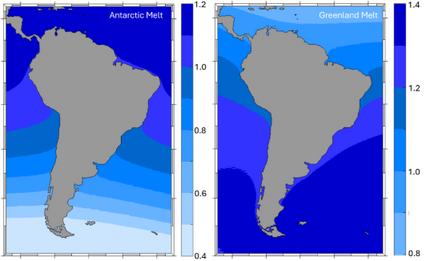
Natural Sea Level Decline: Geological simulations revealed that Brazil’s coast is still experiencing sea level fall (up to ~1 mm/year) due to ongoing adjustments from the last ice age. Ignoring this background trend could significantly distort modern climate assessments.
Modern Sea Level Projections: Simulations demonstrate that ice sheet melt impacts sea levels in Brazil unevenly. Melting from West Antarctica equivalent to a global mean sea level rise of 1 m will raise sea levels by 1.15 m in northern Brazil and 0.72 m in the south. Greenland melting of the same volume, in contrast, could raise southern levels to 1.3 m (figure above).
Geophysical Importance of South America: Brazil’s latitude and geography make it a sensitive indicator of melting sources from polar regions. Distinguishing between Greenland and Antarctic contributions is critical for interpreting sea level signals and informs adaptation strategies across coastal South America.


Capacity Building: Even without in-person fieldwork, the project sustained training and collaboration:
A sea level course developed in concert with the above research will be made available to graduate students, including virtual lectures and software development Ongoing collaboration between Harvard and Brazilian universities is set to resume physical exchanges.
Publications in Peer-Reviewed Journals: “Probabilistic reconstruction of sea-level changes and their causes since 1900” (��Link)
Harvard Leads: Scott V Edwards and Naomi Pierce (FAS)
Brazil Lead: Cristina Miyaki (Universidade de São Paulo)
LBRF Grant: 2016
Timeline: 2016–ongoing
Locations: Tocantins, Goiás, Minas Gerais, Bahia, Mato Grosso, and Mato Grosso do Sul.
Additional Support:
Harvard Climate Change Solutions Fund, Harvard DRCLAS Brazil Office, FAPESP-NSF

Overview: Using birds and butterflies as flagship taxa, the research team applied cutting-edge phylogenetic tools and large-scale biodiversity datasets to identify where Brazil’s most evolutionarily distinct and geographically restricted species—so-called phylogenetic endemics—are concentrated within the Cerrado and Caatinga regions of the Dry Diagonal. These analyses revealed centers of both ancient and recent lineages, as well as key zones of faunal transition with adjacent ecosystems like the Atlantic Forest. In doing so, the project not only generated new insights into the origins and spatial structure of biodiversity in these drylands, but also highlighted their conservation importance within Brazil’s broader ecological landscape.

Key Findings: Through extensive data synthesis and computational analysis, the team assembled a comprehensive checklist of 915 bird species with ranges overlapping the Dry Diagonal. Of these, 813 species with known phylogenetic relationships were selected for in-depth analysis using genealogical trees and distribution maps. The analyses revealed that phylogenetic endemism is highest in the southern regions of the Dry Diagonal, particularly in areas where ancient and modern lineages intersect. The study also confirmed that species-rich biomes like the Amazon and Atlantic Forest can obscure diversity patterns in the Dry Diagonal, underscoring the importance of focusing analyses on regionally endemic taxa.

Actionable Tools: Maps of phylogenetic endemism produced through this study provide actionable insights for land managers and policymakers working to protect biodiversity in the Dry Diagonal. These tools help prioritize regions for conservation based not just on species richness but on evolutionary uniqueness.

Capacity Building: The project provided advanced training in biodiversity data science and genomics for early-career researchers in Brazil and the U.S. Participants developed expertise in trait modeling, phylogenetics, and managing complex biodiversity datasets. Brazilian postdoctoral researcher Dr. João Tonini played a key role in integrating research across institutions and mentoring students—and continued this work through new support from the Harvard Climate Change Solutions Fund. Academic exchanges between Harvard and Brazilian universities deepened long-term collaborations.

Elevating the Dry Diagonal Through International Scientific Collaboration: This project helped shift attention to Brazil’s Dry Diagonal by revealing its unique evolutionary heritage, using birds and butterflies as flagship taxa. The findings directly informed a successful FAPESP-NSF Dimensions of Biodiversity grant, totaling approximately $3 million USD.
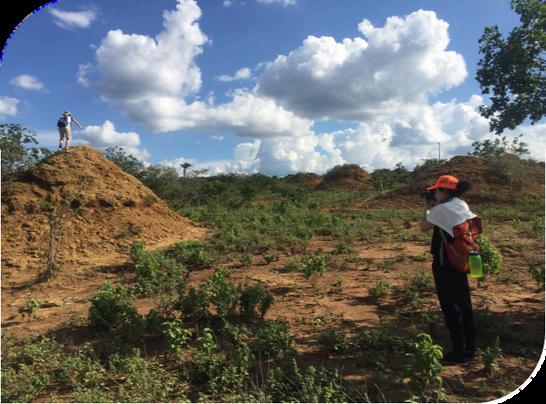
Project researchers undertaking fieldwork in the Cerrado

Conferences and Public Engagement: Project results have been shared through multiple academic channels, including invited lectures at the University of São Paulo and Federal University of Espírito Santo, a poster presentation at the iDigBio biodiversity collections meeting at UC Berkeley, and participation in the Society for the Study of Evolution’s 2018 meeting in Montpellier, France.

Academic Publications:
“Integrating natural history collections and comparative genomics to study the genetic architecture of convergent evolution” (�� Link)


Harvard Lead: David Moreno Mateos (HGSD)
Brazil Leads: Charles Clement (Instituto Nacional de Pesquisas da Amazônia), Doriane Picanço-Rodrigues (Universidade Federal do Amazonas), and Maria Imaculada Zucchi (Agência Paulista de Tecnologia dos Agronegócios)
LBRF Grant: 2020
Timeline: 2020–2023
Locations: Manaus (AM), Porto Velho (RO), Piracicaba (SP), São Carlos, (SP), São Paulo (SP), and Bauer Core Facility (Harvard)
Additional Support: FAPESP, UKRA Amazon +10 grant
Overview: This research explores how tropical forest species, like the Brazil nut tree, recover their ability to adapt after being influenced by ancient human farming. By studying trees in archaeological Amazonian sites over a 1,000-year timespan, the team uses advanced genetic tools to uncover how biodiversity can be better restored in forests today.
Fieldwork: Due to the COVID-19 pandemic, fieldwork was delayed from 2020 to 2022, during which time the team collaborated locally to identify sampling sites based on Pre-Columbian land use and time since abandonment.
Sites were categorized into three types:
1 Abandoned during colonial times and later reoccupied;
2 Abandoned farms with occasional fruit harvesting; and
3 Continuously occupied sites.
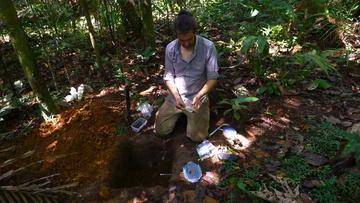

Methodology: Samples from each site were processed in collaborating labs in Piracicaba and sequenced at Harvard’s Bauer Core Facility. With the final data in hand, the team was able to develop the genomic database and complete comparative analysis. The next step will be genome annotation using a new reference genome to identify functional differences and understand traits impacted by human influence. The team also sequenced the Brazil nut (Bertholletia excelsa) genome, identifying genes linked to drought tolerance, disease resistance, and reproduction—which are valuable for conservation and breeding efforts.

Key Findings: This study revealed that Indigenous land management has been vital in preserving the genetic diversity of the Brazil nut tree. Analysis of 270 samples uncovered over 126,000 genetic variants, with historically managed areas showing greater genetic complexity, despite a long-term decline in diversity over the past 20,000 years. By integrating genomic and microbial data from archaeological sites, the project aims to better understand plant-microbe co-evolution and improve forest restoration strategies. These findings highlight the ecological value of traditional knowledge and provide critical tools for sustaining Amazonian biodiversity.
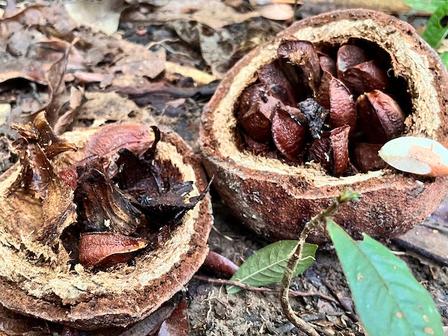

Impact: The project strengthened relationships with Amazonian communities and Brazilian research institutions. Fieldwork in three remote villages combined scientific sampling with meaningful community engagement, such as hiring local guides and visiting local schools—initiatives that were warmly received and helped build trust and local support. This work is already contributing to improving the Brazil nut reference genome and supporting regional archaeological studies via the AmazonArch network.

Additional Funding for Continuation: The team successfully procured additional funding to expand this work, reinforcing its commitment to long-term, collaborative science and to understanding how long-lived Amazonian species respond to the release from domestication. The project’s postdoctoral researcher was awarded a competitive FAPESP fellowship to continue the research on the Brazil nut for an additional two years. The research group also secured a UKRI Amazon +10 grant to expand the research to four other species and include soil microbial communities' roles in the recovery process.
Harvard Leads: Stephanie Pierce and Tiago R. Simões (FAS)
Brazil Lead: Felipe L. Pinheiro (Universidade Federal do Pampa)
LBRF Grant: 2020
Timeline: 2020–2023
Locations: Candelária (RS), Mata (RS), Santa Maria (RS), and São Gabriel (RS)
Additional Funding: Harvard Museum of Comparative Zoology; Natural Sciences and Engineering Research Council of Canada
1 undergraduate course (recurring) centered on project aims and outcomes
1 upcoming documentary by Paulo M Nascimento (Canal do Pirulla) will showcase the project
3 museum partnerships with 1 new permanent exhibit
2 postdocs in Brazil and 5 master’s theses
11 conference abstracts

Overview: Growing evidence indicates that Earth may be experiencing a sixth mass extinction, which poses serious ecological, economic, and social risks. Past extinctions offer valuable insights into the potential impacts of this crisis. Brazil’s rich but understudied fossil record spans the end-Permian mass extinction 252 million years ago, which was driven by environmental changes similar to today’s human-caused climate shifts. To explore these parallels, the team conducted excavations to trace ecological and climatic shifts before, during, and after this ancient event.

Fossil Recovery: 26 field expeditions led to the recovery of 114 fossils and the discovery of 4 new fossil sites.



New Species: These efforts resulted in the identification of several new species, such as the published Kwatisuchus rosai (a Lower Triassic stem amphibian), a new pareiasaur, and multiple reptiles.

Digitization of Fossil Records: The project made huge strides in digitizing Brazil’s fossil record, culminating in a fossil occurrence database with 5,084 entries, expanding available data by 94 percent compared to previous public repositories. Collation of this database involved visits to 19 museum collections for fossil validation and specimen examination. These efforts have significantly enhanced national and international access to fossil collections, expanding opportunities for research and collaboration.

Prehistoric Ecological Models: The project used BRIDGE paleoclimate simulations to model prehistoric ecological niches, illuminating how deep-time climatic and environmental shifts influenced vertebrate evolution and biogeography across the Permian-Triassic mass extinction.

Significance to the Field: Major ongoing projects include studies on paleoecological dynamics; stem mammal, reptile, and amphibian diversification; new taxonomic descriptions and revisions; and the history of Brazilian paleontology—collectively positioning this project as a transformative initiative in understanding South America’s terrestrial vertebrate fossil record during the most severe mass extinction in Earth’s history.

Capacity Building: Arielli Machado and Voltaire Paes Neto, Brazilian postdoctoral fellows supported by the project, provided key scientific infrastructure to the UNIPAMPA lab, helping to train and mentor many students and enabling local opportunities.

Contributions to Museums and Science Education: The team supported fossil curation and exhibit design at several low-resourced museums, helping to improve quality and accessibility. These museums serve local residents and often receive visits from public schools. The outreach efforts have contributed significantly to science education in these communities.

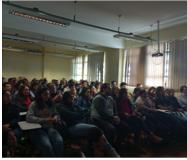






Clockwise from top-left: outreach activities with school children; children's interactive area at Museu Municipal Padre Daniel Cargnin; Macroevolution talk at Federal University of Rio Grande do Sul; a life-size, 3Dprinted reconstruction of an extinct animal as part of a new exhibit in São Gabriel; Arielli Machado and Felipe Pinheiro conducting museum work; students filling up the auditorium at Unipampa for a talk by Stephanie Pierce
Media Coverage in 111 news stories in outlets around the world, including Sci.News (��Link), Jornal Nacional (��Link), SBT News (��Link), G1 (��Link), and Super Interessante (��Link).
Publications in Peer-Reviewed Journals:
“Successive climate crises in the deep past drove the early evolution and radiation of reptiles” (��Link)
“An oasis in Western Gondwana: A diverse Guadalupian paleoflora from South America” (��Link)
“Interrelationships among Early Triassic faunas of Western Gondwana and Laurasia as illuminated by a new South American benthosuchid temnospondyl” (��Link)
“A new cynodont concentration from the Brazilian Triassic: Insights into the genesis and paleobiological significance of a highly productive fossil site” (��Link)
“Cranial osteology of the Brazilian dinocephalian Pampaphoneus biccai (Anteosauridae: Syodontinae)” (��Link)
“Diversidade e aspectos paleobiológicos do registro de Dicynodontia no Brasil” (��Link)
Harvard Leads: Naomi Pierce (FAS) and Wendy A. Valencia Montoya (GSAS)
Brazil Lead: Rodrigo Cogni (Universidade de São Paulo)
LBRF Grant: 2021
Location: State of Amazonas Timeline: 2021–2024

Overview: This project set out to understand how two destructive moth species—Helicoverpa zea and Helicoverpa armigera—are spreading across Brazil’s farmlands and becoming even more harmful through genetic mixing. By studying how these insects sense their environment and adapt to new conditions, the research aims to give farmers and scientists tools to predict and prevent pest outbreaks.
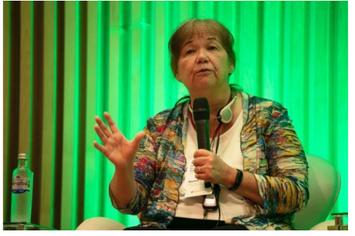
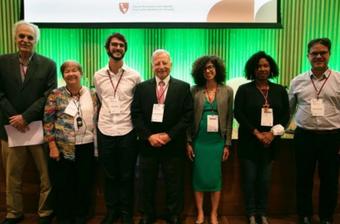

Key Findings:
Hybrid Zones Identified: Mapping and modeling have revealed regions in Brazil where two major moth species overlap and potentially hybridize, increasing their threat to crops like soy and corn. Predictive Models: These species distribution models (SDMs) allow scientists and policymakers to anticipate future pest outbreaks before they occur.
Gene Transfer Insight: The study uncovered that hybrid moths can exchange genes that influence crop targeting and light sensitivity, helping predict which insects will be most destructive.

Unique Light-Sensitive Gene Discovery: Researchers identified and functionally analyzed a gene (LWRh2) that plays a key role in caterpillar behavior but not in adult moths. This paves the way for targeted pest control methods that don’t require broad pesticides.
Genomic Architecture Mapped: The project mapped genes across different chromosomes, discovering how ancient gene duplications influence behavior at specific life stages.



Strengthening Research Ties: Harvard graduate student Wendy Valencia-Montoya and Rodrigo Cogni, associate professor of ecology at the University of São Paulo, were central to the project’s Brazil-U.S. collaboration. In 2022, Valencia-Montoya collected insect samples from the State of Amazonas to use for genomic analysis. She delivered an online seminar about her research on Helicoverpa species to Cogni’s lab in São Paulo. Cogni visited Harvard later that year, giving seminars at the Museum of Comparative Zoology and the Harvard Forest. The two met again at a conference for molecular biology in Italy in 2023. These exchanges helped strengthen research ties between the two institutions and supported training and research for both students and researchers.

Publications in Peer-Reviewed Journals:
“Adaptive evolution to the natural and anthropogenic environment in a global invasive crop pest, the cotton bollworm” (��Link)

Harvard Leads: Javier Ortega-Hernandez and Bruno Becker Kerber (FAS)
Brazil Leads: Lucas Del Mouro (Universidade de São Paulo), Milene Freitas
Figueiredo (Petrobras), Silane Silva Caminha (Universidade Federal do Mato Grosso), and Ezequiel Galvão (Universidade Federal do Pampa)
LBRF Grant: 2023
Timeline: 2023–ongoing
Locations: Belo Horizonte (MG), Cuiabá (MT), Cuiabá (MT), Caçapava do Sul (RS), and Porto Alegre (RS)
Additional Support: FAPESP
1 additional publication in review
Project results shared in integrative biology classes at Harvard and at the upcoming Geological Society of America annual meeting
Overview: The origin of animals is linked to the Cambrian Explosion, a major evolutionary milestone around 540 million years ago marked by the emergence of macroscopic fossils at the EdiacaranCambrian boundary. These early macrofossils are extremely rare and primarily documented in the Global North, resulting in a skewed geographic perspective on early animal evolution. This project investigates carbon-based microfossils from the Paraguay Belt, Parecis Basin, and São Francisco Basin—regions that span the Ediacaran-Cambrian transition. Since microfossils are more abundant, better preserved, and widely distributed than macrofossils, this study aims to generate a detailed and more globally representative record of early animal evolution during the onset of the Cambrian Explosion.

Map showing the Paraná Basin’s location and sedimentary layers, providing context for fossil sampling sites

Capacity Building: This project supported the development of paleontological expertise across several universities and research centers in Brazil and promoted cross-institutional training in microfossil extraction, sedimentology, and geochemistry.

Key Finding 1: The team discovered microscopic fossils in volcanic rocks from Brazil’s Early Cretaceous period. These fossils show that life existed in oncethought uninhabitable, lava-affected environments. Their presence also reveals a shift from dry to wetter climates likely caused by volcanic activity, offering new insights into ancient ecosystems and climate change.

Key Finding 2: The researchers used advanced imaging to study Corumbella, one of Earth’s first skeletal animals from Brazil. They discovered its tube-like body was rounded and made of simple ring-shaped elements, not square or complex as once thought. Earlier interpretations were misled by fossil compression during burial.


Expanded Collaboration: Thanks to the participation of Brazilian colleagues, the team has been able to expand efforts into areas beyond those initially described by the project, such as researching well-preserved specimens of enigmatic organisms from the Ediacaran and Devonian periods of Brazil using a variety of imaging and geochemical techniques. Brazilian researchers have also been integrated into the Harvard research group’s ongoing projects, which benefit from their complementary skillsets and expertise.

Publications:
“Organic walled microfossils in wet peperites from the early Cretaceous Paraná-Etendeka volcanism of Brazil” (��Link)
“Rebuilding Earth’s first skeletal animals: the original morphology of Corumbella (Ediacaran, Brazil)” (��Link)
Harvard Lead: Scott V. Edwards (FAS)
Brazil Collaborators:
Fabio Raposo do Amaral (Universidade Federal de São Paulo) and Luís Fábio Silveira (Museu de Zoologia da Universidade de São Paulo)
LBRF Grant: 2022
Timeline: 2022–ongoing
Location: São Paulo (SP)

Hevana Lima was selected as a postdoc on the project A biologist specializing in Neotropical birds, she earned her PhD from the Federal University of Pernambuco, focusing on genetic diversity in South American dry forest birds, and her master’s at INPA, studying hybrid zones in Amazonian woodpeckers

Overview: This project aims to apply cutting-edge genomic techniques to historical bird specimens from Brazilian museum collections to reconstruct the evolutionary and population histories of Brazil’s most endangered birds. By analyzing genetic diversity and population trajectories, the team will generate data critical for informing future conservation efforts.
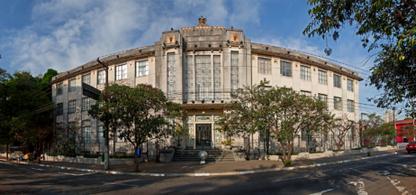

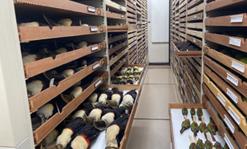

Left: Critically endangered purple-winged ground dove (Paraclaravis geoffroyi) The team will reconstruct the population history of this species Middle: The cases of ornithological specimens in ZMUSP, where these two birds are housed. Right: White-collared kite (Leptodon forbesi), a critically endangered raptor also inhabiting the Atlantic Forest of Brazil.

Key Goals:
Genetic Assessment: Determine whether current endangered bird populations exhibit reduced genetic diversity compared to historical populations.
Population Trajectories: Reconstruct species’ demographic histories over hundreds of thousands of years to understand the pace and causes of decline.
Climate Impact Modeling: Predict how future climate change scenarios may impact species' habitats using ecological niche modeling.

Overview: Urban green spaces provide social and health benefits but often rely on unsustainable levels of water, labor, and chemicals. This project assesses urban greenery in six metropolitan regions across Brazil’s diverse biomes. Although local conditions and resources vary widely, green-space management tends to follow a uniform approach. The project is developing biome-specific strategies for urban greenery that support both human and ecological needs while minimizing environmental costs.

Methodology:
Remote Sensing: Mapping urban greenery using satellite and municipal data.
Data Analysis: Comparing green space and water usage metrics.
Fieldwork: Collecting narratives in each city.
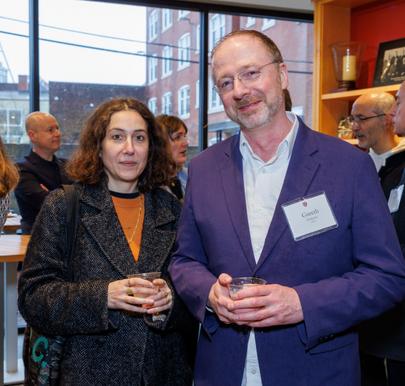

Impact: The project will develop a “Green Resilience Framework” to evaluate urban greenery in Brazil, emphasizing sustainability over mere coverage. Its multidisciplinary approach will provide new scientific insights and offer practical solutions for residents, activists, policymakers, and urban planners facing issues like water scarcity and climate change. By challenging the notion that all green spaces are inherently eco-friendly, the project promotes more context-sensitive urban greening strategies.
Harvard Leads: Gareth Doherty and Francesca Benedetto (HGSD), and Bruno Carvalho (FAS)
Brazil Leads: Washington Fajardo and Carlos Leite (Universidade
Presbiteriana Mackenzie & Insper), Jorge Abrahão (Programa Cidades Sustentáveis), and Elena Geppetti (Pontifícia Universidade Católica do Rio de Janeiro)
LBRF Grant: 2023
Timeline: 2023–ongoing
Locations: Manaus (AM), Salvador (BA), Brasília (DF), Curitiba (PA), Teresina (PI), Santa Maria (RS)

Harvard Lead: Brian Farrell (FAS)
Brazil Leads: Jeronimo Alencar and Ademir Martins (FIOCRUZ), and Paulino Siqueira Ribeiro (MCZ/Harvard)
Other: Sangil Kim (Seoul National University)
LBRF Grant: 2024
Timeline: 2024–ongoing
Locations: Cachoeiras de Macacu (RJ), Guapimirim (RJ), and Teresópolis (RJ)
Additional Support: Museum of Comparative Zoology (MCZ), Harvard University

Overview: Brazil is home to approximately 80 mosquito species in the genus Wyeomyia, all of which develop in natural water-filled cavities found in plants as well as in tree holes. These same habitats are also used by mosquitoes from the genus Aedes, which are major global disease vectors. This project will conduct a three-tiered genomic study of Wyeomyia species that breed in distinct plant containers, such as bromeliad cups, heliconia bracts, bamboo stems, and pitcher plants.
Methodology: Using a factorial design with eight species grouped by lineage and host plant, the study will identify genetic traits linked to evolutionary history and habitat type, focusing on genes involved in adapting to environmental factors like nitrogen levels and acidity. The temperate species Wyeomyia smithii will be examined in detail to compare tropical and temperate adaptations.
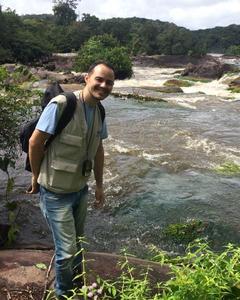
Paulino Siqueira Ribeiro is currently an MCZ biodiversity postdoctoral fellow at Harvard His work builds understanding of mosquito biodiversity, which is essential for improving disease surveillance and developing targeted vector control strategies, as accurate species identification helps predict and manage the spread of mosquito-borne illnesses

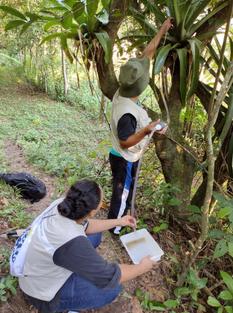
Snapshot from the Field:
Expected Contributions: This research aims to: 1) advance understanding of how mosquitoes, including disease vectors, genetically adapt to various container habitats; 2) investigate how Wyeomyia smithii has adapted to cold temperate environments, including its unique ability to reproduce without a blood meal; and 3) improve the phylogenetic framework for the genus Wyeomyia
Since evolutionary relationships can predict traits in lesser-known species, this framework enables targeted research on Wyeomyia species that differ in vector competence for disease transmission, habitat expansion capacity, and migration potential in response to climate change.

Overview: Brazil’s rich amphibian biodiversity, including species like the northeastern Brazilian flea frog, offers significant potential for advancing developmental biology. This project aims to make single-cell transcriptomics accessible to Brazilian researchers by developing low-cost, field-compatible workflows and by training local scientists. By generating high-resolution developmental data from models like Xenopus laevis and applying it to local species, the research could enhance understanding of amphibian development and inform conservation efforts. Additionally, outreach workshops will help disseminate this technology, highlighting its impact on both science and environmental preservation.

Develop Accessible Protocols: Create low-cost methods for cell dissociation, barcoding, and storage under field conditions.
Train Local Scientists: Conduct annual workshops in Brazil to teach bench techniques and bioinformatics skills related to single-cell analysis.
Build an Atlas Pipeline: Implement protocols specifically designed for Brazilian amphibians, making them openly available to the global research community.
Expand Capacity: Establish long-term infrastructure to support advanced research in developmental biology and conservation efforts in Brazil.

Marc Kirschner is a globally recognized leader in cell and developmental biology He has made landmark contributions to our understanding of the cell cycle, cytoskeletal dynamics, and embryonic patterning As a founder of Harvard’s Department of Systems Biology, he helped pioneer singlecell transcriptomics, including the development of the inDrop platform and the first vertebrate developmental cell atlas, recognized as Science magazine’s Breakthrough of the Year in 2018.
Harvard Leads: Marc Kirschner and Leon Peshkin (HMS)
Brazil Lead: José Garcia Abreu (Universidade Federal do Rio de Janeiro)
LBRF Grant: 2025
Timeline: 2025–ongoing
Location: Nationwide
Additional Support: NIHNIA, NIH-NIGMS













Brazil’s politics, government, and economy evolve in relation to internal and external factors. These projects shed light on some of Brazil’s major public and private sector developments of the 21st century, pointing towards potential directions of the decades to come.






Harvard Leads: Gautam
Rao and Diana Moreira (FAS)
Others: Jonas Hjort (Columbia University) and Juan Francisco Santini (World Bank)
LBRF Grants: 2016, 2018
Timeline: 2016–2021
Locations: Nation-wide sample of municipalities
Additional Support: Weiss Family Fund, Warburg Fund, and JPAL Governance Initiative Pilot Grant
The project contributed to 1 PhD dissertation and to the training of 2 master’s students
Invited presentations at PUC-Rio, FGV-EESP, and USP, as well as at regional research conferences such as LACEA-LAMES

Overview: This project aimed to bridge the gap between academic research and municipal policymaking in Brazil. By partnering with CNM, the National Confederation of Municipalities, and leveraging a custom-built infrastructure, the team reached thousands of local officials across diverse regions. Through short, targeted sessions tailored for real-world governance, the project tested whether research can influence policy and how it can be delivered effectively. The work demonstrated that scaling evidence-sharing across municipalities is both practical and impactful.
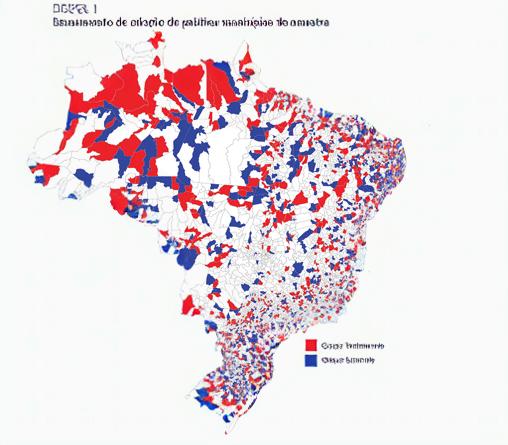
Map of Brazil highlighting all municipalities included in the study
Survey Scale and Scope:
This was one of the largest policy experiments ever conducted in Brazil.
2,150 municipalities participated in randomized trials.
334 mayors joined targeted 45-minute information sessions.
700-plus officials engaged in survey experiments on belief formation.
The research reached all states in Brazil, ensuring diverse, representative insights.

Mayors were presented with research evidence on policies like tax reminders and early childhood programs.
Sessions were short (45 minutes), direct, and designed for policy relevance.
Outcomes measured: changes in beliefs about policy effectiveness actual adoption of informed policies 15–24 months later
This approach isolated the effect of information provision on policy decisions.

Key Findings:
Mayors showed strong interest in research and were even willing to pay for it. Exposure to policy evidence led to a 10 percentage point increase in policy adoption.
Belief updates were rational and unbiased, defying assumptions about political filtering.
The study confirmed that simplified, relevant research can drive real-world change.


Policy Relevance: CNM partnered in the rollout and expressed interest in expanding the program. A government-requested analysis estimated a 27-to-1 return on investment. The project’s influence extended beyond Brazil, informing global policy discussions at JPAL, the World Bank, and beyond.


Academic Publications:
“How research affects policy: Experimental evidence from 2,150 Brazilian municipalities” (��Link)
“Conectando pesquisa a gestão municipal: avaliações de impacto influenciam a formulação de política pública?” (��Link)
Harvard Leads: Asim Khwaja (HKS) and Marcia Castro (HSPH)
Brazil Leads: José Macedo and Marcia Machado (Universidade Federal do Ceará)
LBRF Grant: 2022
Timeline: 2022–ongoing
Location: State of Ceará

Overview: This project helps the government of Ceará make better decisions using data it already collects from low-income households. Although information on housing, income, food insecurity, and more is available on a central platform, it’s not always used effectively. The project tests ways to make the data more useful and brings together decision-makers from different sectors (like health, education, and public safety) to coordinate actions. It aims to improve how policies are designed and implemented, leading to better outcomes for vulnerable families. The research will also identify which methods work best to inform broader strategies in other regions.
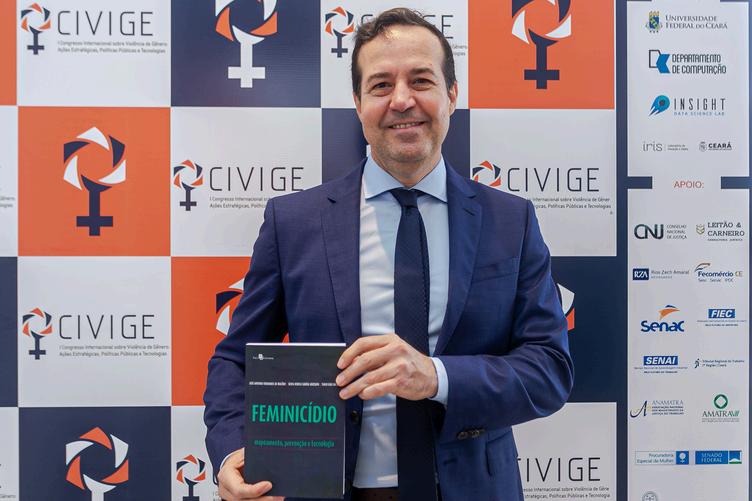
“O

The Insight Data Science Lab, led by José Macedo, applies artificial intelligence and big data techniques to tackle real-world challenges, developing tools that help reduce crime through real-time monitoring, improve urban mobility by analyzing movement patterns, and support health care professionals with AI-driven tools. Widely recognized as a top Brazilian researcher in computer science, Macedo has published over 150 articles and has received national honors such as the Medalha Ordem do Mérito Supesp. His work demonstrates the power of data science to produce actionable insights that directly improve people’s lives.

Partnering with the Government: The project partners directly with the government of Ceará, including state secretariats for social protection, health, education, and public safety, as well as the vice governor’s office.

Project Design: The government already collects a lot of useful information from families across the state—such as housing conditions, food needs, and income levels—and shares it on a website (called the Big Data Social portal). But many local officials don’t use this information often, or don’t know how to use it well.
The researchers will divide all 184 cities in Ceará into three groups:
Control Group: These cities will continue using the data portal as they already do, without extra help.
Single-Agency Support: Social workers in these cities will get monthly reports with clear summaries of the data, plus training and phone support to help them understand how to use it.
Multi-Agency Support: In addition to the support in Group 2, officials from other sectors (like health or education) will work together in workshops to make joint decisions based on the data.
The researchers will then measure whether this support encourages local leaders to use the data more frequently, to make better decisions, and to deliver improvements to families’ living conditions as a result.

Expected Outcomes: The study expects to find out whether giving local officials more support—like training, reports, and chances to collaborate—helps them use data better to make decisions. Specifically, it will measure:
How often and effectively officials use the data platform (e.g., how much they log in and explore it).
Whether their understanding and use of the data improves, and if it changes how they make policy decisions.
Whether the lives of low-income families improve over time—looking at factors like income, food security, and housing—by comparing new survey results with earlier ones.
In short, the study hopes to show if smarter data use leads to smarter policies and better results for vulnerable families.
Harvard Lead: Elizabeth McKenna (HKS)
Brazil Leads: Ana Rodrigues Cavalcanti Alves (Universidade Federal da Bahia), Rafael Cardoso Sampaio (Universidade Federal do Paraná), Claudio Tadeu Cristino (Universidade Federal Rural de Pernambuco), Esther Solano Gallego (Universidade Federal de São Paulo), Helena Lúcia Zagury Tourinho (Universidade da Amazônia), Helena d’Agosto Miguel Fonseca (Universidade Federal de Minas Gerais), Luciano Muniz Abreu (Universidade Federal Rural do Rio de Janeiro), Ricardo Paiva (Universidade Federal do Ceará), Sandra Catharinne Pantaleão Resende (Pontifícia Universidade Católica de Goiás), and Sérgio Simoni Junior (Universidade Federal do Rio Grande do Sul)

Overview: This project investigates the evolving political dynamics in Brazil through a novel exploration of how place and class interact to shape voting behaviors. The focus is on the persistence and spread of far-right politics, specifically “bolsonarismo,” across Brazil's urban geographies, taking a mixed-methods, comparative approach to better understand the durability of political polarization, especially among traditionally leftleaning, lower-income populations.
Amid rising global concerns over democratic backsliding, this research offers a timely inquiry into how contemporary political movements in Brazil leverage local socio-spatial conditions and collective identities. This includes assessing why certain urban territories, despite sharing socio-demographic characteristics, diverge in their political alignments over time.
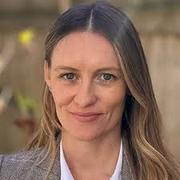
Elizabeth McKenna, is a political sociologist whose work focuses on democracy, political mobilization, and inequality, with a special emphasis on Brazil A graduate of Harvard College, she engaged with Brazil as a student with support of DRCLAS and has maintained a deep connection to the country ever since Today, McKenna collaborates with scholars and institutions across the country and integrates Brazilian politics into her teaching and research Her work bridges rigorous social science with on-the-ground insight, making her a unique figure in understanding political change in Brazil and beyond.
Others: Matthew Richmond (London School of Economics & Political Science)
LBRF Grant: 2023
Timeline: 2023–ongoing
Locations: Nationwide, with local data collection and processing in Brazil’s 11 most populous cities

Examine the relationship between place, social class, and vote choice in Brazil’s 11 most populous cities.
Understand the appeal and persistence of bolsonarismo, especially among working-class Black and brown Brazilians.
Map granular shifts in voter behavior between the 2018 and 2022 presidential elections using precinct- and census-tract-level data.
Conduct qualitative fieldwork to contextualize voter motivations, affiliations, and political subjectivities.


Anticipated Outputs and Contributions:
Census-tract level electoral maps illustrating vote patterns and realignments.
Peer-reviewed publications, including a forthcoming article coauthored by McKenna and Matthew Richmond titled “Placing the peripheries within Brazil’s rightward turn” (conditionally accepted at Environment and Planning C).
Rich qualitative datasets for future political and sociological analysis.
Policy-relevant insights into democratic resilience and polarization in Brazil and comparable contexts globally.

Harvard Lead: Laura Alfaro (HBS)
Brazil Leads: Andrea Lucchesi (Universidade de São Paulo), Naercio A Menezes Filho and Alison Oliveira (Universidade de São Paulo & Insper), and Leandro Justino Pereira Veloso (Universidade Federal do Rio de Janeiro)
Others: Maggie X Chen (George Washington University) and Monika Schnitzer (University of Munich)
LBRF Grant: 2016
Timeline: 2016–2019
Working Paper:
“Outsourcing Innovation: The China Shock Hits Brazil” (��Link)

Overview: This project investigates how Brazilian manufacturing firms responded to China's dramatic expansion in global trade between 1998 and 2011. Using rich, confidential, firm-level data from Brazilian statistical agencies, the study analyzes how access to cheaper Chinese imports—particularly intermediate goods used in production—has shaped productivity, innovation, labor, and product strategy in Brazil’s industrial sector. The study distinguishes between importing from China (sourcing inputs) and competing with China (facing cheaper finished goods), offering a nuanced picture of globalization's effects.
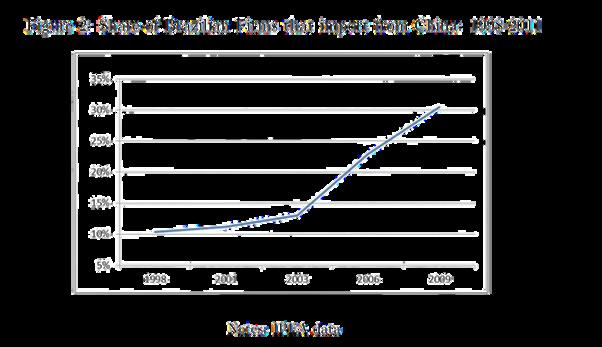

Productivity Gains, Innovation Losses: Firms that imported from China increased productivity by up to 24% but saw declines in organizational and marketing innovation.
Employment Drops: Both importing and competing with China led to statistically significant job losses, especially among midrange productivity firms.
Strategic Simplification: Firms narrowed their product lines in response to sector-level import pressure—focusing on “core competencies” and dropping marginal product lines.

Key Findings (continued):
Winners and Losers: The firms that benefited most were in the middle of the productivity distribution—productive enough to adapt but not at the frontier. These firms gained in profit margins and wages but still cut jobs.
Importing ≠ Innovating: Rather than innovating in-house, many firms appear to be “outsourcing innovation” by relying on more advanced, imported inputs.

Methodology: The team combined multiple data sets—IBGE’s manufacturing census (PIA), innovation survey (PINTEC), and customs records (SECEX)—to track over 10,000 Brazilian firms across more than a decade. The team members measured total factor productivity (TFP) using industry-standard methods (OlleyPakes, Levinsohn-Petrin, Ackerberg) and linked it to firm-level and sector-level Chinese import exposure. To isolate causal effects, they used an instrumental variable: the share of imports from China by other South American countries in the same sector. This helped account for global trade trends unrelated to Brazil’s own policies.


Why This Matters: Brazil has long been a key player in Latin American manufacturing. As China became a dominant global supplier, Brazil’s firms were forced to adapt. While cheaper inputs raised productivity, the drop in innovation signals a troubling shift: Brazilian firms may be sacrificing long-term growth for short-term gains. These findings shed light on the real trade-offs of globalization for emerging economies and offer critical insights for policymakers looking to build sustainable industrial strategies.

Harvard Leads: Alisha Holland and Jean Vilbert (FAS)
Brazil Lead: Fernando Limongi de Magalhaes (Escola de Economia de São Paulo, Fundação Getúlio Vargas)
LBRF Grant: 2024
Timeline: 2024–ongoing
Locations: Multiple States

Overview: This project investigates how the rise of private contractors has transformed Brazilian public administration and politics. Since the 1990s, Brazil has increasingly outsourced infrastructure responsibilities to private construction firms, reflecting global neoliberal reforms. Rather than merely shrinking the state, this shift has reconfigured the relationships between governments, private firms, and political parties.
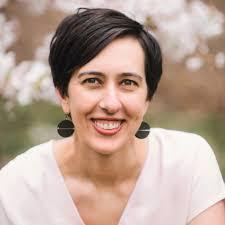
Alisha Holland is a Gates Professor of Developing Societies who researches the political economy of development, with a focus on Latin America Her work examines how governments respond to pressing social issues like urban inequality, migration, and informal housing, and why they often fail to implement effective policies despite public demand Her work offers significant insights into how political institutions, state capacity, and public opinion shape policy outcomes in the Global South, influencing both academic debates and realworld governance strategies
Research Objectives: The project is structured around three key questions:
Variation in Contractor Influence: How do Brazilian states differ in the types and influence of private contractors that have emerged? Impact on Public Infrastructure: How does dependence on private contractors affect the type, quality, and alignment of infrastructure projects with public planning goals?
Political Implications: How do contractorpolitical linkages shape the strength of political parties and the financing of electoral campaigns?

Overview: This project investigates how redistributive public policies can mitigate affective polarization and reduce susceptibility to misinformation in Brazil. It centers on the newly launched federal program Programa Pé de Meia, a conditional cash transfer aimed at low-income high school students, and will examine its broader political and social impact during Brazil’s 2026 presidential elections.


Empirically test whether redistributive policies can reduce affective polarization and misinformation receptivity.
Compare the efficacy of this approach against conventional depolarization strategies (e.g., empathy-building, correcting misperceptions). Inform policy by identifying how government action can foster democratic trust and unity in polarized societies.
Pavão is an associate professor of political science at the Federal University of Pernambuco, specializing in political behavior, corruption, and democratic accountability in Latin America Her work combines experimental and survey methods to understand how citizens engage with democratic institutions She has collaborated with Harvard University through DRCLAS on initiatives related to governance and political trust.
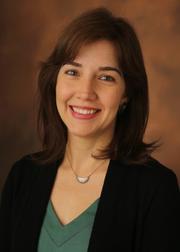
Brazil Lead: Nara Pavão (Universidade Federal de Pernambuco)
LBRF Grant: 2025
Timeline: 2025–ongoing
Location: Nationwide

Two of the projects supported by the Fund included hands-on courses in which students from Harvard and from Brazil participated in real-time fieldwork under the supervision of the projects’ faculty leads.

















Harvard Lead: Gary Urton (FAS)
Brazil Lead: Eduardo Goes Neves (Universidade de São Paulo)
LBRF Grant: 2017
Timeline: 2017–2018
Location: Rio Branco (AC)
Additional Support: DRCLAS Brazil Office

Overview: This research project explored Sol de Campinas, a pre-Columbian ring village located in the state of Acre, western Brazil, with the goal of deepening understanding of ancient settlement patterns and cultural landscapes in the region. The site, characterized by a series of mounded earthworks arranged around a central plaza, offers valuable insights into the social organization and construction practices of its original inhabitants. Carried out through a collaborative field school, the project combined excavation, mapping, and interdisciplinary analysis while fostering crosscultural academic exchange between Harvard and other institutions in Brazil.
Course Implementation: The course was designed as a fully immersive field school from June 10 to July 15, 2018, combining field excavation with evening discussions, assigned readings, and guest lectures. It brought together six U.S. students and several Brazilian students from the Universidade Federal do Acre, creating a truly binational team. The interdisciplinary and intercultural format emphasized rigorous academic training, cross-cultural exchange, and direct engagement with local heritage and landscapes.


Key Findings: Excavations revealed that the ring village was built through multiple construction phases and likely hosted long-term occupation by pottery-making, horticulturist, and foraging populations. Recovered artifacts—such as ceramics, charcoal, spindle whorls, and a stone axe—suggest complex habitation and ceremonial use, possibly resembling the social and spatial organization of Gê and Bororo communities. The evidence also supports links between Acre’s ancient ring villages and the circular settlement patterns still found in parts of the Amazon today.

Real-world Significance: The project challenges outdated narratives of the Amazon as sparsely populated prior to European contact, demonstrating instead a history of dense and complex settlement. It also raises awareness about the cultural significance of Acre, a region often marginalized within Brazil, and lays groundwork for heritage preservation in the face of modern land-use threats.


Conferences and Outreach: In addition to fieldwork, the project contributed to academic dissemination and public outreach by participating in the Simpósio Internacional de Arqueologia da Amazônia Ocidental, the first international archaeology symposium ever held at the Universidade Federal do Acre. The conference brought together scholars from Brazil, the U.S., and Europe, and was attended by hundreds of students, faculty, and members of the public. It provided a valuable platform for students to hear research presentations in Portuguese and to engage with broader regional discussions around Amazonian archaeology.
Harvard Lead: Roger Fu (FAS)
Brazil Lead: Ricardo Ivan Trindade (Universidade de São Paulo)
LBRF Grant: 2019
Timeline: 2019–2022
Locations: Januária (MG), Rosário Oeste (MT), Doutor Ulysses (PR), and São Paulo (SP)
Additional Support: National Science Foundation (NSF), FAPESP, Instituto Serrapilheira
Conference Presentations: American Geophysical Union Meeting (2019, 2021, 2022, 2023) Karst Records IX Conference in Innsbruck, Austria (2022)

Overview: The project achieved two main objectives: Research component: A team of scientists from Harvard and Universidade de São Paulo collected paleoclimate samples from caves in Brazil, which were later analyzed at Harvard. Educational component: Harvard and USP students jointly participated in a field course on cave geology in Minas Gerais and São Paulo. Afterward, the USP students traveled to Harvard to conduct lab experiments and complete the course.

Methodology: The Harvard research group carried out detailed analyses of three stalagmite samples obtained from Pau D’Alho Cave in Mato Grosso, Onça Cave in Minas Gerais, and Malfazido Cave in Paraná using samples collected by USP collaborators. A significant investigation led by Principal Investigator Roger Fu marked the first use of quantum diamond microscopy (QDM) in reconstructing past climate conditions from stalagmites.


Roger Fu (FAS) was recently promoted to tenured professor (��Link)
Key Findings: The ultimate goal of this work was to document the rainfall history, including drought and flood occurrence, of a region with unprecedented reliability using a novel technique. Researchers found that samples from Pau D’Alho Cave contained 10 µm-thick layers of magnetic particles associated with dry climate phases between 950 and 1200 CE. Meanwhile, a distinct set of particles in Malfazido Cave samples showed unambiguous evidence for episodic flooding. The QDM was vital for distinguishing the signatures of these disparate particle types.

Course Implementation and Impact: The LBRF supported a successful field course in January 2020 that involved 18 students—8 from Harvard and 10 from USP. Participants engaged in fieldwork in Brazil and preliminary lab analyses at Harvard until pandemic-related shutdowns in March 2020 prompted a shift to virtual instruction. After two years of delays due to COVID-19, two USP students and collaborator Ricardo Ivan Trindade traveled to Harvard in August 2022, where their lab work produced essential data for both students’ doctoral research. One student is now preparing a publication on Moroccan speleothems focused on variations in Earth’s magnetic field over the past 3,000 years.

Additional Support: The LBRF played a key role in generating preliminary data that helped secure a National Science Foundation award for over $300,000 to continue research on paleoclimate reconstruction through speleothem magnetism (grant title: “High spatial resolution assessment of the speleothem magnetization proxy”).
Students from Harvard and USP explore a cave during a collaborative field course in Brazil


Publications:
“High-resolution environmental magnetism using the quantum diamond microscope (QDM): Application to a tropical speleothem” (��Link)
“Investigating speleothem magnetism as a proxy for dust mobilization and rainfall” (��Link)
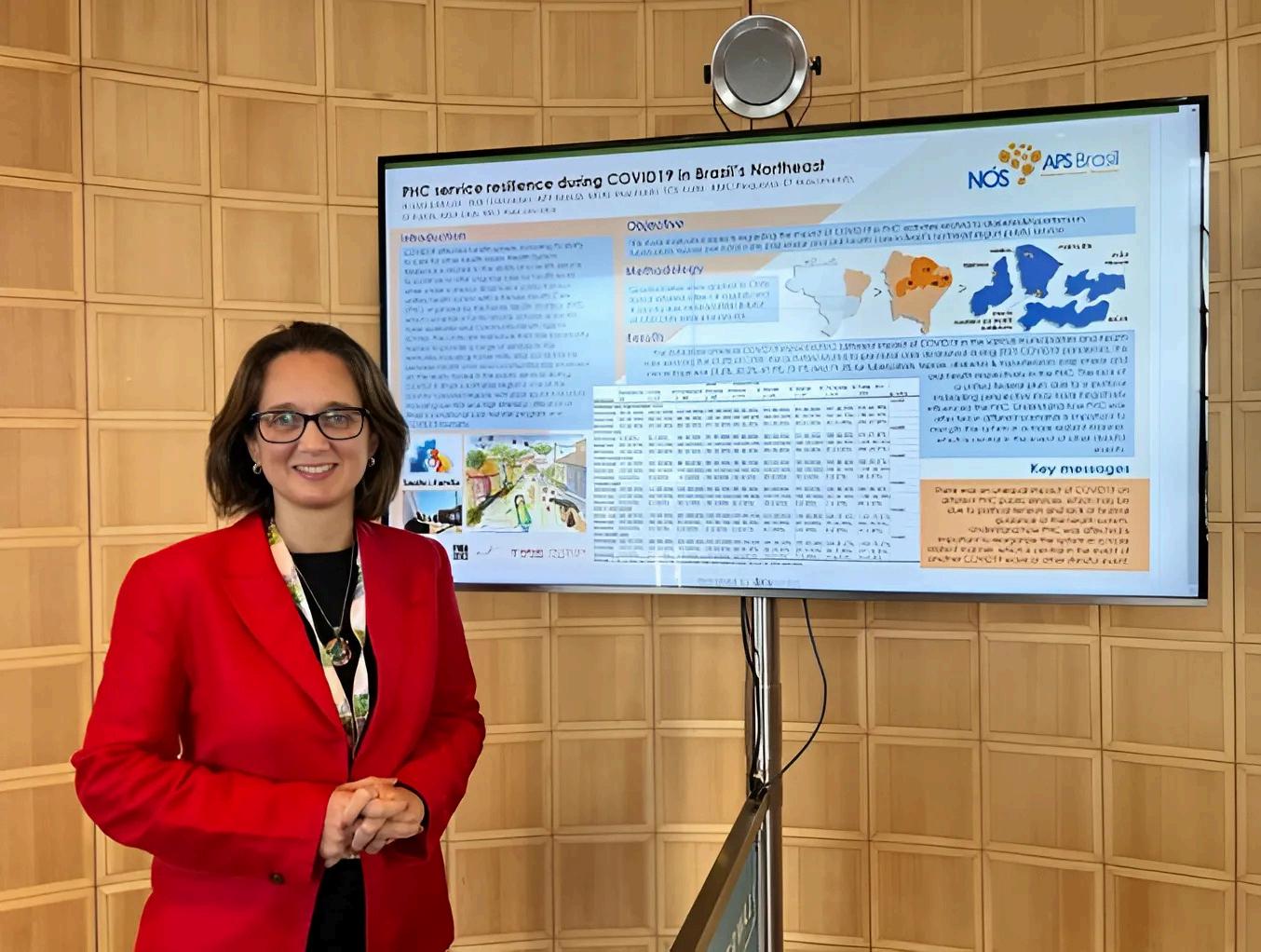












The number of academic publications with explicit acknowledgements of support from the LBRF follows an upward trend. Many of the articles have been published in the most prestigious scientific journals of the authors’ respective fields.
Publications in journals and books, as well as citations and journal impact factors, are forms of currency in academia. Several factors influence the publication timeline of an academic paper, including the study’s design, its data sources used, and the rigor of the journal reviewing the submission. When original data is collected, as is the case with most LBRF-funded projects, it typically takes three years or more to publish a study from the time of the award’s approval. This section provides an overview and list of the LBRF’s academic publications to date.
93*
105
183
Academic publications published to date, which include:
Harvard-based researchers as co-authors and
Brazil-based researchers as coauthors
Publications supported by the Lemann Brazil Research Fund
To the knowledge of the LBRF administrators, there are at least an additional:
19 Publications currently under review or in development
To date, the LBRF projects have supported at least:
78 Doctoral dissertations, master’s theses, or undergraduate theses
*Includes journal articles, books, book chapters, and working papers Abstracts, conference presentations, doctoral dissertations, master’s theses, and undergraduate theses are not included
“Correspondence Analysis of Government Expenditure Patterns,” arXiv preprint (2018) ��Link
“Epidemiological characteristics and determinants of dengue transmission during epidemic and non-epidemic years in Fortaleza, Brazil: 2011—2015,” PLoS Neglected Tropical Diseases (2018) ��Link
“Overachieving Municipalities in Public Health,” Epidemiology (2018) ��Link
“An Information-Theoretic View of Generalization via Wasserstein Distance,” Institute of Electrical and Electronics Engineers (2019) ��Link
“Chikungunya-attributable deaths: A neglected outcome of a neglected disease,” PLoS Neglected Tropical Diseases (2019) ��Link
“Exposure to an environmentally relevant phthalate mixture during prostate development induces microRNA upregulation and transcriptome modulation in rats,” Toxicological Sciences (2019) ��Link
“Integrating natural history collections and comparative genomics to study the genetic architecture of convergent evolution,” Philosophical Transactions of the Royal Society (2019) ��Link
“Intermediate-scale horizontal isoprene concentrations in the near-canopy forest atmosphere and implications for emission heterogeneity,” Proceedings of the National Academy of Sciences (2019) ��Link
“Outsourcing Innovation: The China Shock Hits Brazil,” Working Paper (2019) ��Link
“Ribosomal DNA and the nucleolus as keystones of nuclear architecture, organization, and function,” Trends in Genetics (2019) ��Link
“Vertical profiles of ozone concentration collected by an unmanned aerial vehicle and the mixing of the nighttime boundary layer over an Amazonian urban area,” Atmosphere (2019) ��Link
“Blurred lines: racial misclassification in death certificates in Brazil,” International Journal of Public Health (2020) ��Link
“Ensinando Futuros Professores: experiências formativas inspiradoras, ” Editora CRV (2020). ��Link
“Infestation measured by Aedes aegypti larval surveys as an indication of future dengue epidemics: an evaluation for Brazil,”
Transactions of the Royal Society of Tropical Medicine and Hygiene (2020) ��Link
“Numerical anchoring, perceived returns, and asset prices,” Working Paper (2020) ��Link
“Spatiotemporal transmission dynamics of co-circulating dengue, Zika, and chikungunya viruses in Fortaleza, Brazil: 2011–2017,” PLoS Neglected Tropical Diseases (2020) ��Link
“Vertical profiles of atmospheric species concentrations and nighttime boundary layer structure in the dry season over an urban environment in central Amazon collected by an unmanned aerial vehicle,” Atmosphere (2020) ��Link
“Violence and vulnerability of the Community Health Worker in the territory: implications for tackling COVID-19,” Ciência e Saúde Coletiva (2020) ��Link
“γδ T cells suppress Plasmodium falciparum blood-stage infection by direct killing and phagocytosis,” Nature Immunology (2021) ��Link
“Bayesian evidence synthesis to estimate subnational TB incidence: an application in Brazil,” Epidemics (2021) ��Link
“Cause-specific mortality prediction in older residents of São Paulo, Brazil: a machine learning approach,” Oxford Academic (2021) ��Link
“Classroom-level peer self-regulation as a predictor of individual self-regulatory and social-emotional development in Brazil,” Journal of Applied Developmental Psychology (2021) ��Link
“Elachistocleis Cesarii,” Herpetological Review (2021) ��Link
“Formative Tools on Undergraduate Programs: Analysis of Brazilian Experiences in the Light of Francophone Literature,” Educação em Revista (2021) ��Link
“High-resolution environmental magnetism using the quantum diamond microscope (QDM): Application to a tropical speleothem,” Frontiers in Earth Science (2021) ��Link
“How research affects policy: Experimental evidence from 2,150 Brazilian municipalities,” American Economic Review (2021) ��Link
“Identificação precoce de dificuldades de leitura e escrita em contextos de vulnerabilidade,” Neurosaber (2021) ��Link
“Patterned villagescapes and road networks in ancient southwestern Amazonia,” Latin American Antiquity (2021) ��Link
“Pedagogies of pre-service teacher education: The Core Practice Consortium case,” Educação em Revista (2021) ��Link
“Post-transcriptional diversity in riboproteins and RNAs in aging and cancer,” Seminars in cancer biology. Academic Press (2021) ��Link
“River winds and pollutant recirculation near the Manaus city in the central Amazon,” Communications Earth & Environment (2021) ��Link
“SARS-CoV-2 infects blood monocytes to activate NLRP3 and AIM2 inflammasomes, pyroptosis and cytokine release,” Nature (2021) ��Link
“The Global Fingerprint of Modern Ice‐Mass Loss on 3‐D Crustal Motion,” Geophysical Research Letters (2021) ��Link
“Trends in untreated tuberculosis in large municipalities, Brazil, 2008–2017,” Emerging Infectious Diseases (2021) ��Link
“Um compasso para aprender: A randomized trial of a social‐emotional learning program in homicide‐affected communities in Brazil,” Child Development (2021) ��Link
“Violência e vulnerabilidade no território do agente comunitário de saúde: implicações no enfrentamento da COVID-19,” Ciência & Saúde Coletiva (2021) ��Link
“Alfabetização baseada em evidências: da ciência à sala de aula,” Editora Penso (2022) ��Link
“A spatial-mechanistic model to estimate subnational tuberculosis burden with routinely collected data: an application in Brazilian municipalities,” PLoS Global Public Health (2022) ��Link
“Cérebro, leitura e vulnerabilidades: como estimular nossas crianças,” Editora Wak (2022) ��Link
“Conectando pesquisa a gestão municipal: avaliações de impacto influenciam a formulação de política pública?,” Instituto de Pesquisa Econômica Aplicada (Ipea) (2022) ��Link
“Deep genomic divergence and phenotypic admixture of the treefrog Dendropsophus elegans (Hylidae: Amphibia) coincide with riverine boundaries at the Brazilian Atlantic Forest,” Frontiers in Ecology and Evolution (2022) ��Link
“Excess tuberculosis cases and deaths following an economic recession in Brazil: an analysis of nationally-representative disease registry data,” Lancet Global Health (2022) ��Link
“FcγR-mediated SARS-CoV-2 infection of monocytes activates inflammation,” Nature (2022) ��Link
“Inflammasome activation in infected macrophages drives COVID-19 pathology,” Nature (2022) ��Link
“Integrating SEL into early childhood settings in Brazil,” NISSEM (2022) ��Link
"River winds and transport of forest volatiles in the Amazonian riparian ecoregion,” Environmental Science & Technology (2022) ��Link
“Successive climate crises in the deep past drove the early evolution and radiation of reptiles,” Science Advances (2022) ��Link
“Widespread pesticide contamination of drinking water and impact on cancer risk in Brazil,” Environment International (2022) ��Link
“O83 Prospective Association Of UltraProcessed Food Consumption And Weight Gain In Young Adults At The Nutrinet-Brasil Cohort Study,” Archivos Latinoamericanos de Nutrición 73 (2023) ��Link
“Acceptability of a hypothetical dengue vaccine and the potential impact of dengue vaccination on personal vector control behavior: a qualitative study in Fortaleza, Brazil,” BMC Public Health (2023) ��Link
“Adaptation and Efficacy of a SocialEmotional Learning Intervention (SEL Kernels) in Early Childhood Settings in Southeastern Brazil: A Quasi-Experimental Study,” Early Education and Development (2023) ��Link
“Adaptive evolution to the natural and anthropogenic environment in a global invasive crop pest, the cotton bollworm,” The Innovation (2023) ��Link
“Characterization of the phonological system in low-income Brazilian preschoolers,” CoDAS (2023) ��Link
“Community health workers perspective on the COVID-19 impact on primary health care in Northeastern Brazil,” Cadernos de Saúde Pública (2023) ��Link
“Concerns regarding a suggested long COVID paradigm,” The Lancet Respiratory Medicine (2023)��Link
“Cranial osteology of the Brazilian dinocephalian Pampaphoneus biccai (Anteosauridae: Syodontinae),” Zoological Journal of the Linnean Society (2023) ��Link
“Diversidade e aspectos paleobiológicos do registro de Dicynodontia no Brasil,” Terrae Didatica (2023) ��Link
“Gender and violence in the daily routine of community health workers in Fortaleza, Brazil,” Journal of Community Health (2023) ��Link
“Mental health of community health workers in the COVID-19 context,” Ciência e Saúde Coletiva (2023) ��Link
“Nova diet quality scores and risk of weight gain in the NutriNet-Brasil cohort study,” Public Health Nutrition (2023) ��Link
“Organic walled microfossils in wet peperites from the early Cretaceous Paraná-Etendeka volcanism of Brazil,” Scientific Reports (2023) ��Link
“Population growth and deforestation in Amazonas, Brazil, from 1985 to 2020,” Population and Environment (2023) ��Link
“Saúde mental de agentes comunitários de saúde no contexto da COVID-19,” Ciência & Saúde Coletiva (2023) ��Link
“Systemic barriers and opportunities for implementing school-based social–emotional learning interventions in low-income and conflict-affected settings,” Frontiers in Psychology (2023) ��Link
“Violence in the neighborhood and mental health of community health workers in a Brazilian metropolis,” Cadernos de Saude Publica (2023) ��Link
“The erasure of infection-associated chronic conditions: Critical interpretive synthesis of literature on healthcare for long COVID and related conditions in Brazil,” Global Public Health (2023) ��Link
“Yeast population dynamics in Brazilian bioethanol production,” G3: Genes, Genomes, Genetics (2023) ��Link
“A cycle of invisibilisation: a qualitative study of Brazilian health system factors shaping access to long COVID care,” BMJ Global Health (2024) ��Link
“A imigração venezuelana e o contexto da alfabetização de crianças brasileiras e venezuelanas em escolas municipais de Boa Vista, Roraima, Brasil: um olhar para as considerações da gestão,” Educar em Revista (2024) ��Link
“A new cynodont concentration from the Brazilian Triassic: Insights into the genesis and paleobiological significance of a highly productive fossil site,” Journal of South American Earth Sciences (2024) ��Link
“Cost-effectiveness and health impact of screening and treatment of Mycobacterium tuberculosis infection among formerly incarcerated individuals in Brazil,” medRxiv (2024) ��Link
“CircadiPy: An open-source toolkit for analyzing chronobiology time series,” Journal of Neuroscience Methods (2024)��Link
“Estudos de casos para a formação de professores de Química,” Editora Unesp (2024) ��Link
“Eosinophil activation during immune responses: an ultrastructural view with an emphasis on viral diseases,” Journal of Leukocyte Biology (2024) ��Link
“Exploring the Effects of a Social-Emotional Learning Intervention in Brazilian Primary Schools: Findings from Year Two of Implementation,” Journal of Research on Educational Effectiveness (2024) ��Link
“Extracellular sombrero vesicles are hallmarks of eosinophilic cytolytic degranulation in tissue sites of human diseases,” Journal of Leukocyte Biology (2024) ��Link
“High mortality rates among individuals misdiagnosed with tuberculosis: a matched retrospective cohort study of individuals diagnosed with tuberculosis in Brazil,” The Journal of Infectious Diseases (2024) ��Link
“Interrelationships among Early Triassic faunas of Western Gondwana and Laurasia as illuminated by a new South American benthosuchid temnospondyl,” The Anatomical Record (2024) ��Link
“Investigating speleothem magnetism as a proxy for dust mobilization and rainfall, ” Quaternary Science Reviews (2024) ��Link
“Long-term mortality trends among individuals with tuberculosis: a retrospective cohort study of individuals diagnosed with tuberculosis in Brazil,” medRxiv (2024) ��Link
“Predictors of unsuccessful tuberculosis treatment outcomes in Brazil: an analysis of 259,484 patient records,” BMC Infectious Diseases (2024) ��Link
“Processo de trabalho do agente comunitário de saúde: análise da influência da violência urbana e da covid-19,” Ciência e Saúde Coletiva (2024) ��Link
“Promoting Equity, Diversity, and Inclusion in Surveys: Insights from a Patient-engaged Study to Assess Long COVID Healthcare Needs in Brazil,” Journal of Clinical Epidemiology (2024) ��Link
“Protocol for an ambidirectional cohort study on long COVID and the healthcare needs, use and barriers to access health services in a large city in Southeast Brazil,” BMJ open (2024)��Link
“Quality of life and associated factors for community health workers in the context of the COVID-19 pandemic in northeastern Brazil,” Scientific Reports (2024) ��Link
“Quantifying the impact of gaps in the TB care cascade in Brazil: results of a mathematical modeling calibrated to national program data,” PLoS Med (2024) ��Link
“Regeneration of secondary forest following anthropogenic disturbance from 1985 to 2021 for Amazonas, Brazil,” Global Change Biology (2024) ��Link
“Resposta à intervenção em linguagem escrita em contexto de vulnerabilidades, ” Editora Thieme Revinter (2024) ��Link
“Satellite political movements: How grassroots activists bolster Trump and Bolsonaro in the United States and Brazil,” American Behavioral Scientist (2024) ��Link
“Systematic differences in TB treatment outcomes across in Brazil by patient- and area-related factors: an analysis of national disease registry data,” medRxiv (2024) ��Link
“Venezuelan migration to Brazil: teachers and students co-constructing multicultural education inside classrooms,” Journal for Multicultural Education (2024) ��Link
“An oasis in Western Gondwana: A diverse Guadalupian paleoflora from South America,” Journal of South American Earth Sciences (2025)��Link
“Rebuilding Earth’s first skeletal animals: the original morphology of Corumbella (Ediacaran, Brazil),” Royal Society Open Science (2025) ��Link













The opportunity for young researchers and students to build productive working relationships with prominent leaders at Harvard and in Brazil has inspired and transformed many of their trajectories.
Frances Hagopian
Jorge Paulo Lemann
Senior Lecturer on Government
One powerful aspect of the Lemann Brazil Research Fund is the role it plays in opening doors for students and early-career researchers. By enabling young scholars to conduct fieldwork, process data analyses, and prepare manuscripts in collaboration with leading scholars in Brazil and at Harvard, the Fund fosters critical professional development opportunities These formative experiences have proven instrumental not only in shaping scholarly trajectories and fostering transnational research networks for the individuals involved, but also in contributing to building research capacity at institutions across Brazil that will have an outsized impact for years and even decades to come ”
While the Lemann Brazil Research Fund’s primary objective is to foster important collaborative research projects, the majority of the awarded projects include unique capacitybuilding opportunities for students and rising researchers from Harvard and from across Brazil. These formative experiences can take many forms, ranging from participating in collaborative field courses by serving as research assistants to having their first shots at leading data collection, analyses, and authoring manuscripts
25
Undergraduate, masters, and doctoral students, and
Postdoctoral research scholars
have already participated directly in LBRF research.
For many of these students and young researchers, the ability to spend a semester or more at Harvard, to conduct fieldwork in Brazil, or to work with one of the pioneering thinkers in their field of interest represents a gamechanging opportunity that sets them on a new path.
The following pages provide a sample of how the LBRF has impacted the education and trajectories of students and rising researchers from across Harvard and throughout Brazil who have been involved in awarded LBRF projects.
*Does not include student audiences of conferences and events in which LBRF projects have been presented
“I was welcomed by an extremely competent and supportive interdisciplinary team that made me feel heard, valued, and encouraged to reach new heights in my career. Moreover, I had the opportunity to develop a range of technical and theoretical skills across all stages of academic research, receiving regular, high-quality supervision and detailed, thoughtful feedback. I also contributed to the production of several scientific articles, which enriched my academic CV Finally, through the networking I engaged in during the project, I was able to gather the knowledge, guidance, and support needed to apply for the MPhil/PhD in social research methods at the London School of Economics, where I was awarded a full scholarship.”
PhD Candidate, London School of Economics; Former Research Assistant, FIOCRUZ
LUCAS RESENDE DE CARVALHO
Adjunct Professor, Federal University of Minas Gerais; PhD 2023, UFMG
“The project financed by the LBRF was a turning point in my academic career...The topic that I have been developing in my doctoral thesis has many intersections, and it was only possible with the experiences and knowledge gained during the project. The main objective of my doctoral thesis is to evaluate the Aedes aegypti Rapid Index Survey (LIRAa). LIRAa maps the locations with high rates of infestation of Aedes aegypti mosquitoes and warns of possible outbreaks of arboviruses, allowing control actions to focus on the most critical areas.”
WENDY VALENCIA MONTOYA
PhD Candidate, Organismic and Evolutionary Biology, Harvard University
“Working on [this] project has been transformative for my development. It has allowed me to explore biological questions across levels of organization —from molecules to ecosystems—by studying the sensory systems of agriculturally important insects like pollinators and pests. I’ve...expanded my scientific perspective and skills while contributing to sustainable strategies for insect management. This project has also strengthened my connection to South America and deepened my understanding of how science and the way we perceive insects is shaped by cultural, social, and ecological contexts It has inspired me to pursue a career rooted in rigorous science and dedicated to biodiversity conservation and sustainable development in our region.”
“Carrying out my research project focused on the analysis of mercury contamination in aquatic environments—in partnership with Harvard University has been an incredible experience. Having the opportunity to do an exchange program at one of the best universities in the United States was something I never imagined I would experience, but God always has the best plans for our lives. With this collaboration, I have access to cutting-edge analytical technologies, as well as guidance from highly qualified researchers, contributing significantly to my professional, academic, and scientific development. I am very grateful to Professor Sergio Duvoisin Junior, Professor Scot Martin, and Professor Elsie Sunderland for their trust and support in this unique opportunity of my life.”
PhD Candidate, University of the State of Amazonas; Visiting Researcher (2024–2025), Harvard University
“As a freshman, I was introduced to Gabrielle Oliveira. Her research on migrant children was very much what I was looking for, and I began working with her as a research assistant (RA). This experience deepened and developed my interests in childhood, migration, and urban studies, which became the topic of my senior thesis. The funding was essential for allowing me to prioritize research since I needed to work and it was a paid RA position. I learned to analyze ethnographic data and conduct literature reviews, participated in four weeks of fieldwork, coauthored research papers, and presented at the Brazilian Anthropology Association Annual Meeting. Professor Gabrielle Oliveira became an important mentor throughout my undergraduate years.”
CAROLINA LINDQUIST
Harvard College Class of 2026
MARIA ALVIM LEITE Postdoctoral Researcher, University of São Paulo; Professor, Faculty of Medical Sciences of Santa Casa de São Paulo
“Participating in the project supported by the Fund was a turning point in my academic career. It enabled me to spend a month at Harvard in 2023 for a research internship and secure a postdoctoral fellowship that became my main source of income for two years. The administrative support from Harvard was excellent throughout the process. I established new collaborations with Harvard faculty and significantly strengthened my academic background. We have one manuscript finalized and currently under submission to a new journal, and a second one in its final stages. This experience was not only enriching but also entirely free of conflicts of interest something I value deeply ”
PhD Candidate, FIOCRUZ; Visiting Researcher, Harvard Chan School
“The research...investigated the impact of COVID-19 and urban violence on the work process and mental health of community health workers in four states of northeastern Brazil. The results demonstrated violence as a strongly present factor in these professionals’ daily lives, with negative repercussions on their physical and mental health, as well as on their ability to care for the population in their assigned territories...These findings... have enabled, through collaboration with municipal managers, the development of resources aimed at... mitigating the effects of violence in primary care. Additionally, the project promoted the training of the researchers involved, having boosted my professional development through a doctoral research internship at Harvard University.”
“Participating in two Lemann-funded projects fundamentally shifted my academic trajectory. These projects gave me the opportunity to live, work, and learn in some incredible places and meet amazing people all while studying the deep environmental and human histories of Brazil The process of truly getting to know a new place is invaluable, and the connections I’ve made with colleagues and friends as a result of these projects demonstrate the long-term benefits of this academic exchange.”
SADIE WEBER PhD ‘19, Harvard University; Postdoctoral Researcher, University of São Paulo
“The project gave me the opportunity to work in one of the top universities in the world...to develop interdisciplinary projects using cutting-edge technologies, which has broadened my scientific interests and improved my analytical skillset. Our project focuses on using bioinformatic techniques applied to species geographic distribution and evolutionary relationships to prioritize species and areas for conservation across the Brazilian biomes of Cerrado and Caatinga. Since conservation funds are limited, by prioritizing the most imperiled biodiversity in these biomes, we hope to safeguard species that are at the brink of extinction.”
JOÃO F. R. TONINI Postdoctoral Research Fellow (2017–2022), Harvard University
ISABELA
BRAGA
PhD Candidate,
Federal University of Ceará
“Since 2020, I have been participating in the project ‘Development, Implementation, and Evaluation of a Parenting Program for Social Assistance Community Centers in Brazil.’ In the project, I facilitate groups with caregivers, train new facilitators on the team, and assist in the implementation evaluation, which is the subject of my thesis. Participating in the project has been enriching for my academic career, as it has allowed me to develop communication and leadership skills and to learn about different evaluation approaches.”
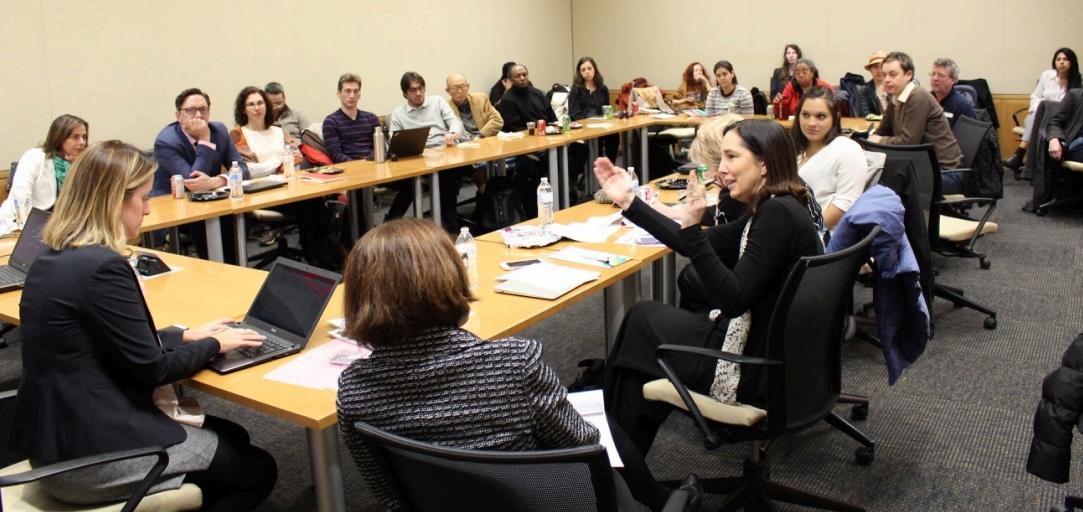












Beyond the value of the research projects themselves, the Fund has played a vital role in expanding and nurturing the broader HarvardBrazil community, both at Harvard and across Brazil.
In 2006, with the support of a generous gift from the Lemann Foundation, the David Rockefeller Center for Latin American Studies at Harvard University established the Brazil Office and launched the Brazil Studies Program. The Office and Program work in tandem to expand research, teaching, and educational opportunities for Harvard faculty and students across the University. Most activities are collaborative in nature, connecting Harvard students and scholars with counterparts in Brazil. (��Learn more)

The Brazil Office and Brazil Studies Program develop and implement a wide range of strategies and activities that engage both institutional and individual collaborators–including faculty, researchers, fellows, students, alumni, and advisors–across Harvard and Brazil. By facilitating the exchange of people, information, and ideas across networks and borders, the Office and Program help foster a thriving Harvard-Brazil ecosystem.
Since its inception in 2016, the Lemann Brazil Research Fund has played a central role in enhancing Harvard's engagement with Brazil. By fostering meaningful academic exchange and collaboration, the Fund has significantly strengthened a dynamic ecosystem of faculty, students, researchers, alumni, thought leaders, changemakers, and institutional partners working across disciplines, sectors, and geographies. The Fund´s impact is evident across multiple dimensions, including:
Expansion of Academic Networks: Broadened the pool of scholars and thought leaders involved in Brazil-related research and collaboration.
Support for Researcher Mobility: Enabled Brazilian researchers to spend time at Harvard and Harvard faculty and students to conduct research in Brazil.
Development of Brazil-Specific Expertise: Deepened the understanding of Brazilian issues across disciplines within the Harvard community.
Increased Faculty Engagement: Created stronger incentives for Harvard faculty to participate in Brazilfocused events and initiatives.
Empowerment of Brazilian Scholars: Supported Brazilian students and researchers at Harvard in pursuing projects centered on their country.
Strengthening of Alumni Networks: Enhanced efforts to connect and mobilize the Harvard alumni community in Brazil through targeted engagement strategies.
Dissemination of Research and Knowledge: Promoted the sharing of findings and knowledge through public events, media platforms, and academic forums.
Attraction of Co-investment: Leveraged additional funding and institutional partnerships to support collaborative research and exchange.
Together these efforts have amplified Harvard’s presence in Brazil and cultivated a more vibrant and reciprocal relationship–one rooted in a shared commitment to research, learning, and innovation.
Helena Monteiro Executive Director
Brazil Office
David Rockefeller Center for Latin American Studies
Research universities like Harvard are driven by inquiry and innovation. By encouraging a diverse and distinguished group of faculty to collaborate with Brazil, the LBRF has redefined the role and impact of the Brazil Office We now serve as a strategic hub for faculty seeking partnerships, funding, and meaningful international engagement These relationships often extend far beyond the initial grant regardless of whether funding is awarded and frequently attract additional support. Our Office systematically leverages these academic collaborations to deepen Harvard’s engagement with Brazil, strengthen its presence in the region, and broaden the scope and influence of our work.“
Scott Edwards lectures at Camp 41, located deep in the rainforest a few hours from Manaus, as part of the Harvard Amazon Rainforest Immersion program.
Catherine Snow presents on language and literacy development at a fully packed seminar in São Paulo organized by the Harvard DRCLAS Brazil Office in collaboration with local partners.
David Williams poses with participants of the Executive Leadership Program in Early Childhood Development after delivering a presentation that received a standing ovation.
Katherine Merseth and Brazil Office Fellow Ashley Collins meet with Renan Ferreirinha in Rio de Janeiro. A former student of Professor Merseth, Ferreirinha began serving as the secretary of education for the city of Rio de Janeiro in 2021
Nadine Gaab meets with researchers and practitioners working with learning disabilities and language and literacy development at the Harvard Brazil Office following a public symposium in Brasília.
Meredith Rowe shares her expertise on how parent-child interactions influence language development and later literacy during a Harvard-Brazil Dialogue held in Brazil.
Naomi Pierce meets former Loeb Fellow Washington Farjardo at the event “Harvard Brazil Collaboration: Working Together to Advance Knowledge and Education” held at the Museu do Amanhã in Rio de Janeiro.
Networking and Community Building
Summary of academic paper from the project “Building the Evidence Base for PatientCentered Long COVID Healthcare Administration and Policy: A Mixed Methods Study of Needs, Barriers, and Opportunities in Rio de Janeiro,” published on the Brazilian media platform Nexo Políticas Públicas
Brazilian Visiting Scholars and Researchers at Harvard
LEMANN BRAZIL RESEARCH FUND ESTABLISHED PANDEMIC
BRAZIL OFFICE AND BRAZIL STUDIES PROGRAM ESTABLISHED
Source: Harvard International Office
Harvard Publications in U.S. Journals with Brazilian Coauthors
LEMANN BRAZIL RESEARCH FUND ESTABLISHED
BRAZIL OFFICE AND BRAZIL STUDIES PROGRAM ESTABLISHED
Source: Web of Science
Percentage of Publications in U.S. Journals featuring Brazilian Coauthors
BRAZIL OFFICE AND BRAZIL STUDIES PROGRAM ESTABLISHED
LEMANN BRAZIL RESEARCH FUND ESTABLISHED
Source: Web of Science
Harvard’s Percentage Share of Publications in U.S. Journals
BRAZIL OFFICE AND BRAZIL STUDIES PROGRAM ESTABLISHED
Source: Web of Science
LEMANN BRAZIL RESEARCH FUND ESTABLISHED












In addition to the researchers and teams who have collaborated on proposals and awarded projects, the following offices and individuals at Harvard University deserve recognition for the success of the Lemann Brazil Research Fund from 2016 to 2025:
Members of the Faculty Review Committee
Bruno Carvalho
Marcia Castro
Mark Elliott
Brian Farrell
Frances Hagopian
Steven Levitsky
Scott Mainwaring
Scot Martin
Richard McCullough
Naomi Pierce
John Shaw
Judith Singer
Staff of the Office of the Vice Provost for Research
Autumn Bennet
Liza Harsch (LBRF Administrator)
William Lensch
Brooke Pullitzer
Staff of the Office of the Vice Provost for International Affairs
Emily Albrecht
Jessica McCann
Shaira Kochubaeva












Staff of the Brazil Office and Brazil Studies Program, David Rockefeller Center for Latin American Studies
Sol Carbonell
Helena Monteiro
Tim Linden
Camilla Roberts
Breno Carvalho
Tiago Genoveze
Maria Lidiane Rodrigues
Elizabeth Vasconcellos e Silva (Fellow)
Luis Jimenez-Ramirez (Fellow)
Staff of the University Development Office
Susan Lyons
Piper McInall
Elle Stevens
Harvard University is deeply grateful to the Lemann Foundation for its generous financial support and invaluable thought partnership over the past decade. Its sustained investment has been instrumental in enabling a decade of impactful research and learning.
Lemann Foundation Representatives
Daniel de Bonis
David Boyd
Nathalia Bustamante
Naomi Escobar
Renata Ferraz
Jorge Paulo Lemann
Susanna Lemann
Denis Mizne
Camila Pereira
Henrique Pimentel
Anna Laura Schmidt
2016
2016
Assessing the Impact of Socio-Emotional Learning Programming in Brazil ↪Page 50
2016
Estimation of the Social and Economic Burdens of Dengue and Zika Virus in Brazil: a Public Policy Tool
↪Page 78
From Research to Policy: Improving Municipal Policymaking in Brazil
↪Page 132
2016 Globalization and Organizational Change: Evidence from Brazil ↪Page 138
2016
2016
Machine Learning to Estimate Life Expectancy by Race in Brazil: Challenges for a MultiRacial Future ↪Page 82
Prioritizing Biodiversity of Birds and Butterflies in Cerrado Habitats of Brazil Using Geographic and Phylogenetic Information Systems
↪Page 116
Dana C McCoy (Harvard Graduate School of Education); Vladimir Ponczek and Cristine Campos de Xavier Pinto (Fundação Getúlio Vargas); Ana Luiza Raggio Colagrossi (Instituto Vila Educação)
Marcia Castro and Mary E Wilson (Harvard T H Chan School of Public Health); Monica Viegas Andrade (Universidade Federal de Minas Gerais); Cláudio José Struchiner (Universidade do Estado do Rio de Janeiro and Fundação Oswaldo Cruz); Sarah F McGough and Benjamin MacCormack-Gelles (Harvard T H Chan School of Public Health); Lucas Resende de Carvalho and Julia Almeida Calazans (Universidade Federal de Minas Gerais)
Gautam Rao and Diana Moreira (Harvard Faculty of Arts & Sciences); Jonas Hjort (Columbia University)
Laura Alfaro (Harvard Business School); Maggie X Chen (George Washington University); Andrea Lucchesi (Universidade de São Paulo); Naercio A Menezes Filho (Universidade de São Paulo and Insper); Monika Schnitzer (University of Munich); Alison Oliveira (Universidade de São Paulo and Insper); Leandro Justino Pereira Veloso (Universidade Federal do Rio de Janeiro)
Ichiro Kawachi (Harvard T H Chan School of Public Health); Alexandre Dias Porto Chiavegatto Filho (Universidade de São Paulo)
Scott V. Edwards and Naomi Pierce (Harvard Faculty of Arts & Sciences); Cristina Miyaki (Universidade de São Paulo)
2016
2017
2017
Proposal
The Learning for All Project
↪Page 46
Assessing the Impact of Socio-Emotional Learning Programming in Brazil: A Follow-Up Study
↪Page 50
Early Literacy Prediction and Reading Intervention for Preschoolers from Low-Income Families in Natal, Rio Grande do Norte, Brazil
↪Page 44
2017
2017
Identifying Approaches to Reduce Disparities in TB Diagnosis and Care in Brazil
↪Page 80
Teacher Incentives and Socialization
↪Page 60
2017
2017
The Black Earth and Radial Villages of Acre, Brazil: Explorations of a Continent-Wide Landscape Paradigm
↪Page 144
Teaching Teachers to Teach: Investigating Pedagogies and Practices to Improve Teacher Education in Brazil
↪Page 58
Primary
Paola Uccelli, Felipe Barrera-Osorio and Sarah Dryden-Peterson (Harvard Graduate School of Education); Beatriz Cardoso (Laboratório da Educação)
Dana C. McCoy (Harvard Graduate School of Education); Vladimir Ponczek and Cristine Campos de Xavier Pinto (Fundação Getúlio Vargas); Ana Luiza Raggio Colagrossi (Instituto Vila Educação)
Meredith Rowe (Harvard Graduate School of Education); Gigi Luk (Harvard Graduate School of Education); Cíntia Alves Salgado Azoni (Universidade Federal do Rio Grande do Norte); Nadine Gaab (Boston Children’s Hospital); Charles Haynes (Massachusetts General Hospital)
Nicholas Menzies and Marcia Castro (Harvard T H Chan School of Public Health); Daniele Maria Pelissari (Universidade de São Paulo); Patricia Bartholomay Oliveira (Ministério da Saúde do Brasil); Ethel Maciel and Carolina Maia Martins Sales (Universidade Federal do Espírito Santo); Theodore Cohen (Yale University); Adelmo Bertolde (Universidade Federal do Espírito Santo); Denise Arakaki (Ministério da Saúde do Brasil); Mauro Sanchez (Universidade de Brasília)
Emmerich Davies (Harvard Graduate School of Education); Fernando Luiz Abrucio (Fundação Getúlio Vargas); Leslie Finger (Harvard Faculty of Arts & Sciences)
Gary Urton (Harvard Faculty of Arts & Sciences); Eduardo Goes Neves (Universidade de São Paulo)
Katherine K Merseth (Harvard Graduate School of Education); Gabriela Miranda Moriconi (Fundação Carlos Chagas)
Year
2018
2018
A Preschool Intervention in Brazil to Enhance Poor Children’s School
Readiness
↪Page 40
Bridging Electrical Engineering and Machine Learning Education in Brazil
↪Page 62
2018 Early Institutionalization Intervention Impact Project
↪Page 68
2018 Improving Literacy Outcomes in Brazil by Expanding Teachers’ Instructional Repertoires
↪Page 48
2018
Overcoming Barriers to Adoption of Effective Municipal Policies
↪Page 132
2018
2018
Parent-Child Interaction and Child Language Development in LowIncome Families in Brazil
↪Page 70
SEL Kernels for Brazil ECE: A Low-Cost, EvidenceBased, and Scalable Approach to Social and Emotional Learning (SEL) in Brazilian Early Childhood Settings
↪Page 42
Primary
Elizabeth Spelke (Harvard Faculty of Arts & Sciences); Chrissie Ferreira de Carvalho and Nara Cortes Andrade (Universidade Católica do Salvador); José Neander Silva Abreu (Universidade Federal da Bahia)
Flavio Calmon (Harvard John A. Paulson School of Engineering and Applied Sciences); José Cândido Silveira Santos Filho (Universidade Estadual de Campinas)
Charles Nelson (Harvard Medical School and Harvard Graduate School of Education); Nathan A Fox, (University of Maryland); Charles H Zeanah (Tulane University School of Medicine); Edson Amaro Jr (Instituto PENSI)
Catherine Snow (Harvard Graduate School of Education); Renan de Almeida Sargiani (Universidade de São Paulo)
Gautam Rao (Harvard Faculty of Arts & Sciences); Jonas Hjort (Columbia University); Diana Moreira (University of California, Davis); Juan Francisco Santini (Pontifícia Universidade Católica do Rio de Janeiro)
Meredith Rowe (Harvard Graduate School of Education); Guilherme Vanoni Polanczyk (Universidade de São Paulo)
Stephanie Jones and Dana McCoy (Harvard Graduate School of Education); Alexandra Brentani (Faculdade de Medicina da Universidade de São Paulo); Rebecca Bailey and Jennifer Kahn (Harvard Graduate School of Education); Ana Luiza Raggio Colagrossi (Faculdade de Medicina da Universidade de São Paulo)
2019
2019
Aprender a Estudar: Supporting Fourth-Grade Teachers to Prepare Lifelong Readers and Learners ↪Page 46
Does Zika Infection Accelerate Neuronal Aging and Death: Novel Aging Clocks to Monitor the Earlier Onset of Pathologies of the Nervous Systems
↪Page 92
2019
2019
Identifying T Cell Epitopes in Plasmodium Vivax ↪Page 94
Paola Uccelli (Harvard Graduate School of Education); Beatriz Cardoso and Nicole Paulet (Laboratório da Educação); Daniel Domingues Dos Santos (Universidade de São Paulo, Ribeirão Preto)
2019
Preparing Brazilian Engineering Students for the Data-Driven Economy ↪Page 62
Records of Ancient Rainfall from Cave Deposits: A Combined Research Campaign and Field Course ↪Page 146
Bernardo Lemos (Harvard T H Chan School of Public Health); Raquel da Hora Barbosa (Universidade Federal Fluminense)
Judy Lieberman (Harvard Medical School); Caroline Junqueira (Fundação Oswaldo Cruz - Instituto René Rachou)
Flavio Calmon (Harvard John A Paulson School of Engineering and Applied Sciences); José Cândido Silveira Santos Filho (Universidade Estadual de Campinas)
Roger Fu (Harvard Faculty of Arts & Sciences); Ricardo Ivan Trindade (Universidade de São Paulo)
2019
2019
Tackling Stereotypes to Encourage Brazilian Math Talent ↪Page 56
Testing the Impact of a Low-Cost, Evidence-Based, and Scalable Approach to Social and Emotional Learning (SEL) in Brazilian Early Childhood Settings ↪Page 42
Michela Carlana (Harvard Kennedy School); Raissa Rabregas (University of Texas at Austin); Diana Moreira (University of California, Davis); Felipe C R Lima (Universidade de São Paulo)
Dana McCoy and Stephanie Jones (Harvard Graduate School of Education); Alexandra Brentani (Universidade de São Paulo); Ana Luiza Raggio Colagrossi (Instituto D'Or de Pesquisa e Ensino); Rebecca Bailey, Jennifer Kahn and Sonya Temko (Harvard Graduate School of Education)
2020
2020
An Evidence Game-Based Intervention to Enhance Social-Emotional Skills in Context of Adversity in Brazil: A Comprehensive Approach for Typical Children and Children with Autism ↪Page 40
Assessment of Public Acceptance of a Hypothetical Dengue Vaccine and the Potential Impact on Individual VectorControl Behavior
↪Page 84
2020
2020
Estimating the Recovery of Trees’ Evolutionary Potential from PreColumbian Agriculture to Improve Tropical Forest Restoration ↪Page 118
Sea Level Change in Brazil: Analyzing the Past, Projecting the Future, and Training Future Generations of Brazilian Scientists in the Use of Sea Level Modeling Tools
↪Page 114
2020
2021
The Development, Implementation, and Evaluation of an Early Language Development Parenting Program for Social Assistance Community Centers in Brazil
↪Page 72
Utilizing Brazil’s Fossil Record to Illuminate Earth’s Greatest Mass Extinction and Its Link to Modern Climate Change
↪Page 120
Jesse Snedeker and Elizabeth Spelke (Harvard Faculty of Arts & Sciences); Chrissie Ferreira de Carvalho (Universidade Federal de Santa Catarina); Nara Côrtes Andrade (Universidade Católica do Salvador)
Marcia Castro (Harvard T.H. Chan School of Public Health); Márcia Maria Tavares Machado (Universidade Federal do Ceará); Lucas Chaves Netto (Faculdade de Medicina da Universidade de São Paulo); Antonio Silva Lima Neto (Secretaria Municipal de Saúde de Fortaleza); Alessandra Carvalho and Juan Pablo Aguilar Ticona (Universidade Federal da Bahia); Luciano de Paula Camilo (Universidade de Brasilia); Sana Haider and Sun Kim Hi (Harvard T.H. Chan School of Public Health)
David Moreno Mateos (Harvard Graduate School of Design); Charles Clement (Instituto Nacional de Pesquisas da Amazônia); Doriane Picanço-Rodrigues (Universidade Federal do Amazonas); Maria Imaculada Zucchi (Agência Paulista de Tecnologia dos Agronegócios)
Jerry Mitrovica (Harvard Faculty of Arts & Sciences); Rodolfo José Angulo (Universidade Federal do Paraná)
Meredith Rowe (Harvard Graduate School of Education); Flávio Cunha (Rice University); Guilherme Irffi (Universidade Federal do Ceará)
Stephanie Pierce (Harvard Faculty of Arts & Sciences); Felipe L Pinheiro (Universidade Federal do Pampa); Tiago R Simões (Harvard Faculty of Arts & Sciences); Paulo M Nascimento (Canal do Pirulla)
2021
2021
A Tale of Two Species: Understanding How Genetic Hybridization Can Amplify the Invasiveness of Major Agricultural Pests in Brazil ↪Page 122
2021
Effects of COVID-19 and Violence on the Work Process and Mental Health of Community Health Agents in Brazil ↪Page 86
2021
Eosinophils: Key Innate Immune Cells in SARSCoV-2 Infection
↪Page 96
Examining the Effects of COVID-19 Restrictions on Literacy Practices in a Child’s Home: A Global Survey Study
↪Page 74
2021
Primary
Naomi Pierce (Harvard Faculty of Arts & Sciences); Rodrigo Cogni (Universidade de São Paulo); Wendy A Valencia Montoya (Harvard Graduate School of Arts & Sciences)
Aisha Yousafzai (Harvard T.H. Chan School of Public Health); Anya Vieira-Meyer (Centro Universitário Christus); Ana Patrícia Pereira Morais (Universidade Estadual do Ceará and Fundação Oswaldo Cruz); José Maria Ximenes Guimarães (Rede Nordeste de Formação em Saúde da Família); Sidney Feitoza Farias (Fundação Oswaldo Cruz); Franklin Delano S Forte (Universidade Federal da Paraíba); Claudete Ferreira de Souza Monteiro (Universidade Federal do Piauí and Rede Nordeste de Formação em Saúde da Família); Maria de Fátima S Antero (Rede Nordeste de Formação em Saúde da Família); Maria Rosilene C Moreira and Milena Silva Costa (Universidade Federal do Cariri); Maristela Inês Osawa Vasconcelos (Universidade Estadual Vale do Acaraú)
Wendy Garrett (Harvard T H Chan School of Public Health); Rossana Melo (Universidade Federal de Juiz de Fora); Peter F Weller (Beth Israel Deaconess Hospital)
Nadine Gaab (Harvard Graduate School of Education); Júlia Beatriz Lopes-Silva (Universidade Federal de Minas Gerais); Cíntia Alves Salgado Azoni (Universidade Federal do Rio Grande do Norte)
2021
High Incidence of SARSCOV-2 in Ilhéus, Bahia: Biological or Epidemiological Risk Factors?
↪Page 94
Polluted River Breezes in Vulnerable Northern Brazil
↪Page 112
Judy Lieberman (Harvard Medical School); Caroline Junqueira (Instituto René Rachou - FIOCRUZ)
Scot Martin (Harvard John A. Paulson School of Engineering and Applied Sciences); Rodrigo Souza (Universidade do Estado do Amazonas)
Year
Proposal Title
2021 Using Big Data to Understand the Effects of COVID-19 on Anxiety, Depression Symptoms, and Suicidal Behaviors in Underserved Communities of Brazil: A View of the Pandemic from the Other Hemisphere ↪Page 88
2022
2022
Assessing the Prospective Role of Ultra-Processed Foods on AdiposityRelated Outcomes in Brazil ↪Page 90
Building a Fabrication Laboratory (FabLab) to Democratize Science and Education in Brazil ↪Page 64
2022 Building the Evidence Base for Patient-Centered Long COVID Healthcare Administration and Policy: A Mixed Methods Study of Needs, Barriers, and Opportunities in Rio de Janeiro ↪Page 98
2022
Primary Investigator, Co-Investigators and Collaborators
2022
SEL Kernels for Local Needs in Amazonas Region of Brazil ↪Page 42
Unlocking Data to Improve Decision-Making ↪Page 134
David Williams (Harvard T H Chan School of Public Health and Harvard Faculty of Arts & Sciences); Valdemir Ferreira-Junior (Universidade Federal de São Paulo); Todd G Reid (Harvard T H Chan School of Public Health); Alex Sandy Pentland (MIT Media Lab)
Xuehong Zhang and Edward Giovannucci (Harvard T H Chan School of Public Health); Maria Alvim Leite and Renata Bertazzi Levy (Universidade de São Paulo); Leandro F M Rezende (Universidade Federal de São Paulo)
Venkatesh Murthy (Harvard Faculty of Arts and Sciences); Grace S Pereira Moraes and Márcio F D Moraes (Universidade Federal de Minas Gerais)
Meredith Rosenthal and Emma-Louise Aveling (Harvard T.H. Chan School of Public Health); Claudia Cristina de Aguiar Pereira, Margareth C. Portela, Mônica Silva Martins and Sheyla Maria Lemos Lima (Escola Nacional de Saúde Pública - Fundação Oswaldo Cruz); Flora Cornish (London School of Economics & Political Science)
Stephanie Jones (Harvard Graduate School of Education); Rita Esther Ferreira de Luna (Universidade Federal do Amazonas); Ana Luiza Raggio Colagrossi (Instituto Sedes Sapientiae)
Asim Khwaja (Harvard Kennedy School); Marcia Castro (Harvard T H Chan School of Public Health); José Macedo and Márcia Maria Machado Tavares (Universidade Federal do Ceará)
Year
Proposal
2022
2023
Using Museum Specimens and Genomics to Reconstruct the Path to Endangerment of Brazil’s Rarest Birds ↪Page 126
Algorithmic Fairness in Brazilian Education ↪Page 54
2023
2023
How to Make Brazilian Cities Greener: Greening Cities Across Six Biomes ↪Page 127
Scott Edwards (Harvard Faculty of Arts and Sciences); Fabio Raposo do Amaral (Universidade Federal de São Paulo); Luís Fábio Silveira (Museu de Zoologia da Universidade de São Paulo)
2023
Shifting Political Terrain in Brazil’s New Republic: Place, Class, and Vote Choice ↪Page 136
Flavio Calmon (Harvard John A Paulson School of Engineering and Applied Sciences); Seiji Isotani (Universidade de São Paulo and Harvard Graduate School of Education); Ig Ibert Bittencourt (Universidade Federal do Alagoas and Harvard Graduate School of Education)
Gareth Doherty and Francesca Benedetto (Harvard Graduate School of Design); Bruno Carvalho (Harvard Faculty of Arts & Sciences); Washington Fajardo (Independent Scholar); Carlos Leite (Universidade Presbiteriana Mackenzie); Jorge Abrahao (Instituto Cidades Sustentáveis); Elena Geppetti (Pontifícia Universidade Católica do Rio de Janeiro)
Elizabeth McKenna (Harvard Kennedy School); Ana Rodrigues Cavalcanti Alves (Universidade Federal da Bahia); Rafael Cardoso Sampaio (Universidade Federal do Paraná); Claudio Tadeu Cristino (Universidade Federal Rural de Pernambuco); Esther Solano Gallego (Universidade Federal de São Paulo); Helena Lúcia Zagury Tourinho (Universidade Federal do Amazonas); Helena d’Agosto Miguel Fonseca (Universidade Federal de Minas Gerais); Luciano Muniz Abreu (Universidade Federal Rural do Rio de Janeiro); Matthew Richmond (London School of Economics and Political Science); Ricardo Paiva (Universidade Federal do Ceará); Sandra Catharinne Pantaleão Resende (Pontifícia Universidade Católica de Goiás); Sérgio Simoni Junior (Universidade Federal Rural do Rio Grande do Sul).
2023
Co-constructing Learning in the Classroom: The Influence of Venezuelan Migration on Brazilian and Venezuelan Children’s Experiences of Education in Boa Vista ↪Page 52
Tracking the Rise of the Earliest Animals During the Cambrian Explosion–a Brazilian Perspective from the Global South ↪Page 124
Gabrielle Oliveira (Harvard Graduate School of Education); Leila Baptaglin (Universidade Federal de Roraima)
Javier Ortega-Hernandez (Harvard Faculty of Arts & Sciences); Lucas Del Mouro (Universidade de São Paulo); Milene Freitas Figueiredo (Petrobras); Silane Silva Caminha (Universidade Federal de Mato Grosso); and Ezequiel Galvão (Universidade Federal do Pampa)
2024
2024
2024
2024
Proposal
Phylogenetics and Genomics of Wyeomyia Mosquito Adaptations to Different Breeding Sites in Brazil and Elsewhere ↪Page 128
Exploring the Effects of CaneStat, a Novel Hybrid Protein, on Oral Proteome Dynamics and Microbiome Composition
↪Page 100
The Contracting State: How Private Contractors Affect Public Policy and Political Parties in Brazil ↪Page 140
Dissecting Mechanisms of Cancer Caused by a DNA Mutation Prevalent in Brazilian Children ↪Page 102
Brian Farrell (Harvard Faculty of Arts & Sciences); Paulino Ribeiro (Harvard Museum of Comparative Zoology); Sangil Kim (Seoul National University)
Magda Feres and Eduardo H. de Souza (Harvard School of Dental Medicine); Marília Afonso Rabelo Buzalaf and Carolina Ruis Ferrari (Faculdade de Odontologia de Bauru da Universidade de São Paulo); Adriana Campos Passanezi Sant’Ana (Universidade de São Paulo); Flávio Henrique da Silva (Universidade Federal de São Carlos)
Alisha Holland (Harvard Faculty of Arts & Sciences); Fernando Limongi de Magalhaes (Escola de Economia de São Paulo, Fundação Getúlio Vargas); Jean Vilbert (Harvard Faculty of Arts & Sciences)
Adrian Salic (Harvard Medical School); Elvis Terci Valera and Carlos Alberto Scrideli (Universidade de São Paulo)
2024
2025
Characterizing the Bioavailability and Food Web Uptake of Mercury from Artisanal and SmallScale Gold Mining (ASGM) in the Brazilian Amazon ↪Page 110
Ecological and Sociodemographic Characteristics of Seroprevalence and Attack Rate of Oropouche Virus in Ceará, Brazil: A Statewide Seroepidemiological Survey ↪Page 107
Elsie Sunderland (Harvard Faculty of Arts & Sciences); Scot Martin (Harvard John A Paulson School of Engineering and Applied Sciences); Sergio Duvoision Júnior (Universidade do Estado do Amazonas)
Marcia Castro (Harvard T H Chan School of Public Health); Antonio Silva Lima Neto (Secretaria de Saúde do Ceará); Luciano Pamplona de Góes Cavalcanti (Universidade Federal do Ceará); Francisca Kalline de Almeida Barreto (Centro Universitário Christus)
2025
2025
Development of Statistical Methods to Evaluate the Impact of Bolsa Família on Mental Health Using the 100 Million Brazilian Cohort
↪Page 104
Cost-Effectiveness of Cervical Cancer Screening Strategies for High-Risk Remote Populations in Brazil
↪Page 103
Kosuke Imai (Harvard Faculty of Arts & Sciences); Vikram Patel (Harvard Medical School); Daiane Borges Machado and Flávia José Oliveira Alves (Centro de Integração de Dados e Conhecimentos para Saúde - Fundação Oswaldo Cruz and Harvard Medical School)
2025
2025
Advancing Science, Outreach, and Education: Exploring Brazil’s Biodiversity via Single-Cell Transcriptomics
↪Page 129
Bridging Divides: Can Public Policies Address Polarization and Misinformation in Brazil?
↪Page 141
2025 Increasing Vaccination Coverage in Brazil: Are We Moving Towards Equity? Investigating Barriers, Inequalities, and Scalable Solutions for Effective and Equitable Public Health
↪Page 106
2025 Computing Routes in Brazil Safely and Equitably
↪Page 105
Jane Kim and Nicole Campos (Harvard T H Chan School of Public Health); Aline Leal Gonçalves Creder Lopes (Ministério da Saúde do Brasil); Ana Ribeiro (Universidade Federal do Rio Grande do Norte); Katia Luz Torres Silva (Fundação Centro de Controle de Oncologia do Estado do Amazonas); Tainá Raiol and Carmem Phang Romero Casas (Centro de Desenvolvimento Tecnológico em SaúdeFundação Oswaldo Cruz); Flávia de Miranda Correa (Instituto Nacional de Câncer)
Marc Kirschner and Leon Peshkin (Harvard Medical School); José Garcia Abreu (Universidade Federal do Rio de Janeiro)
Paula Rettl (Harvard Business School); Nara Pavão (Universidade Federal de Pernambuco)
Sankaran Subramanian (Harvard T H Chan School of Public Health); Alexandra Crispim da Silva Boing and Antonio Fernando Boing (Universidade Federal de Santa Catarina); Lorena G Barberia (Universidade de São Paulo); Tatiane C. Moraes de Sousa (Universidade do Estado do Rio de Janeiro)
Fernanda Viegas, Martin Wattenberg, and Lena Armstrong (Harvard John A Paulson School of Engineering and Applied Sciences); Ana Cristina Bicharra Garcia (Universidade Federal do Estado do Rio de Janeiro)
10


